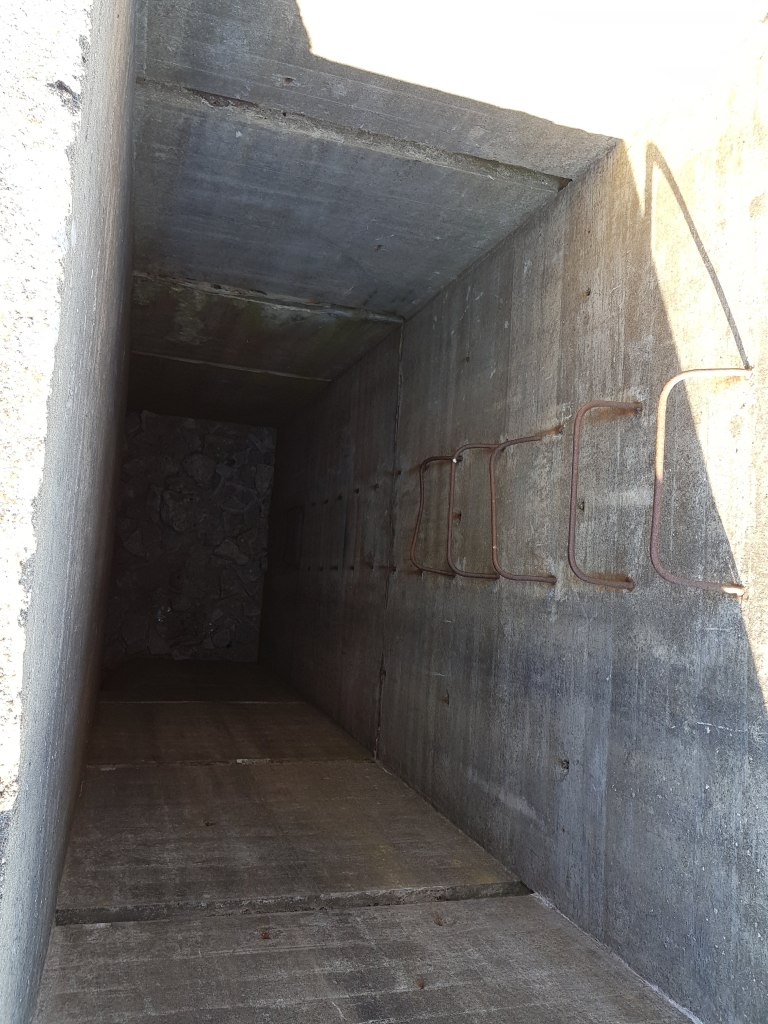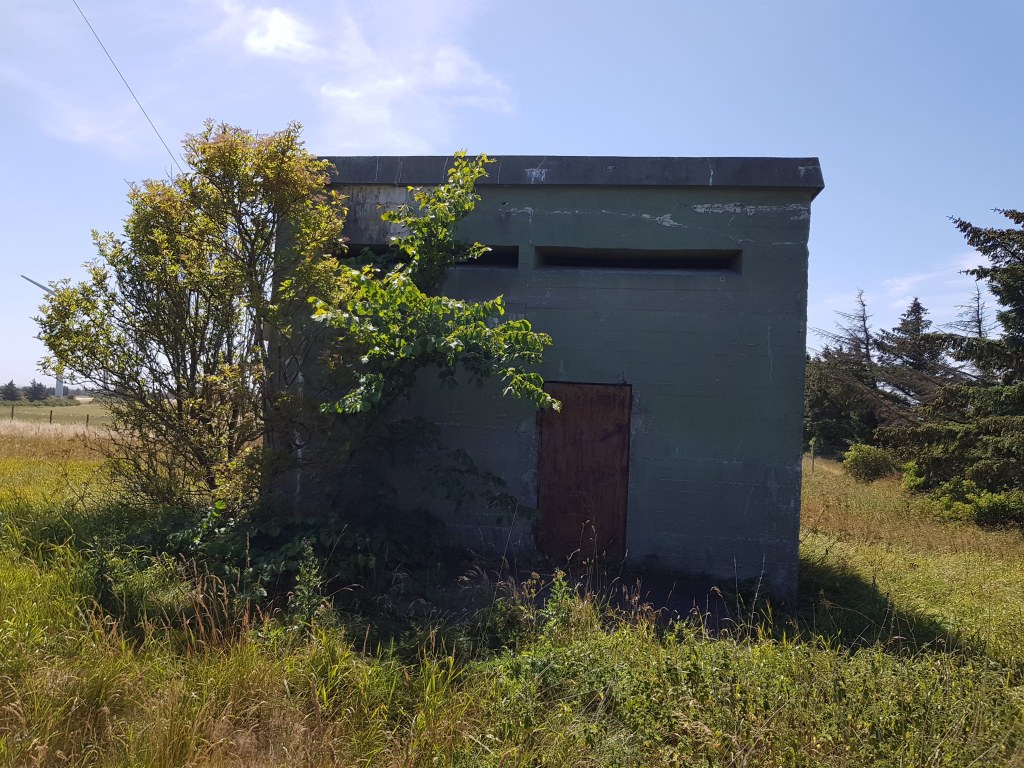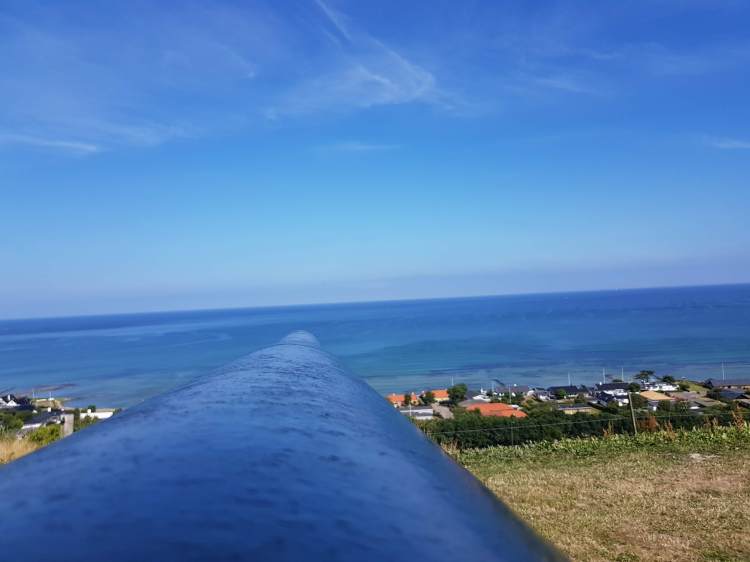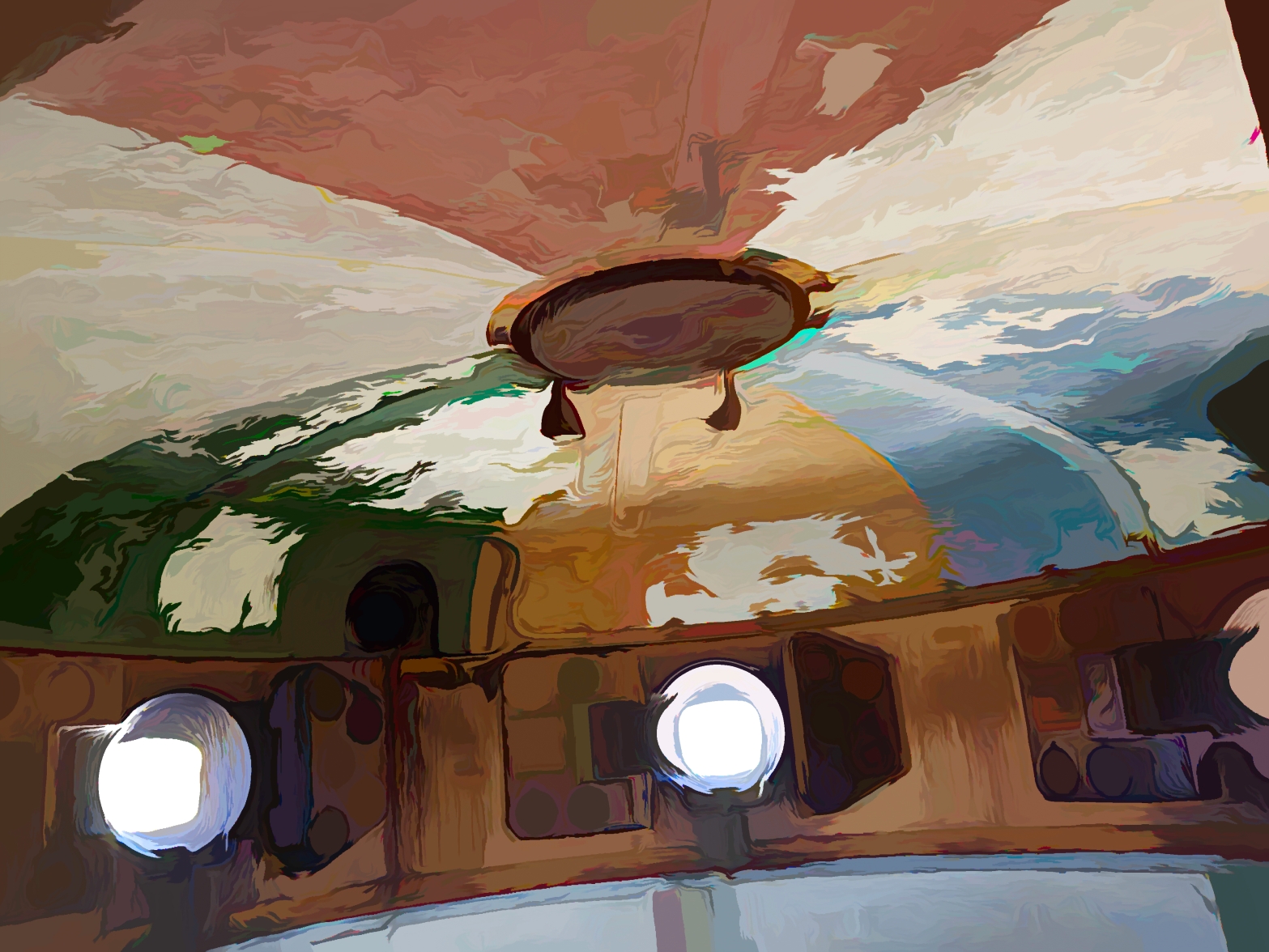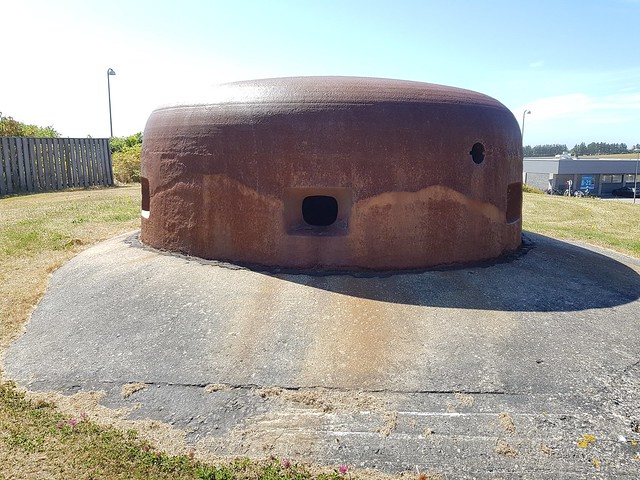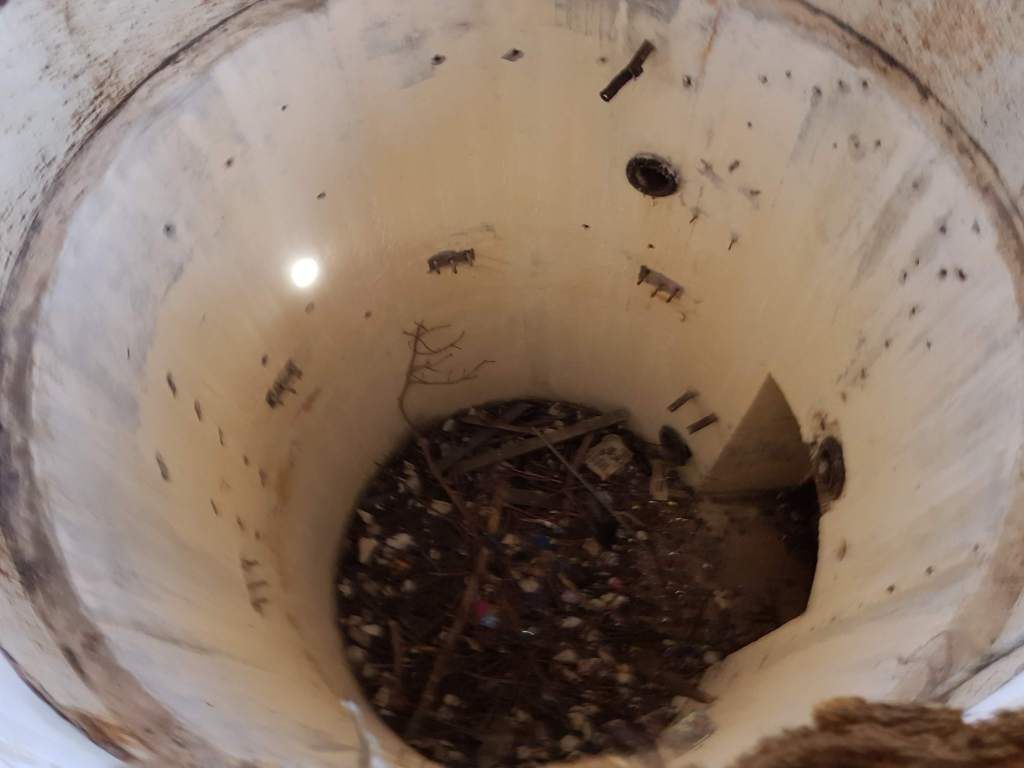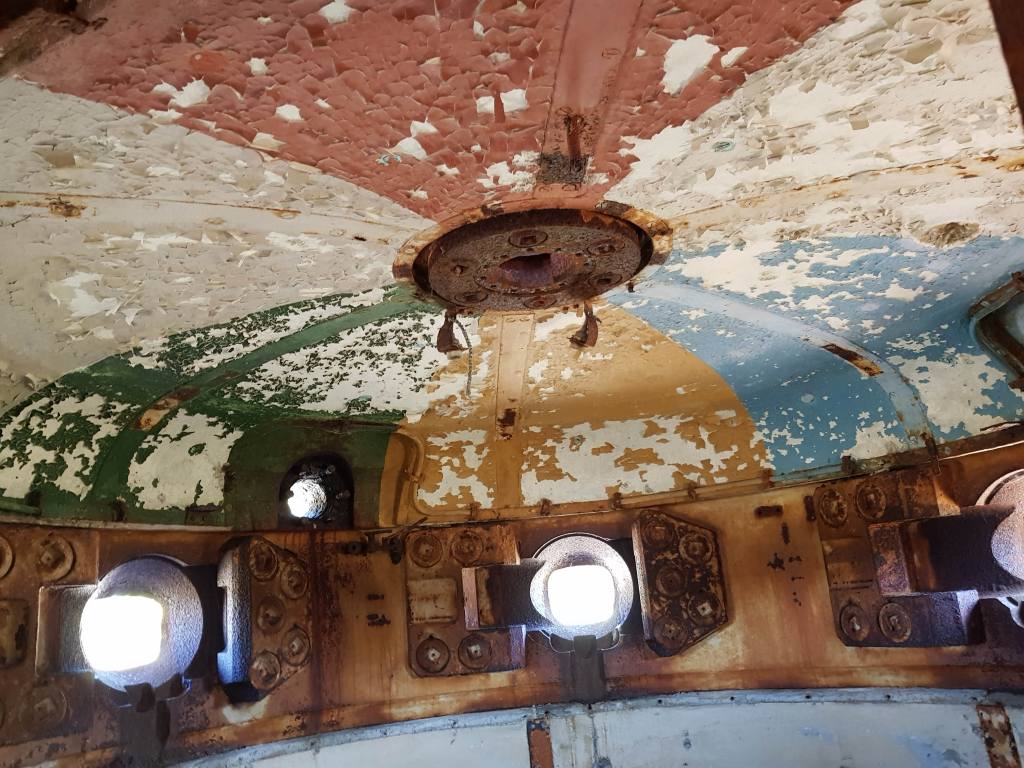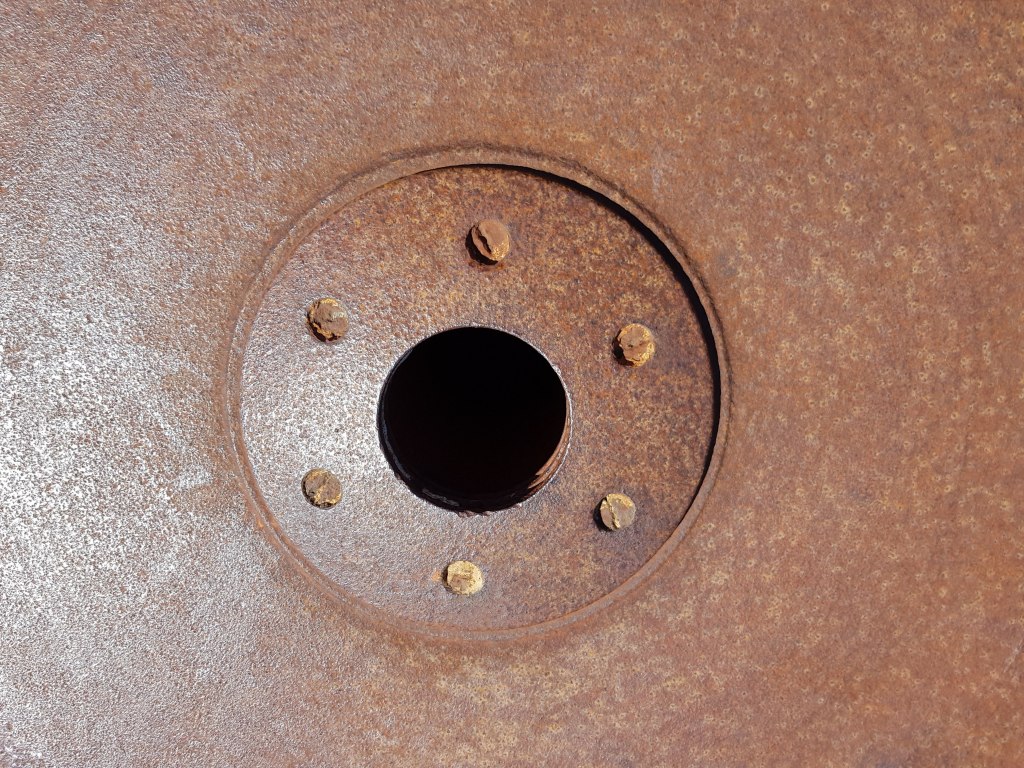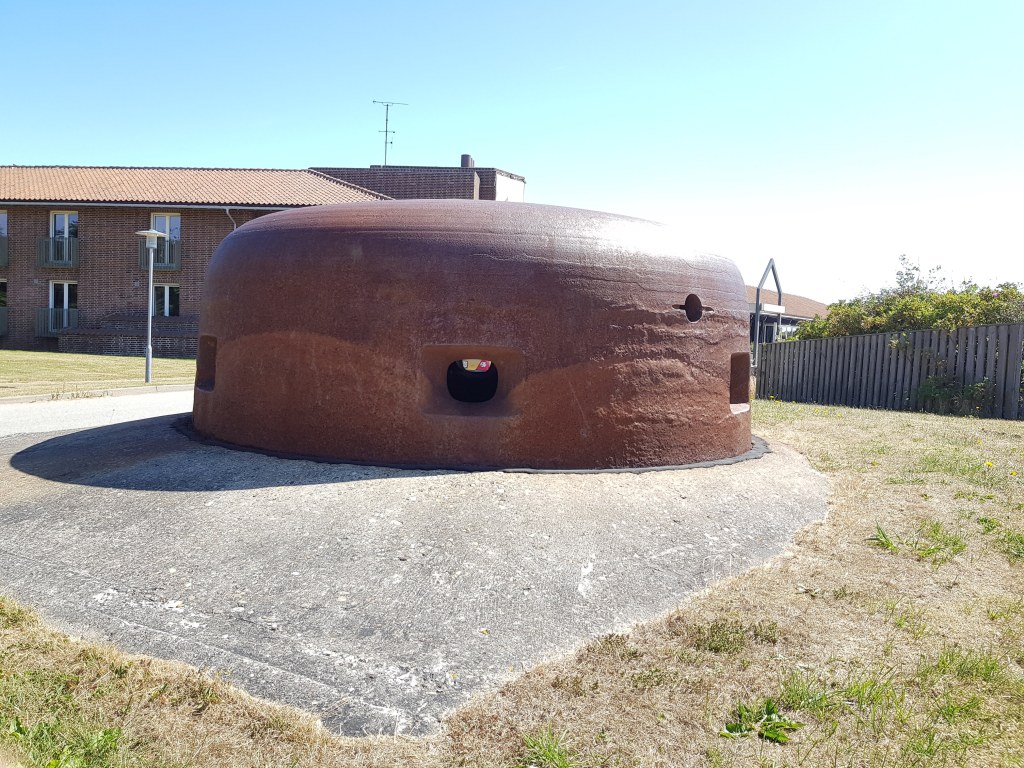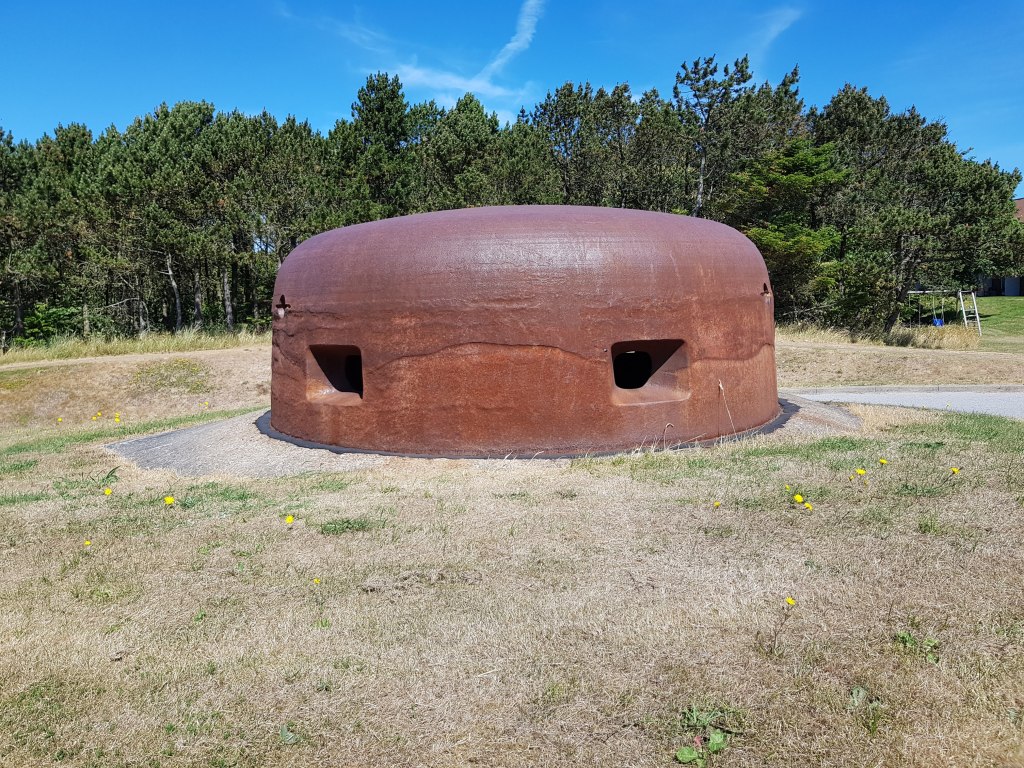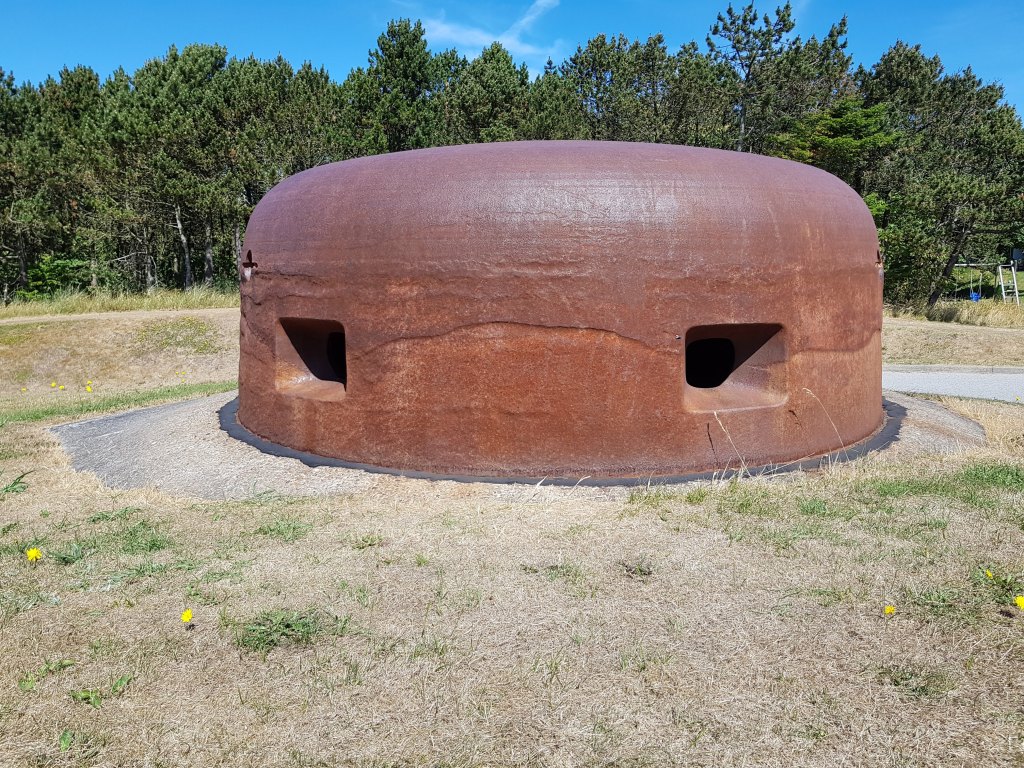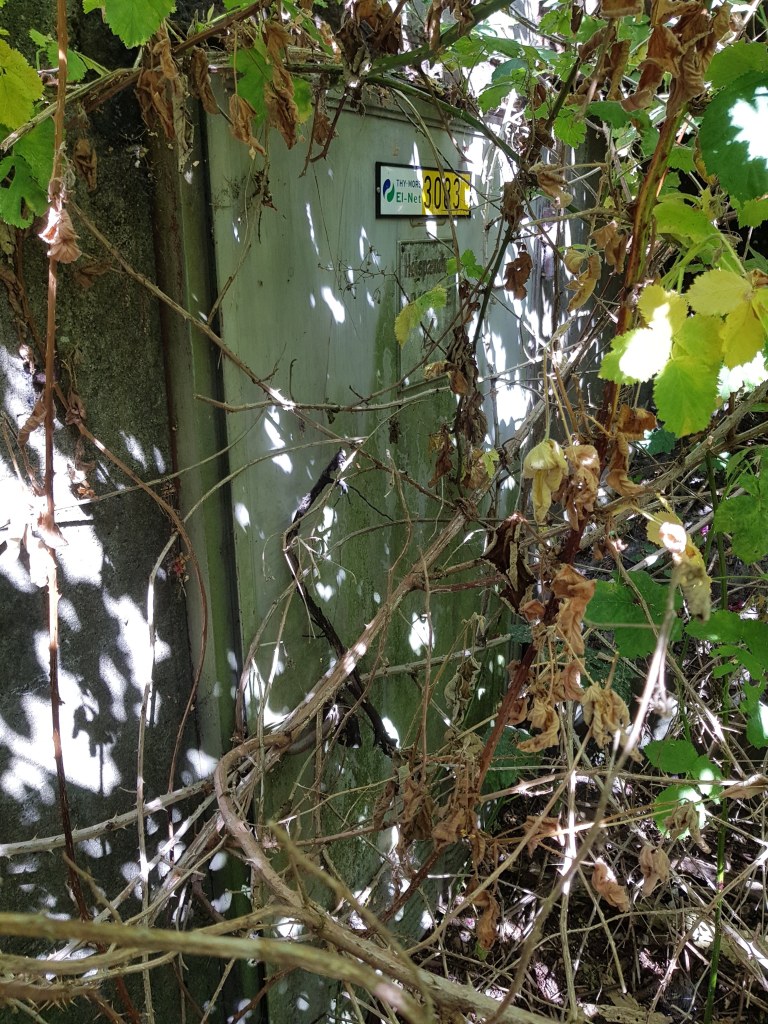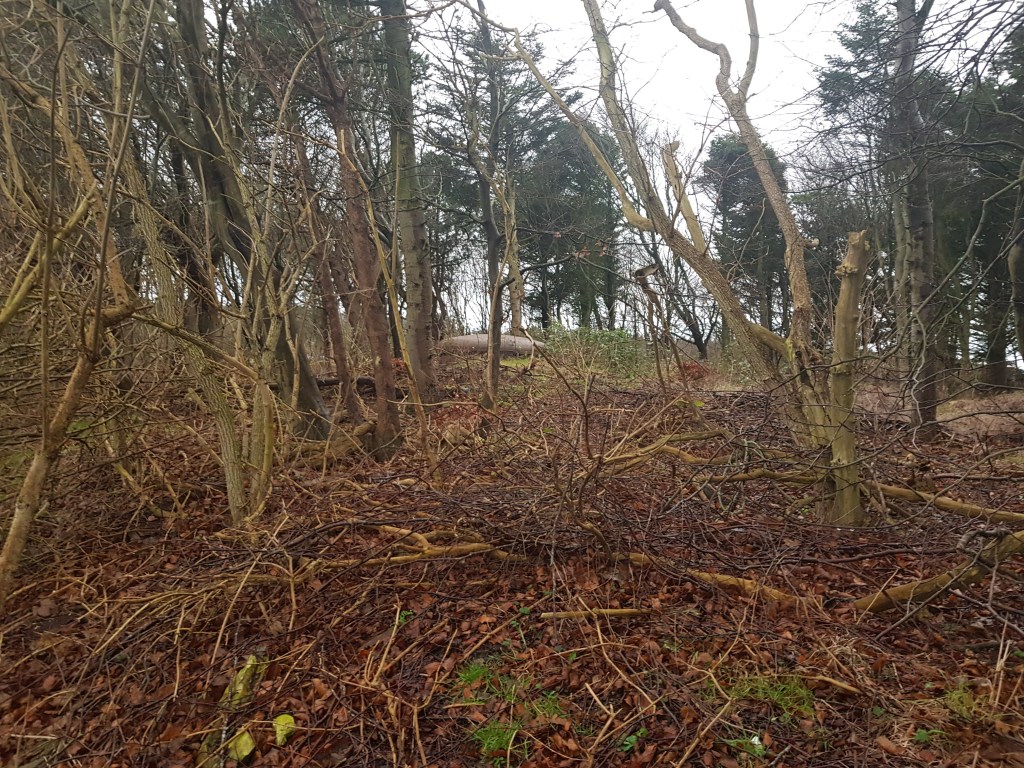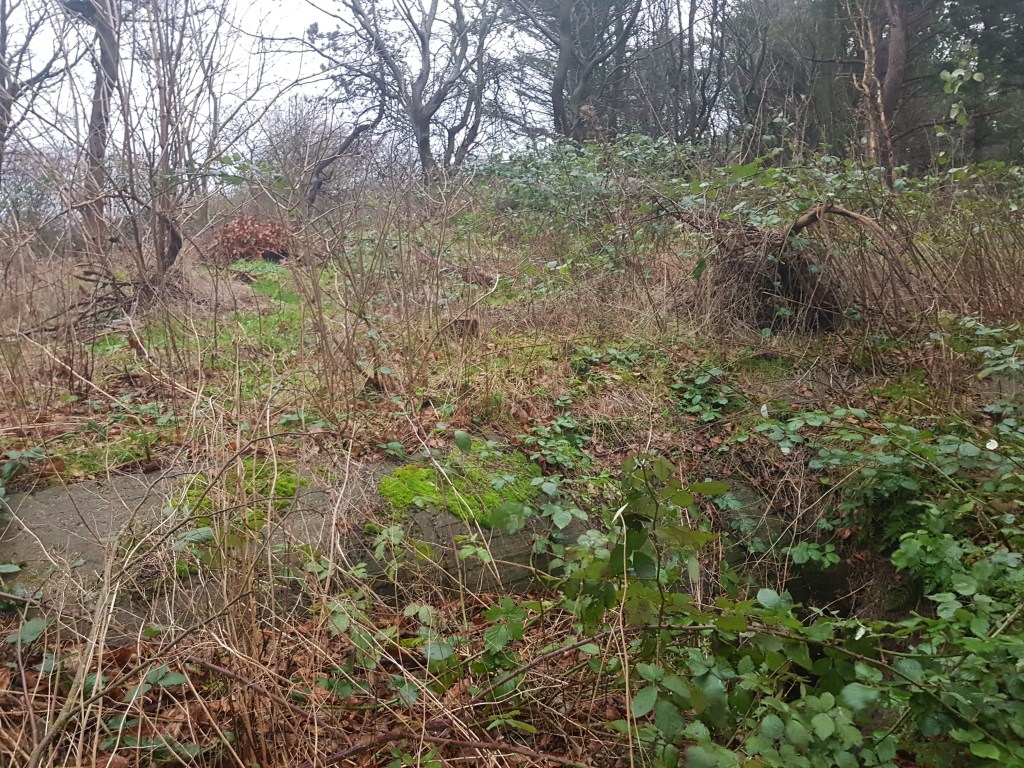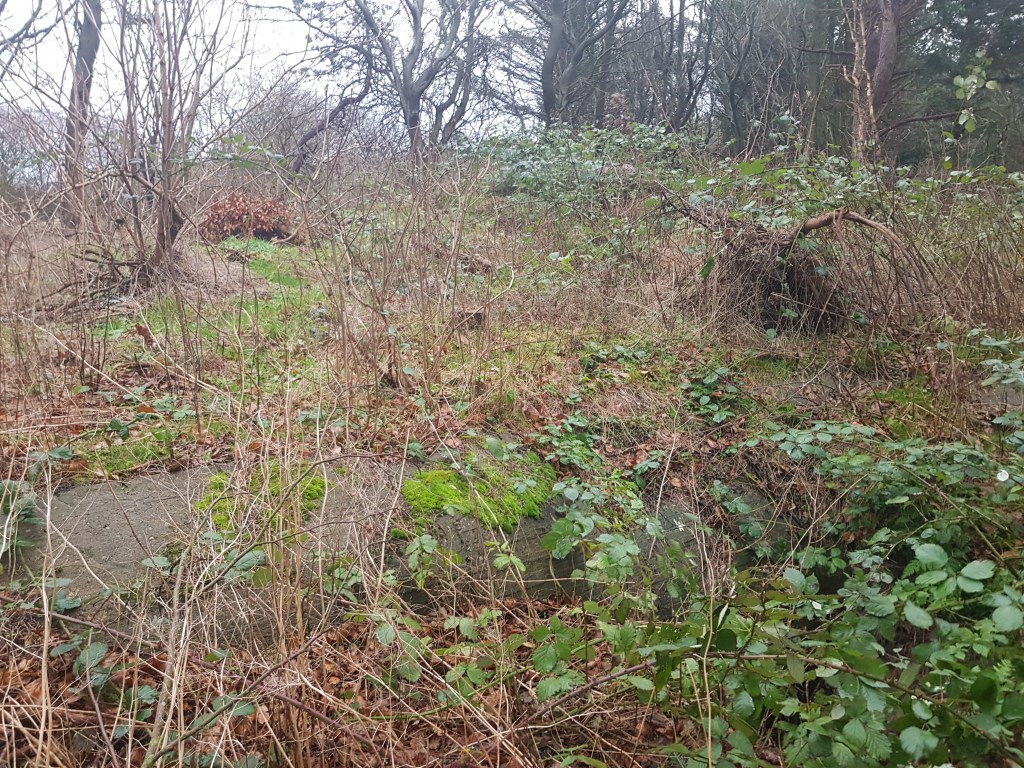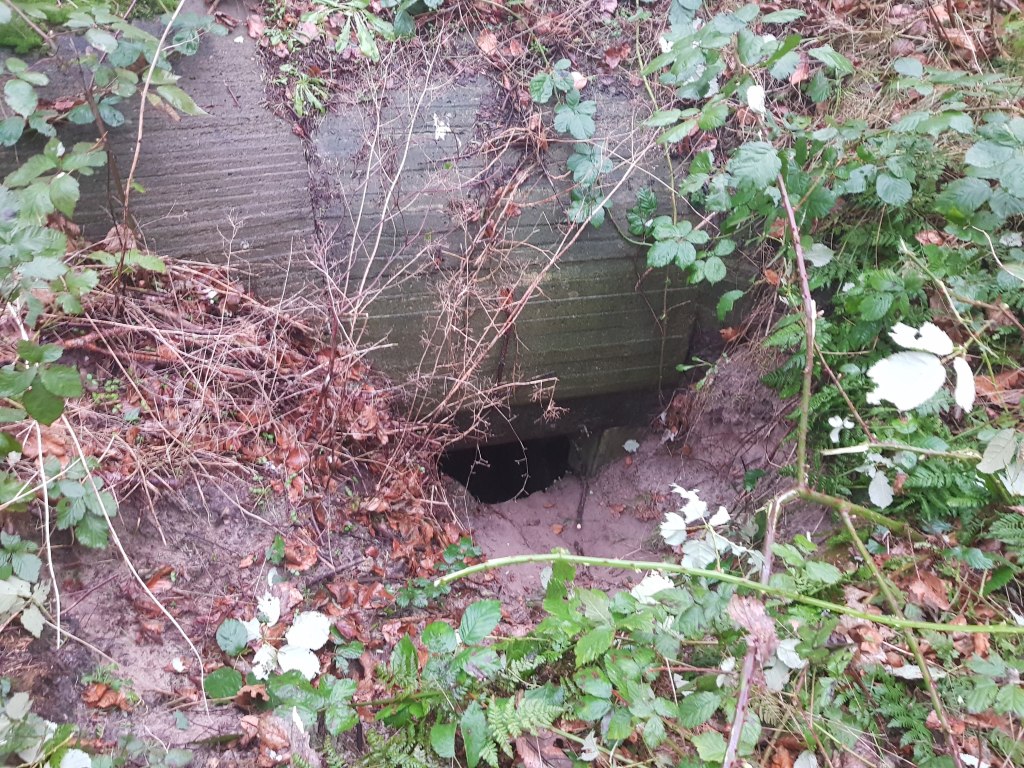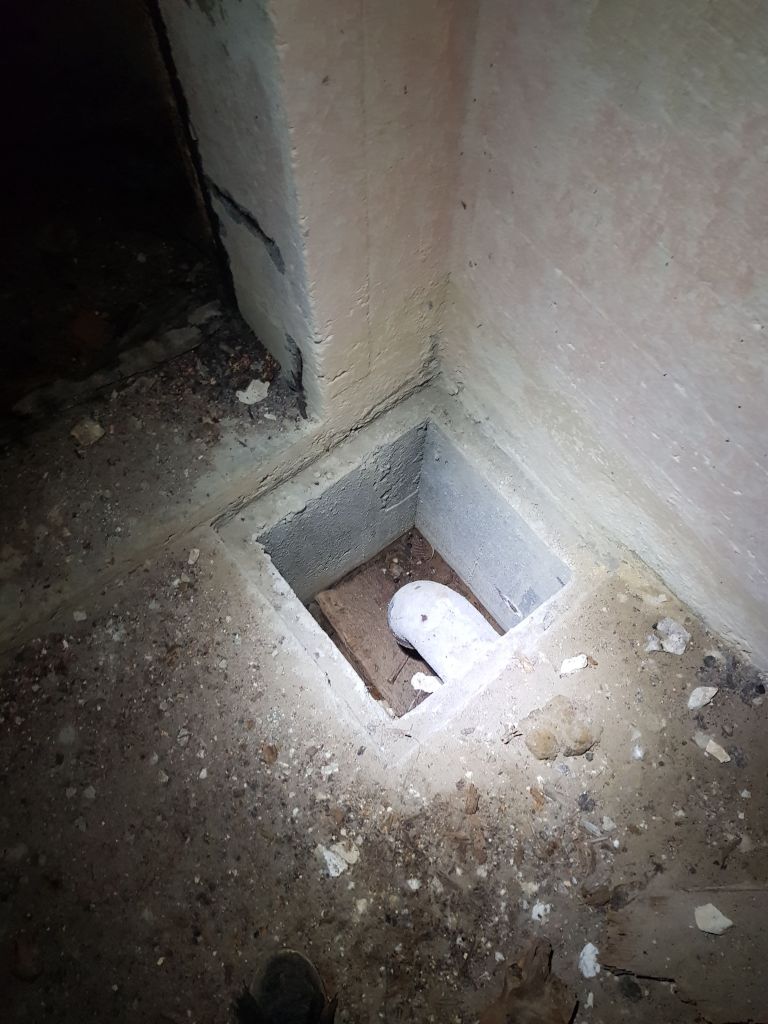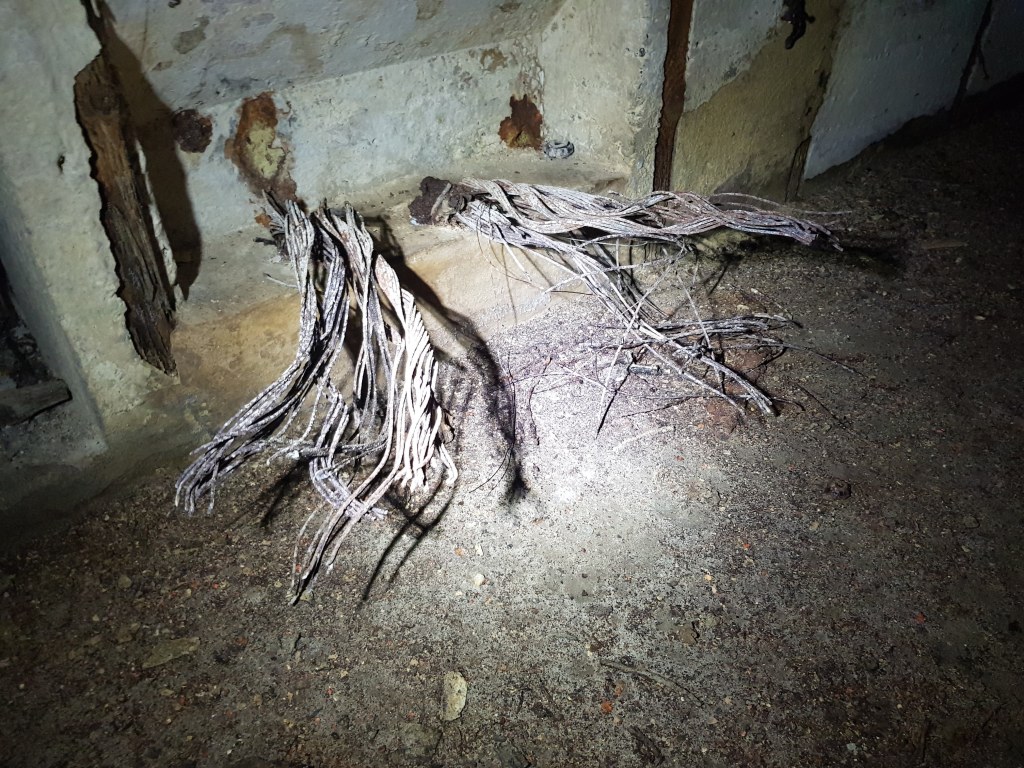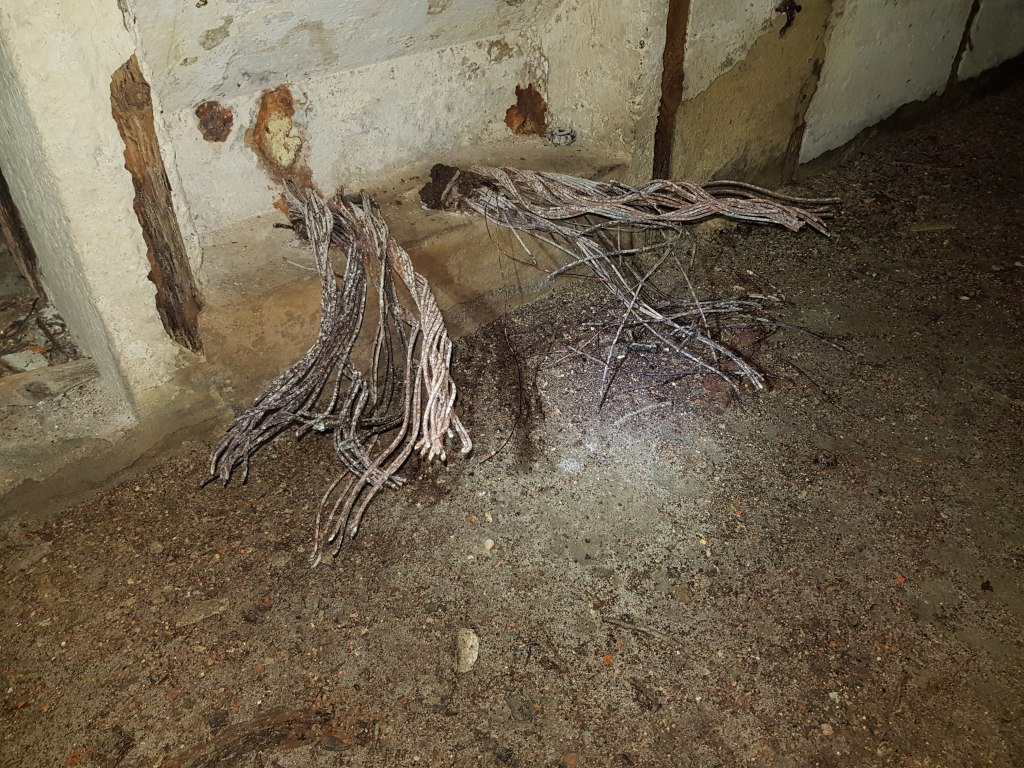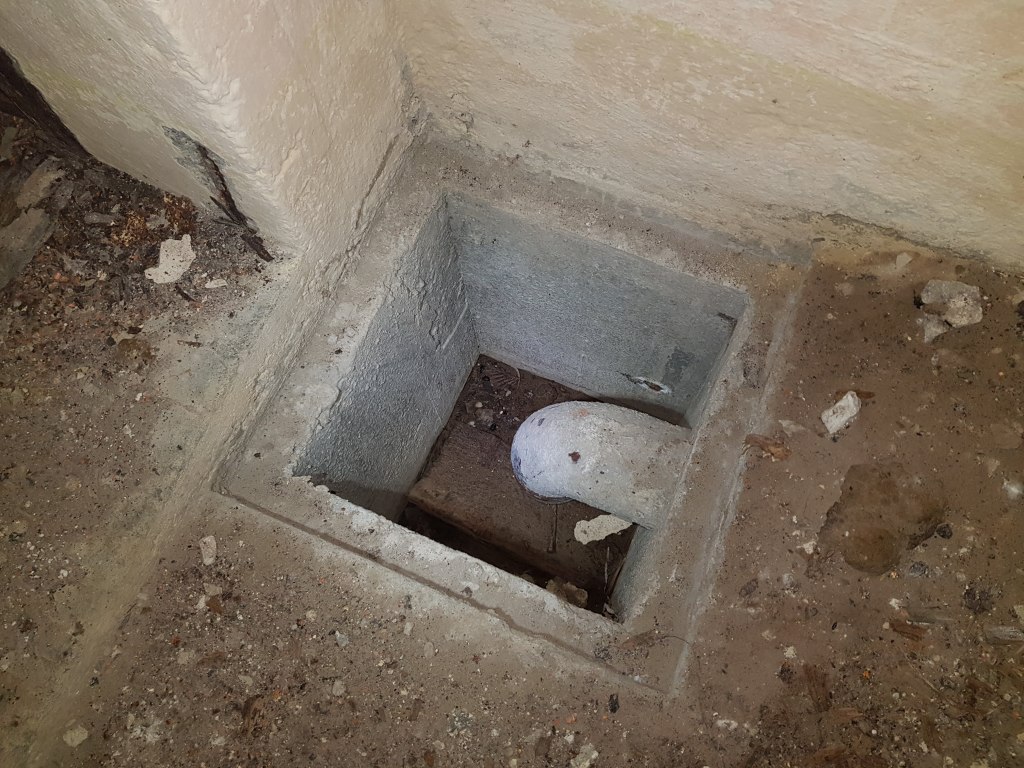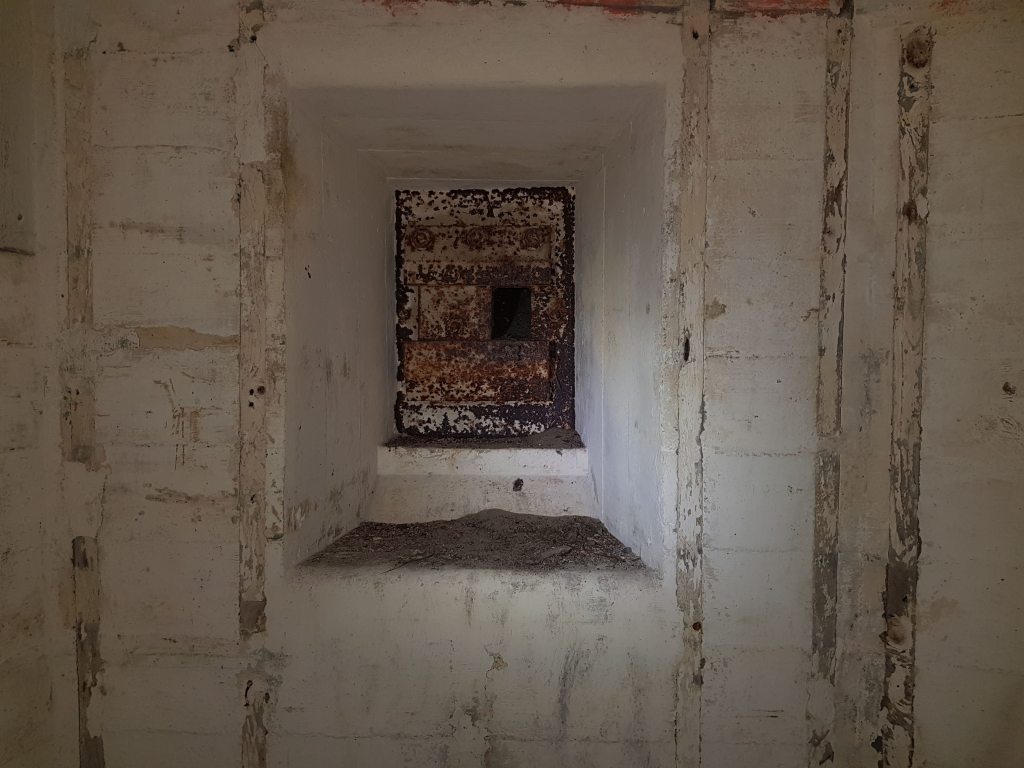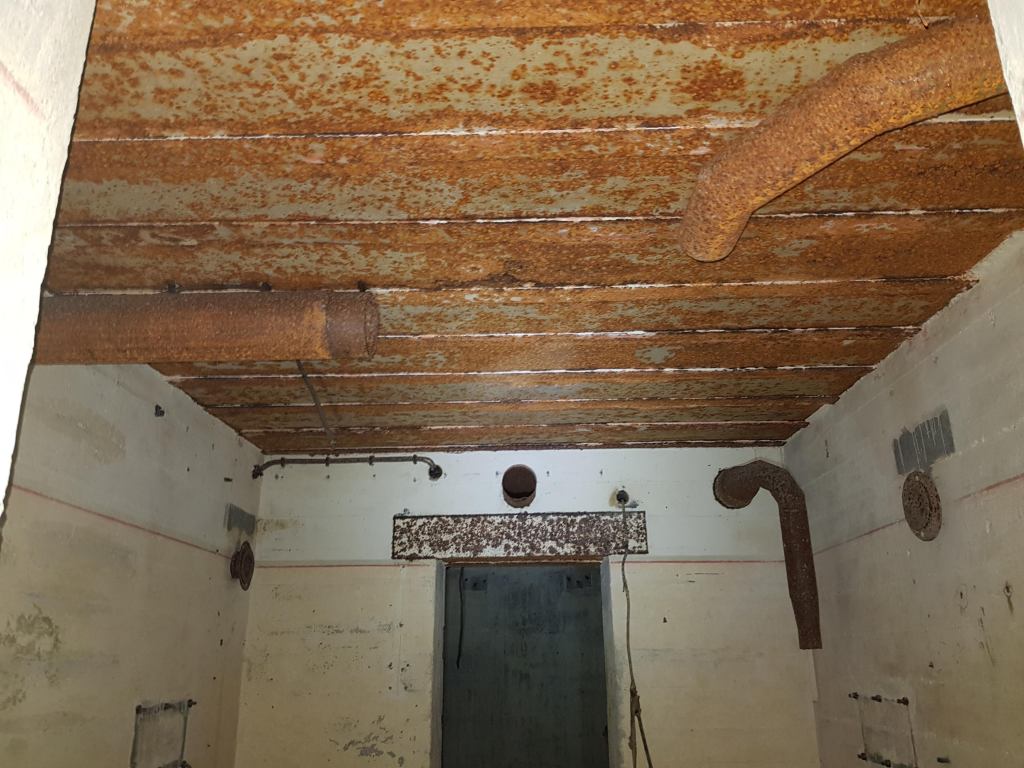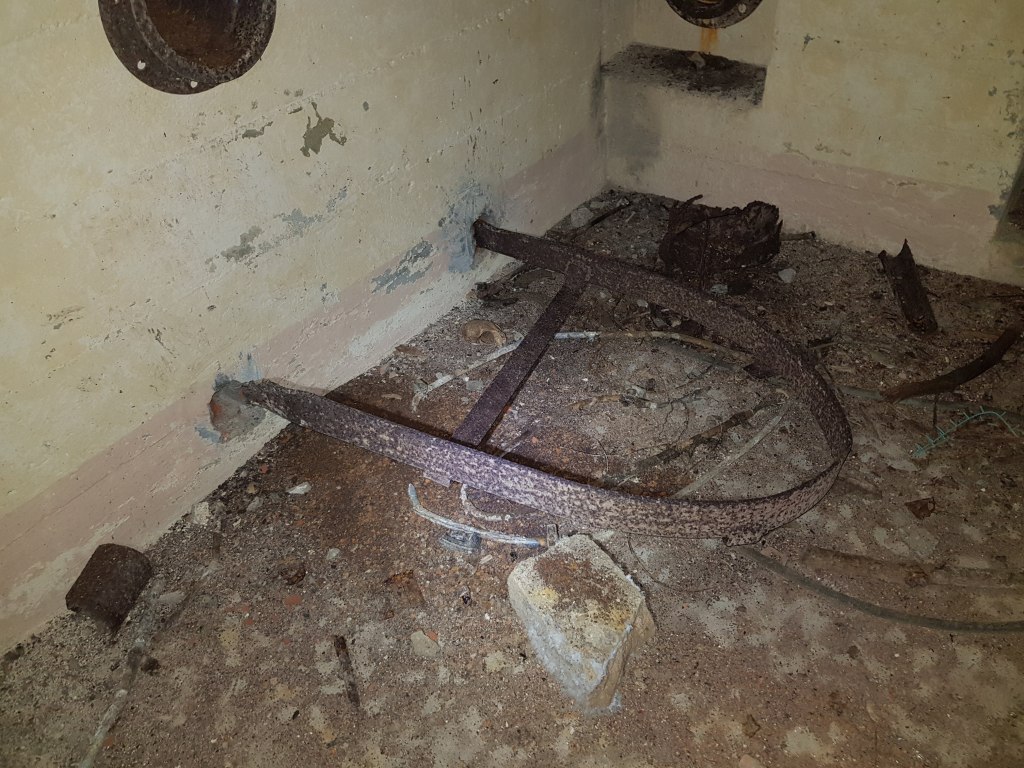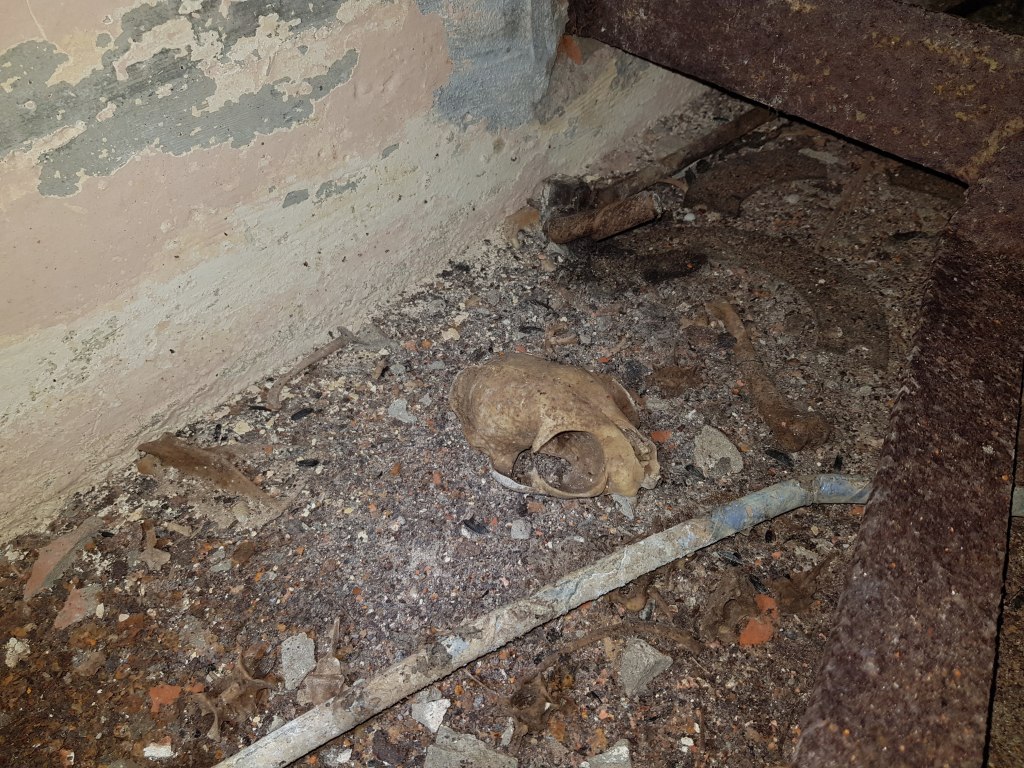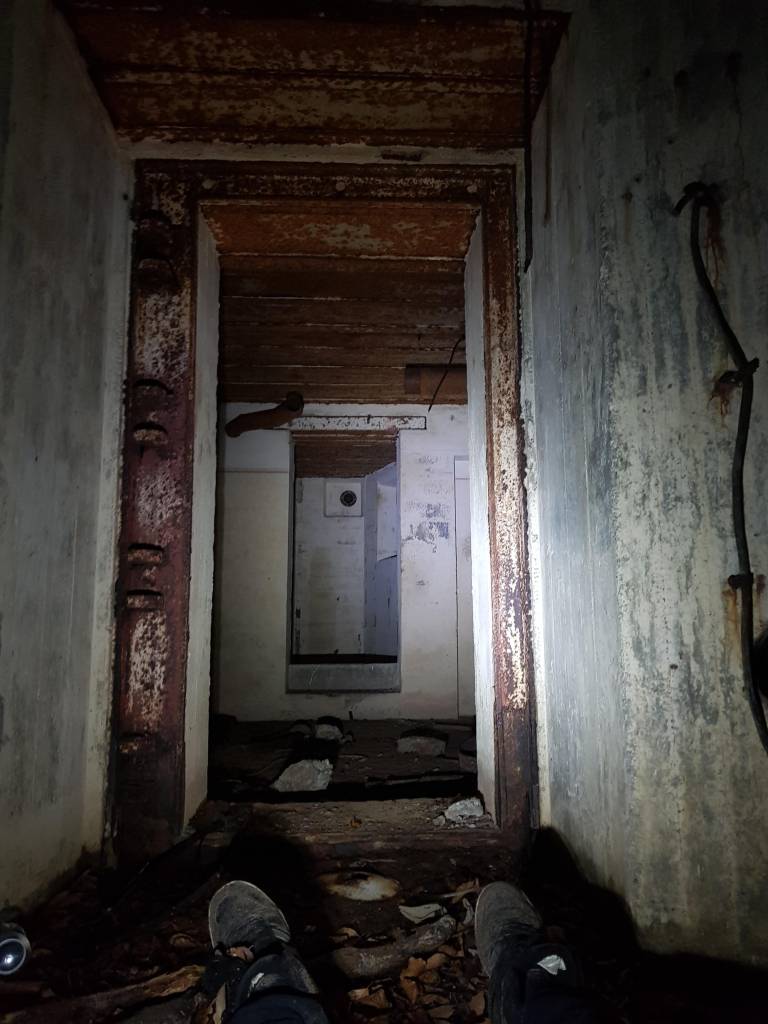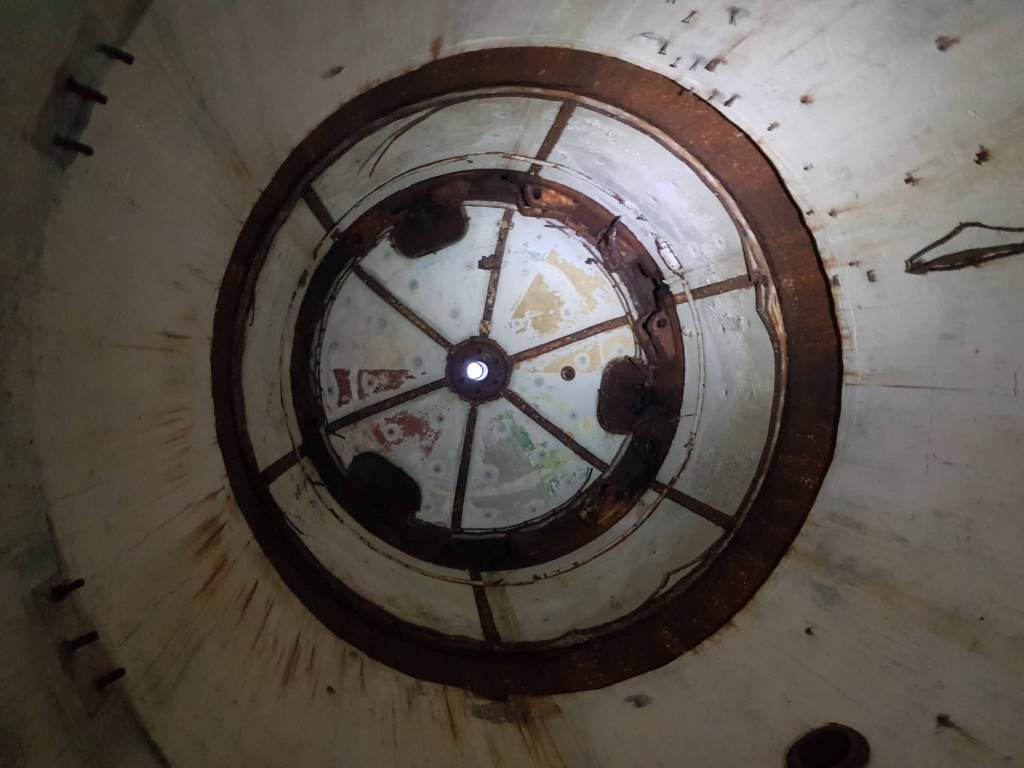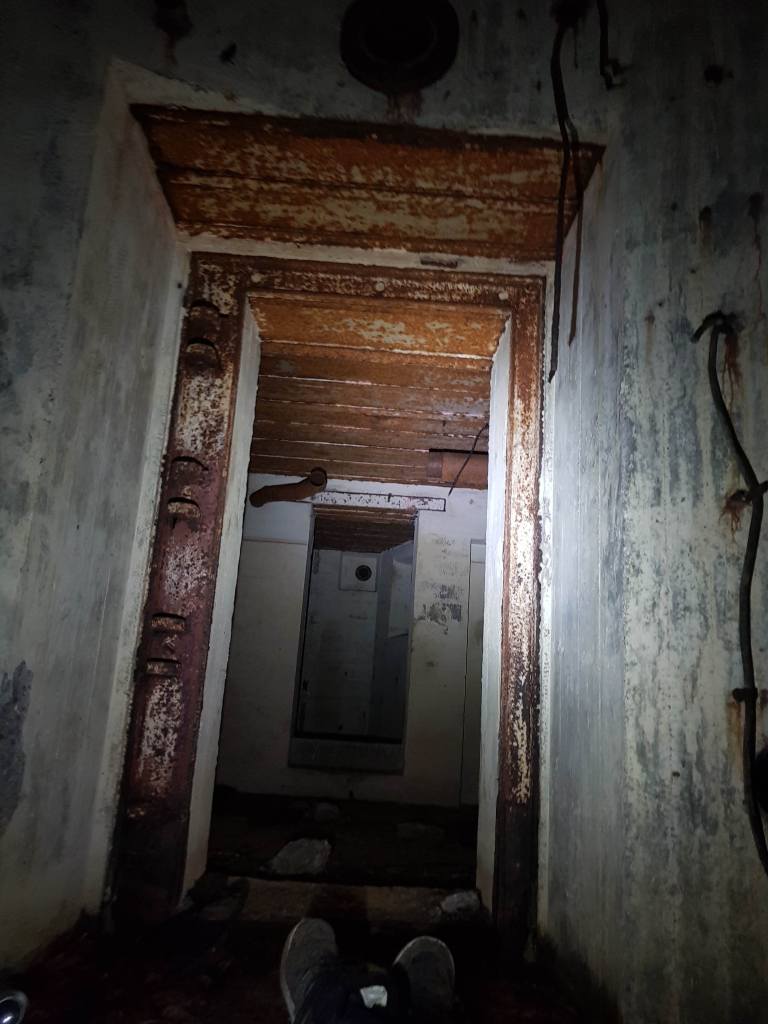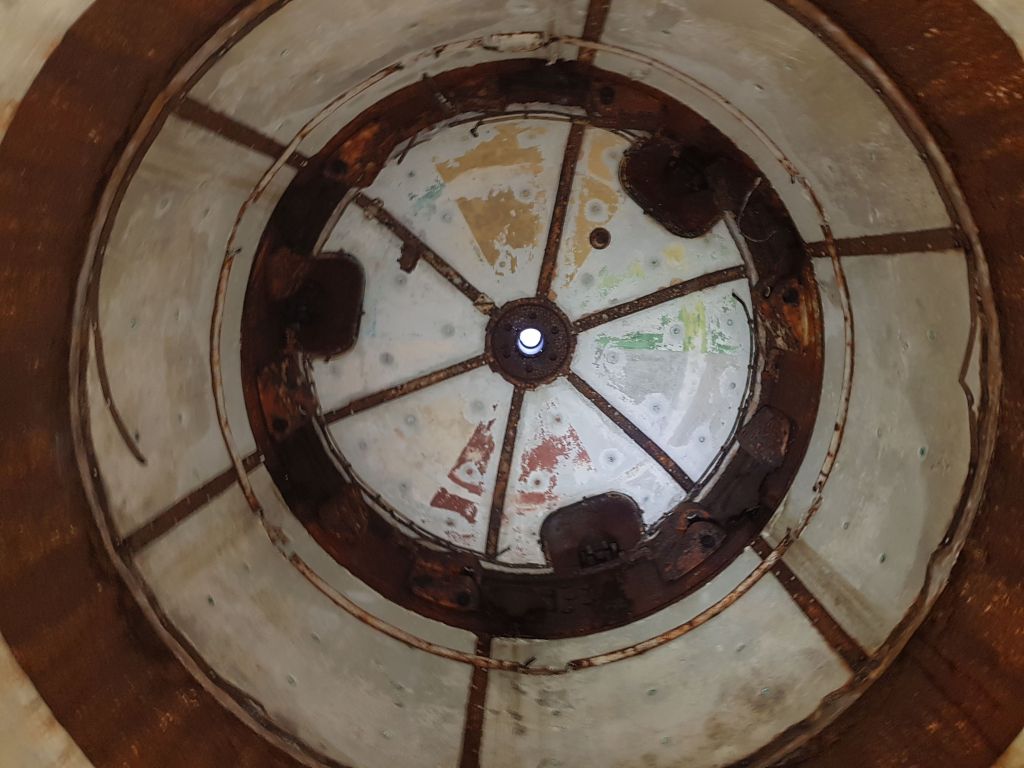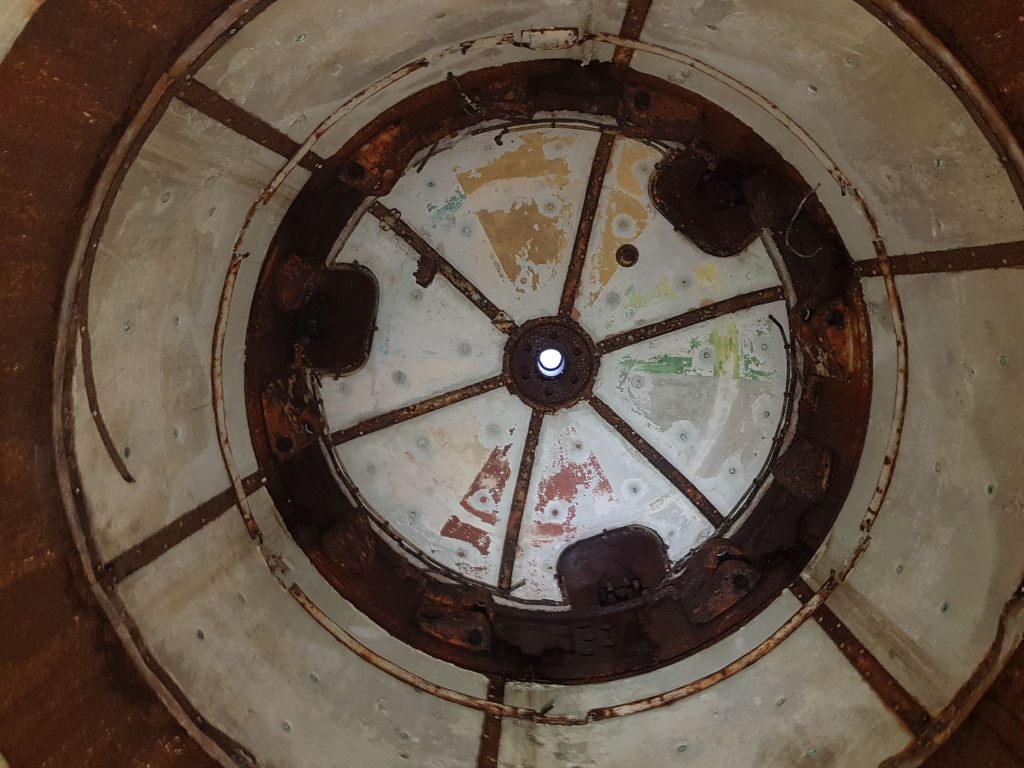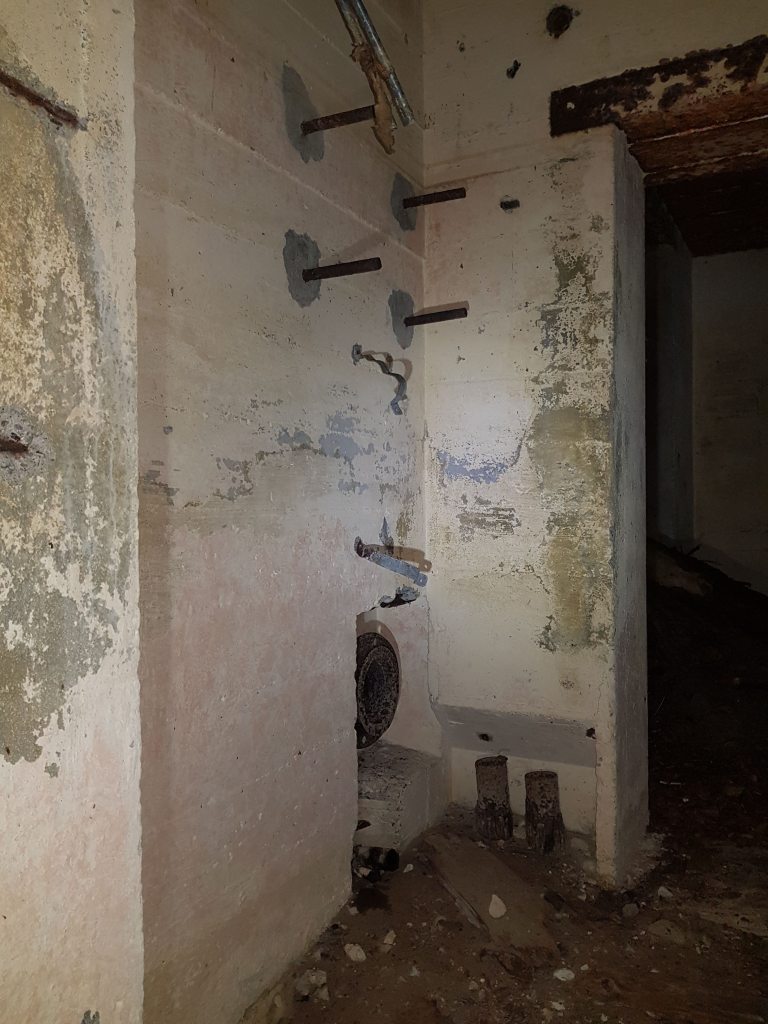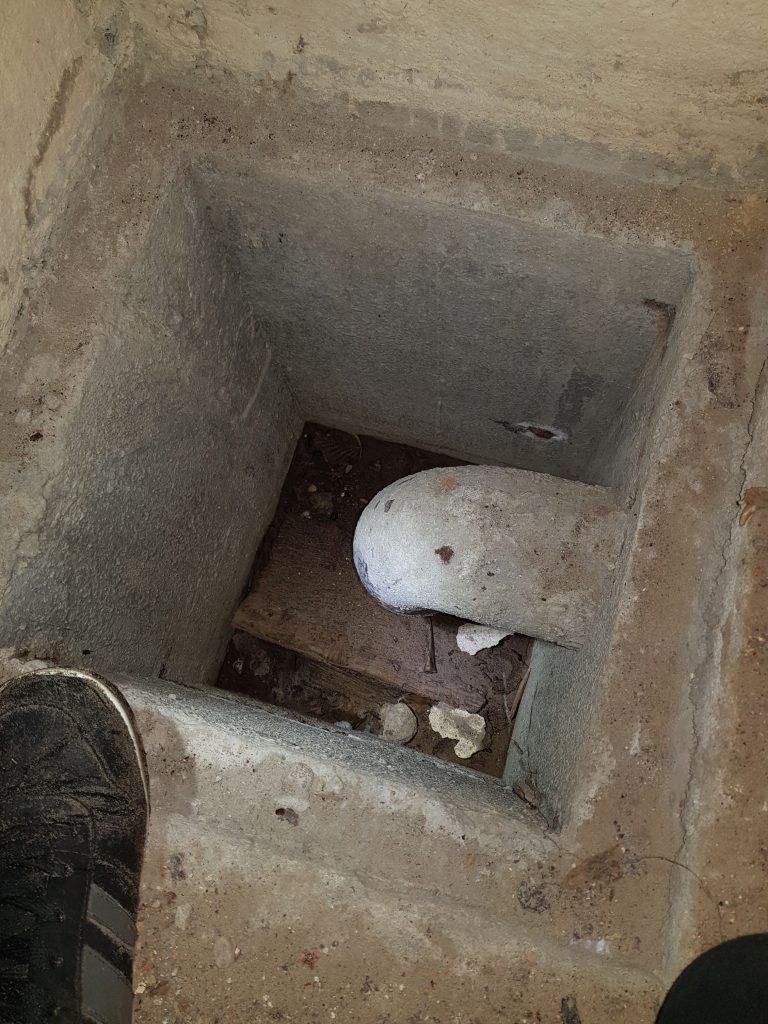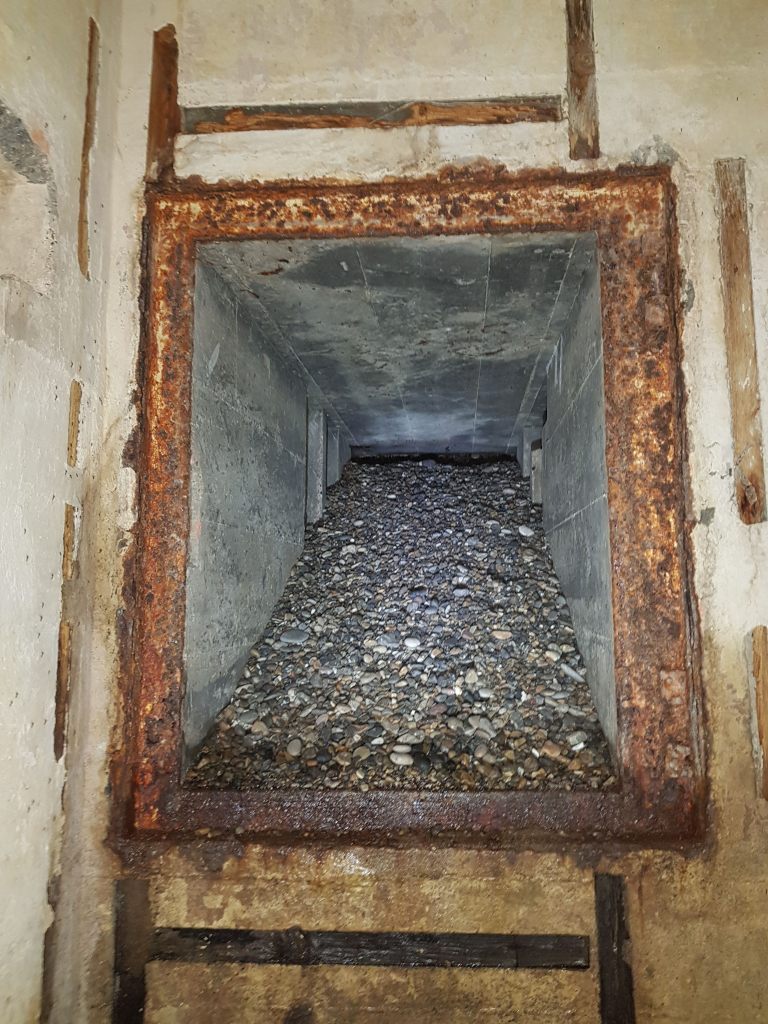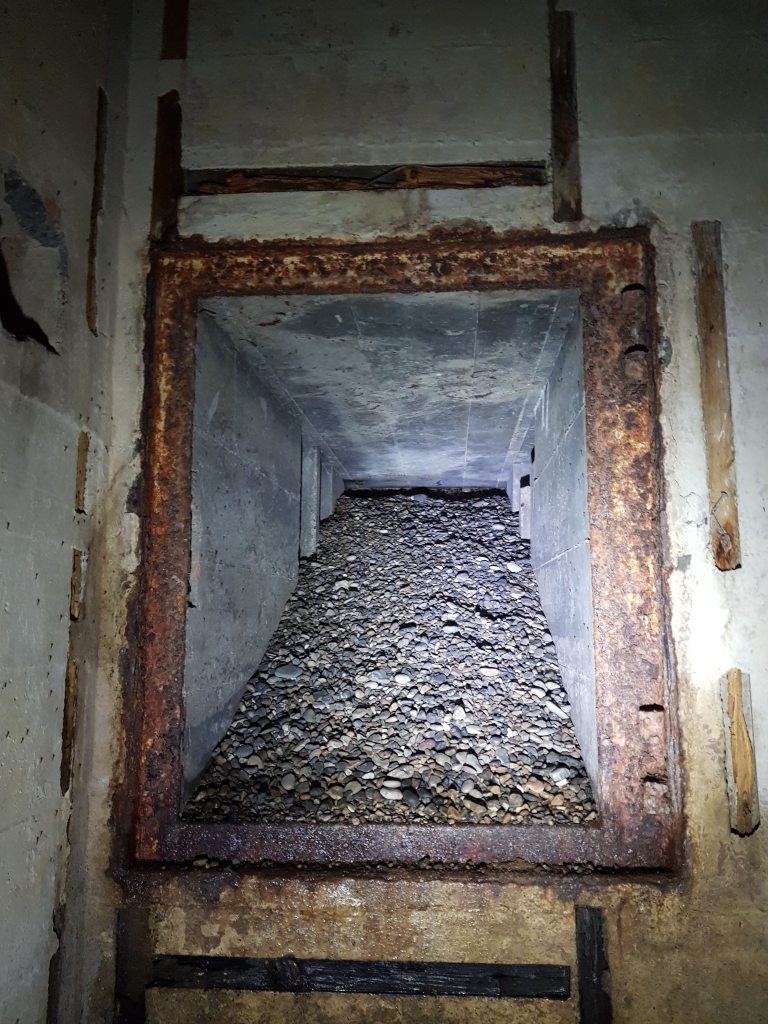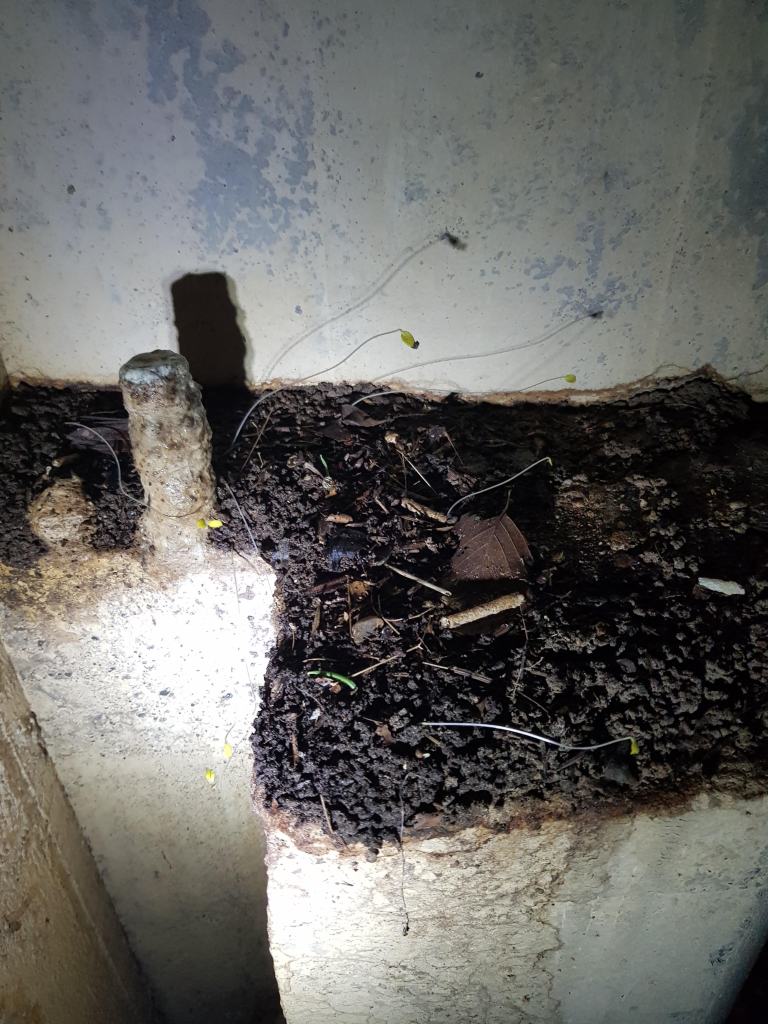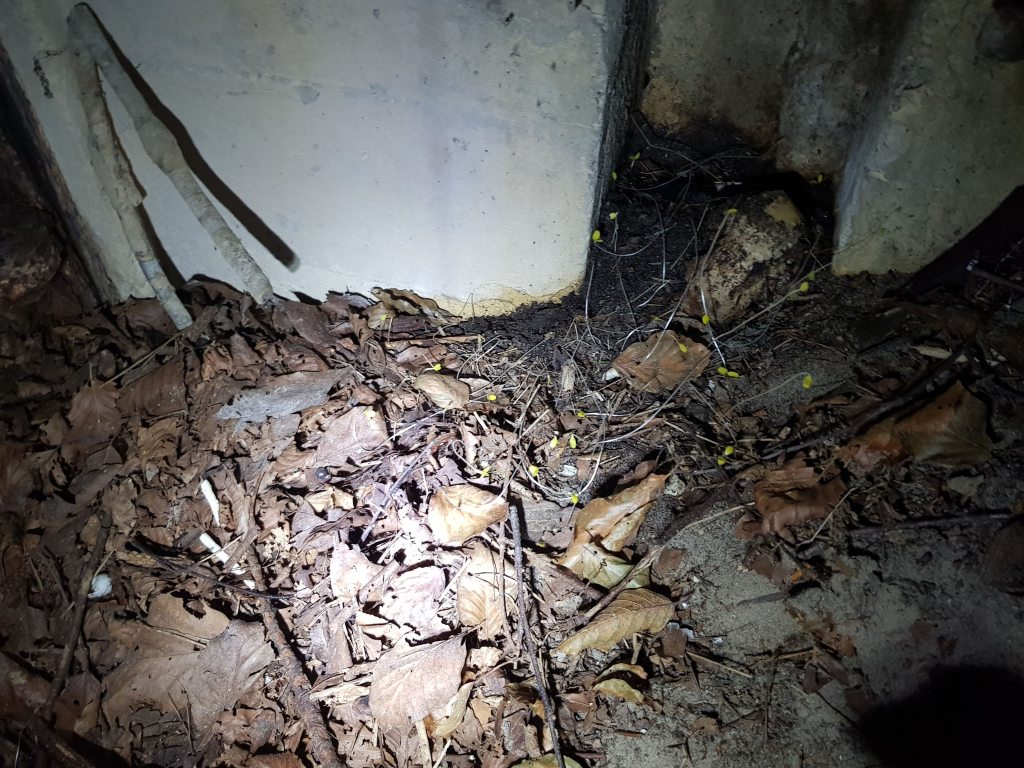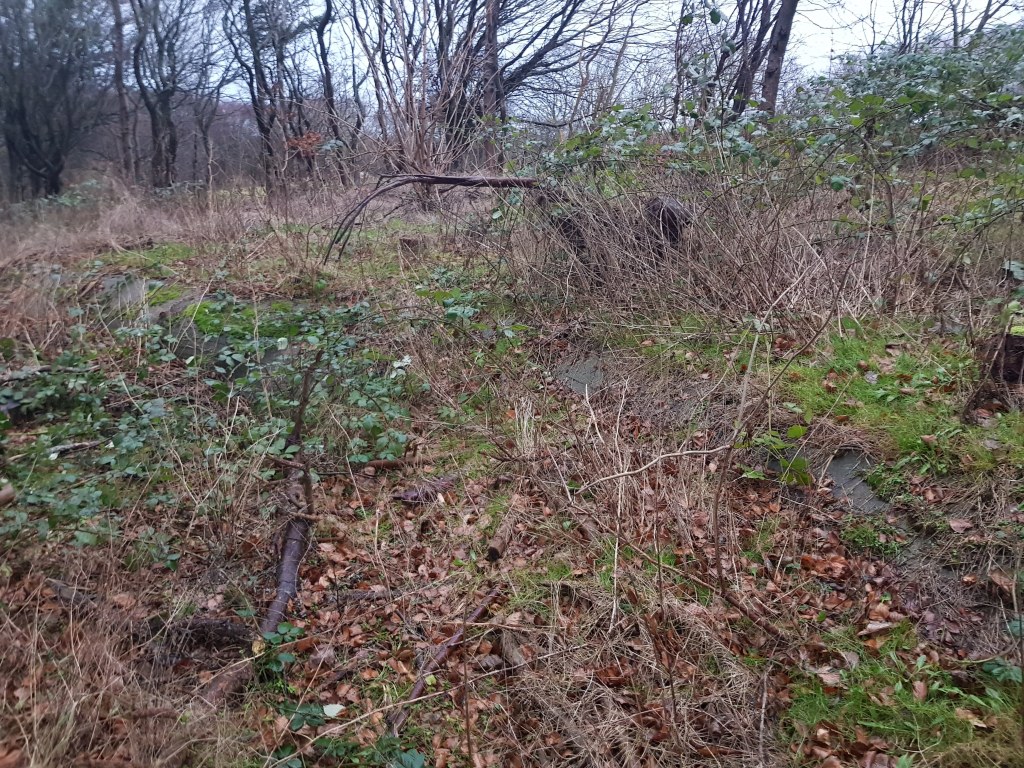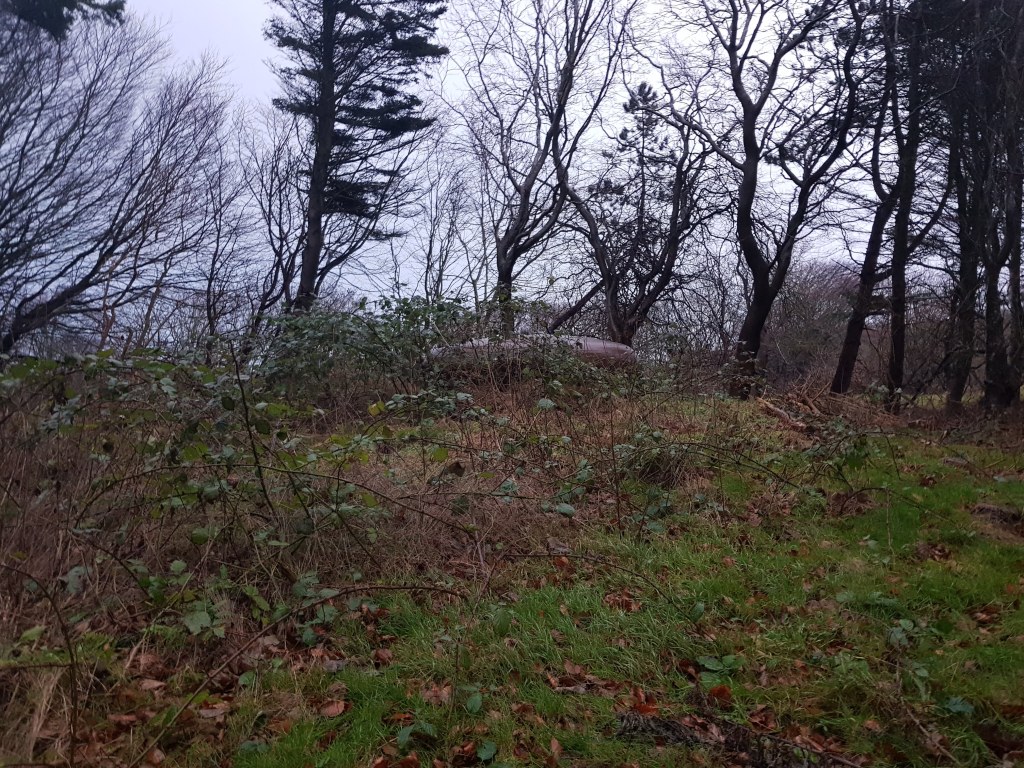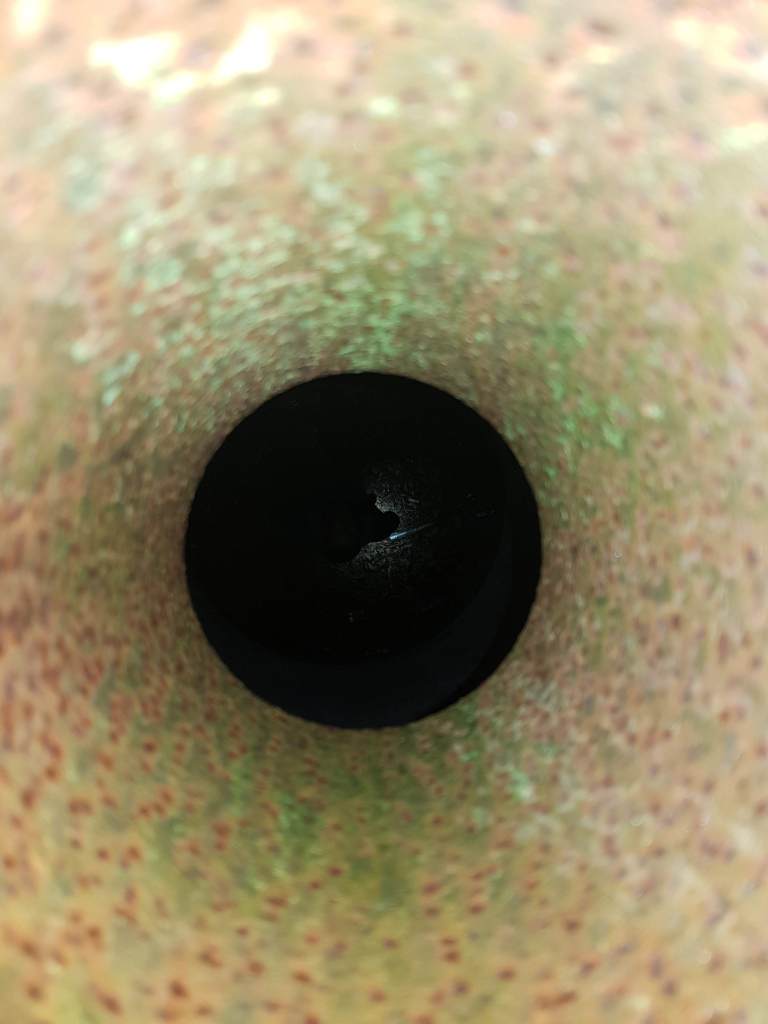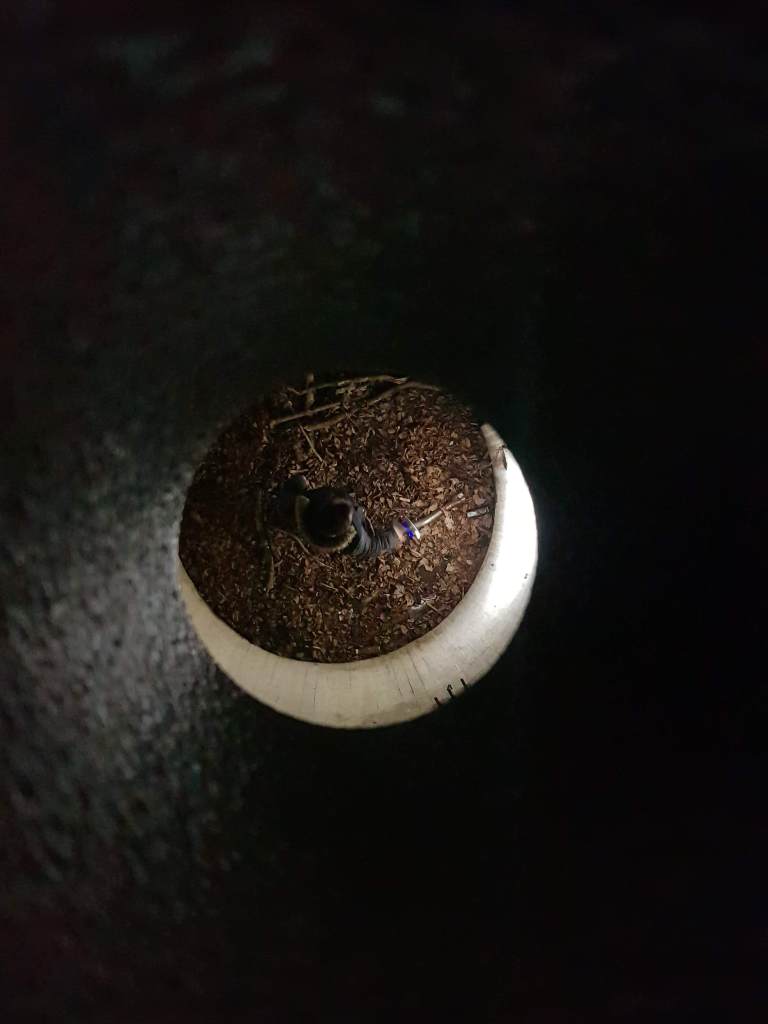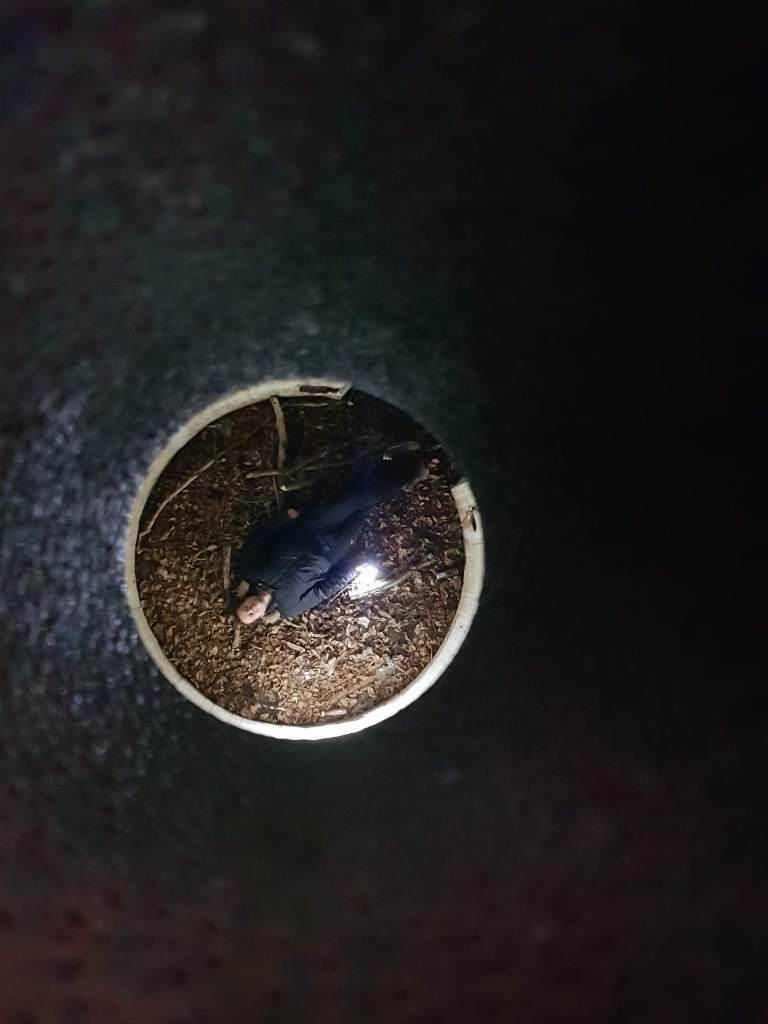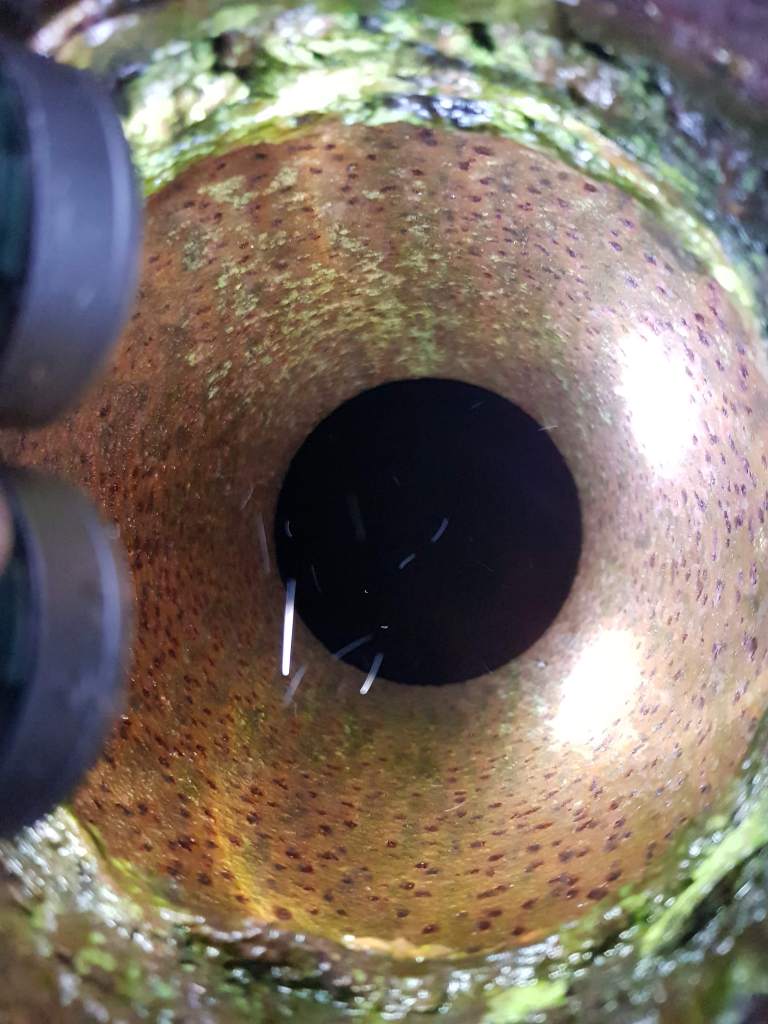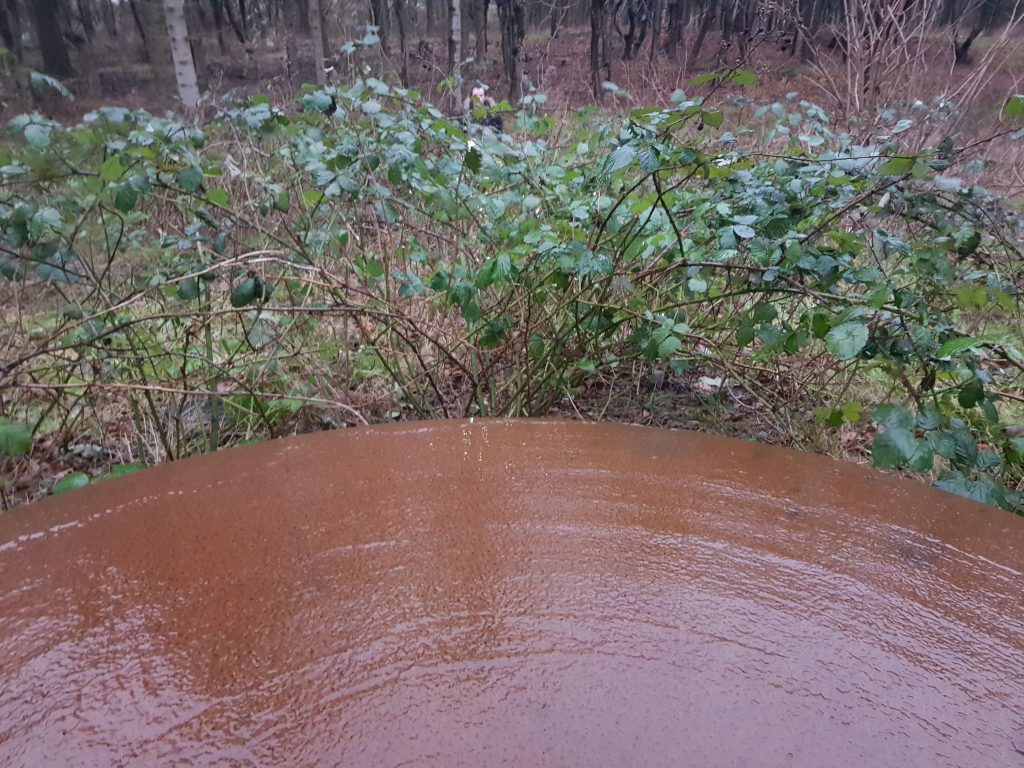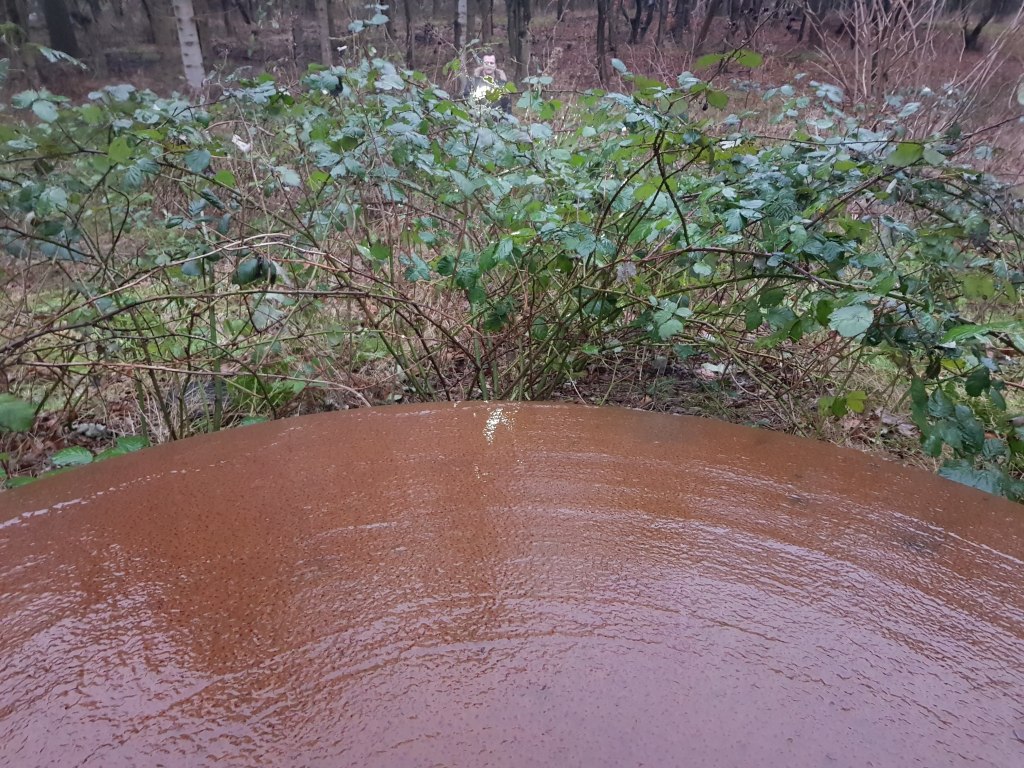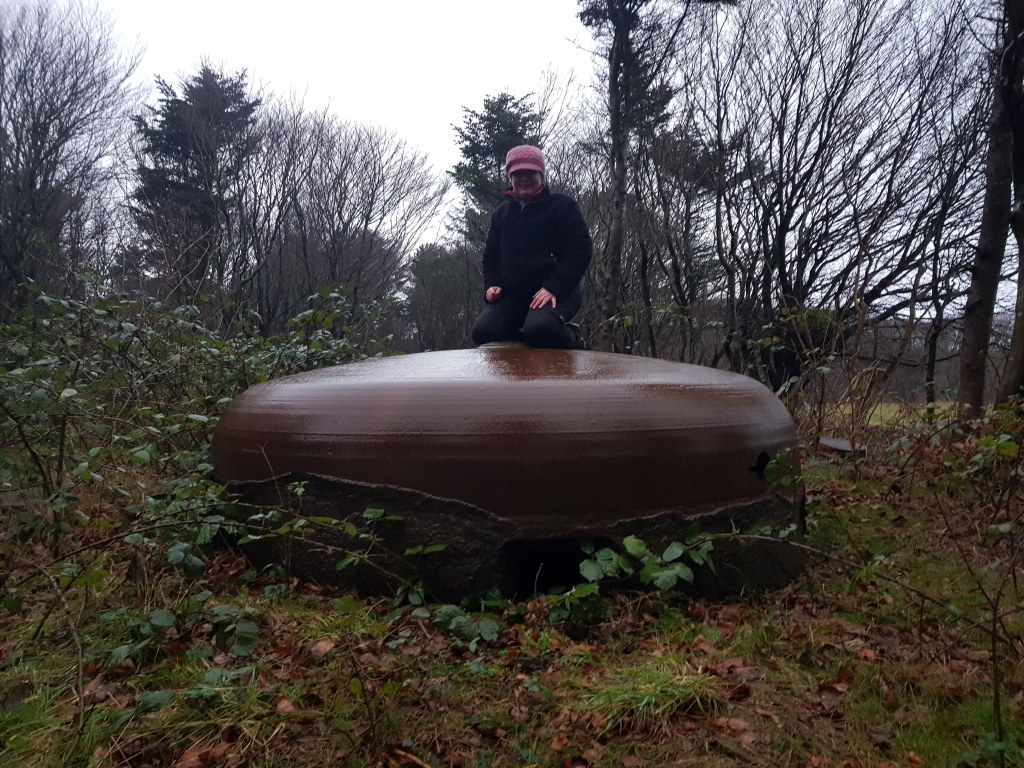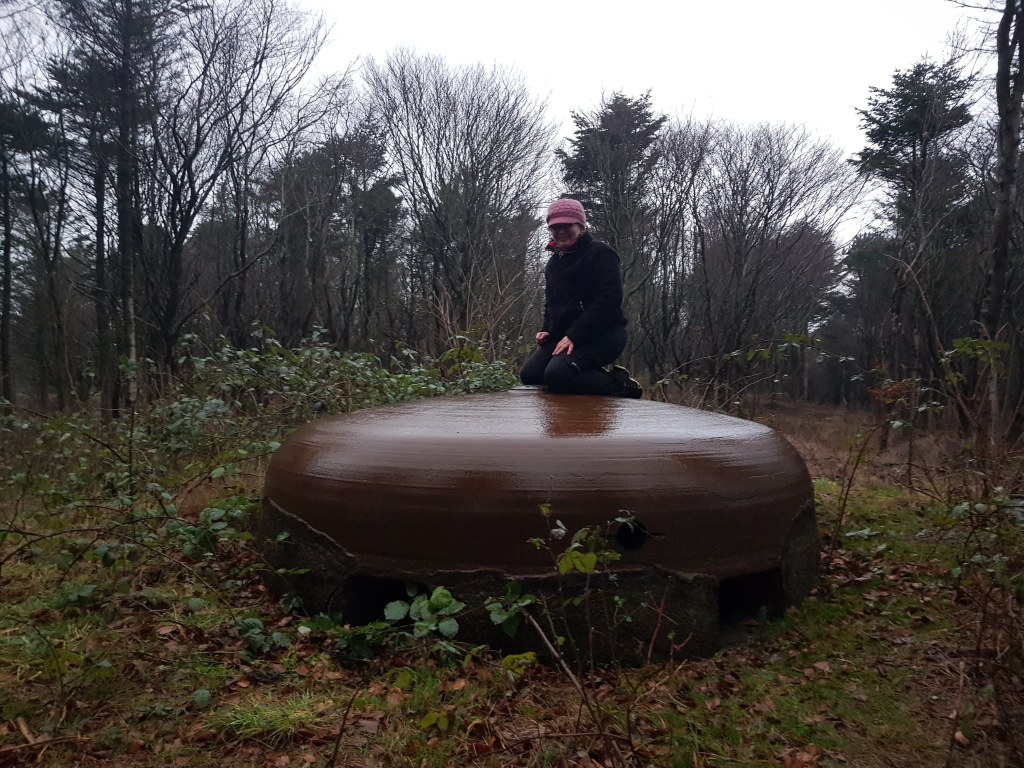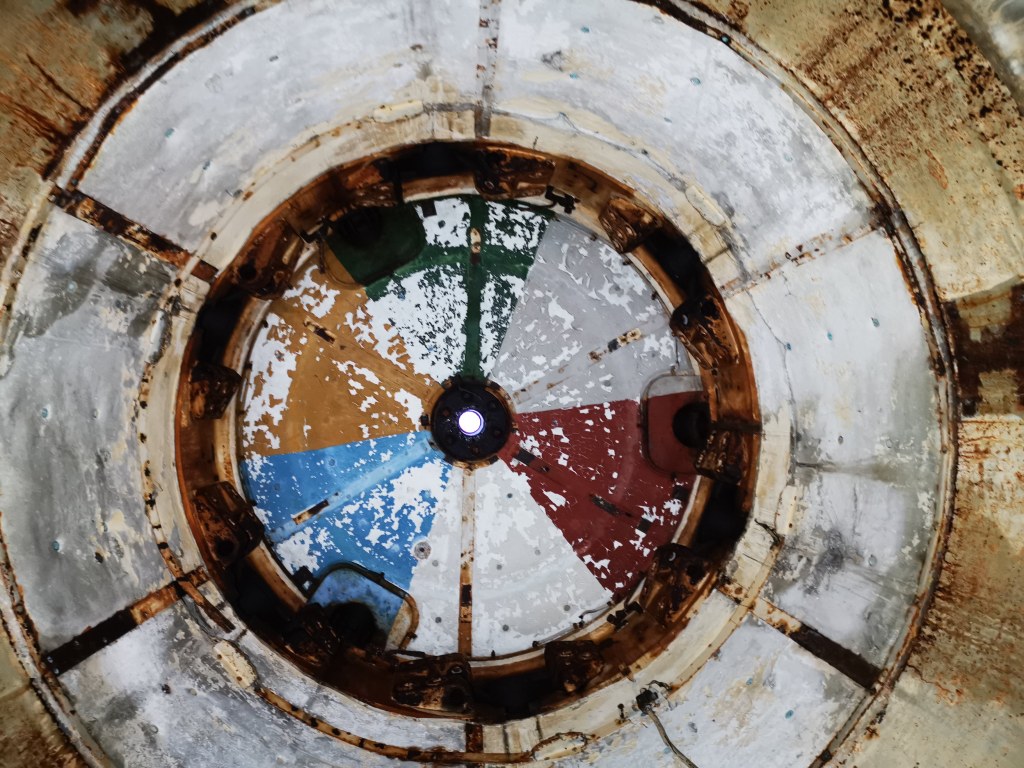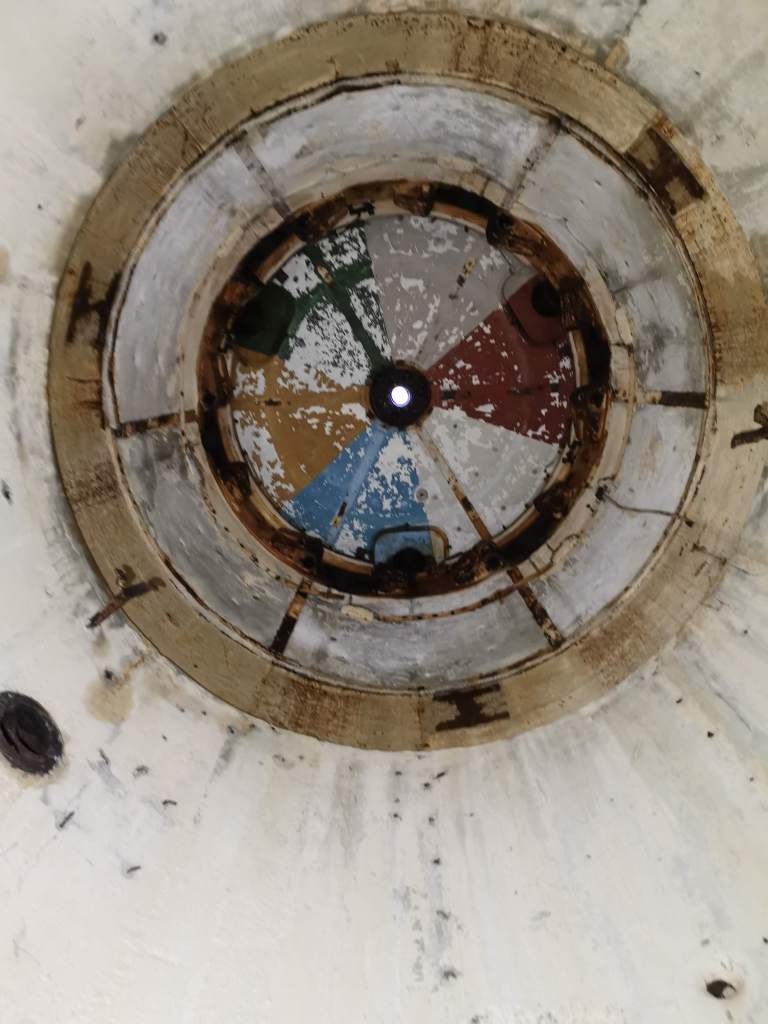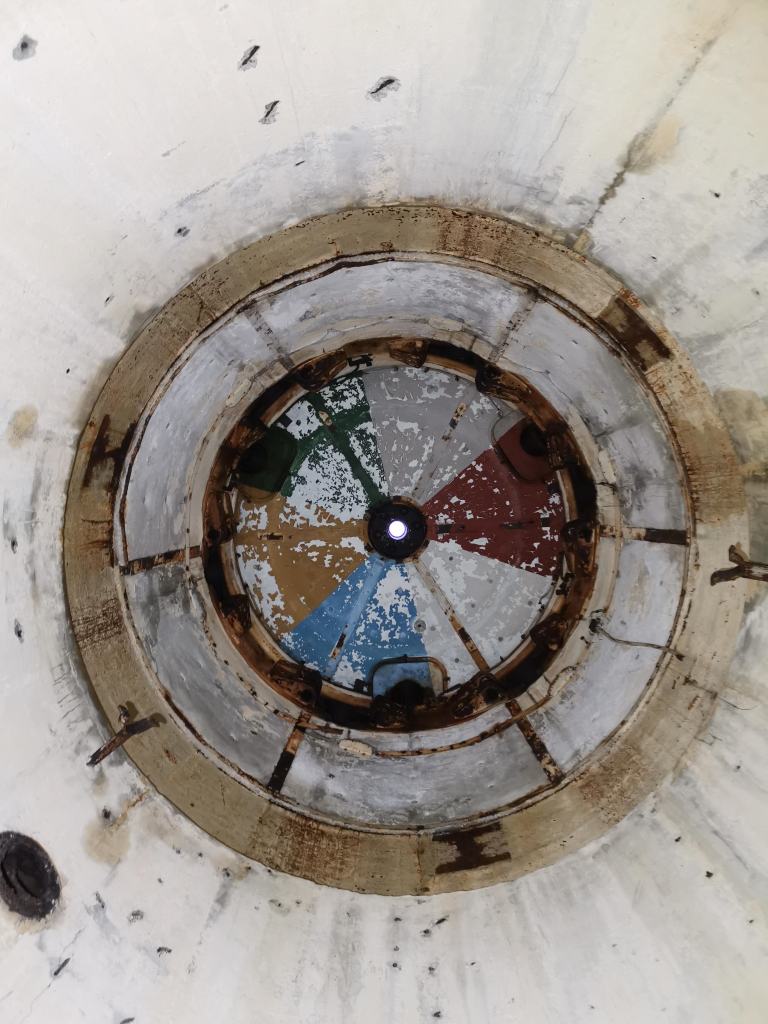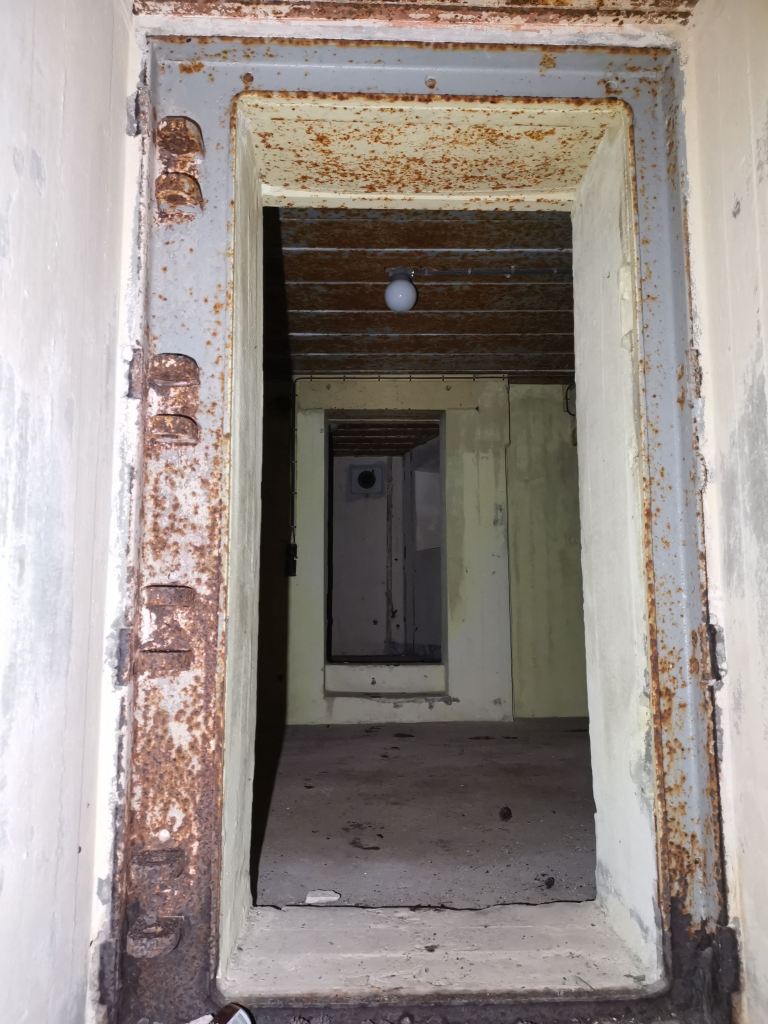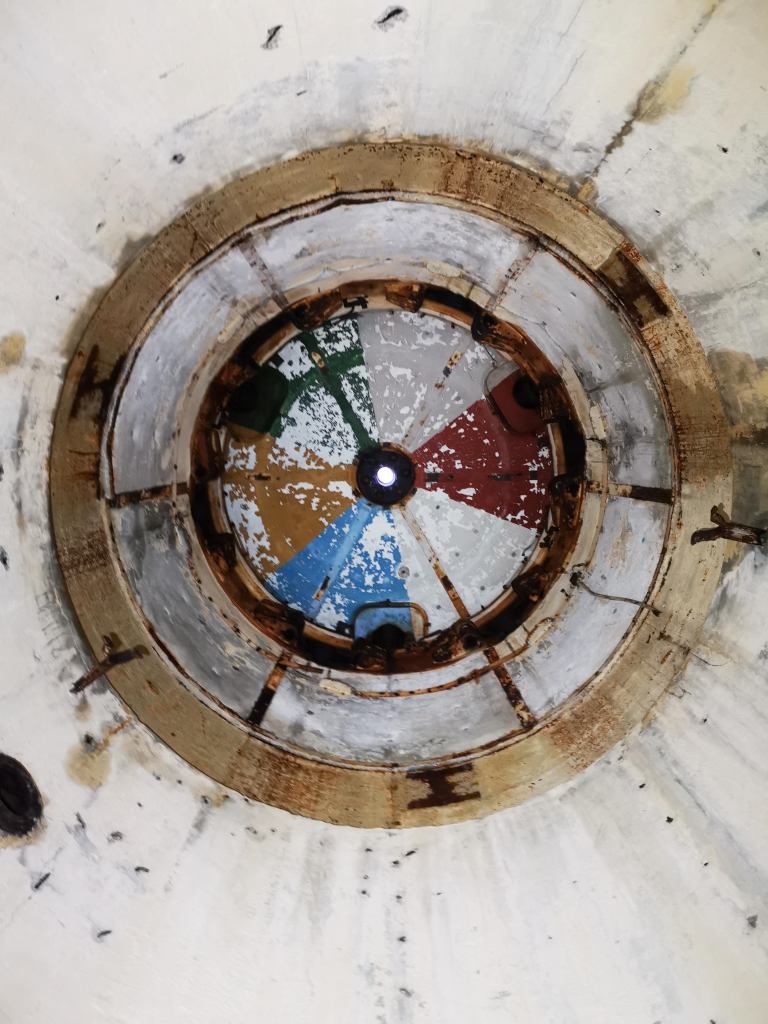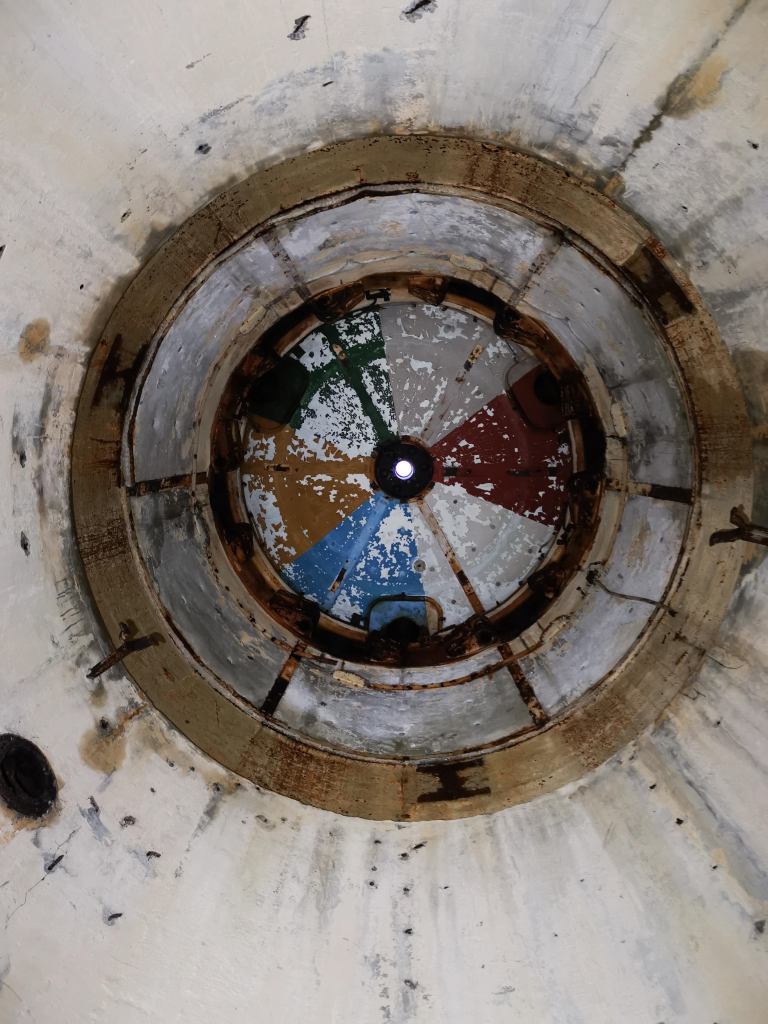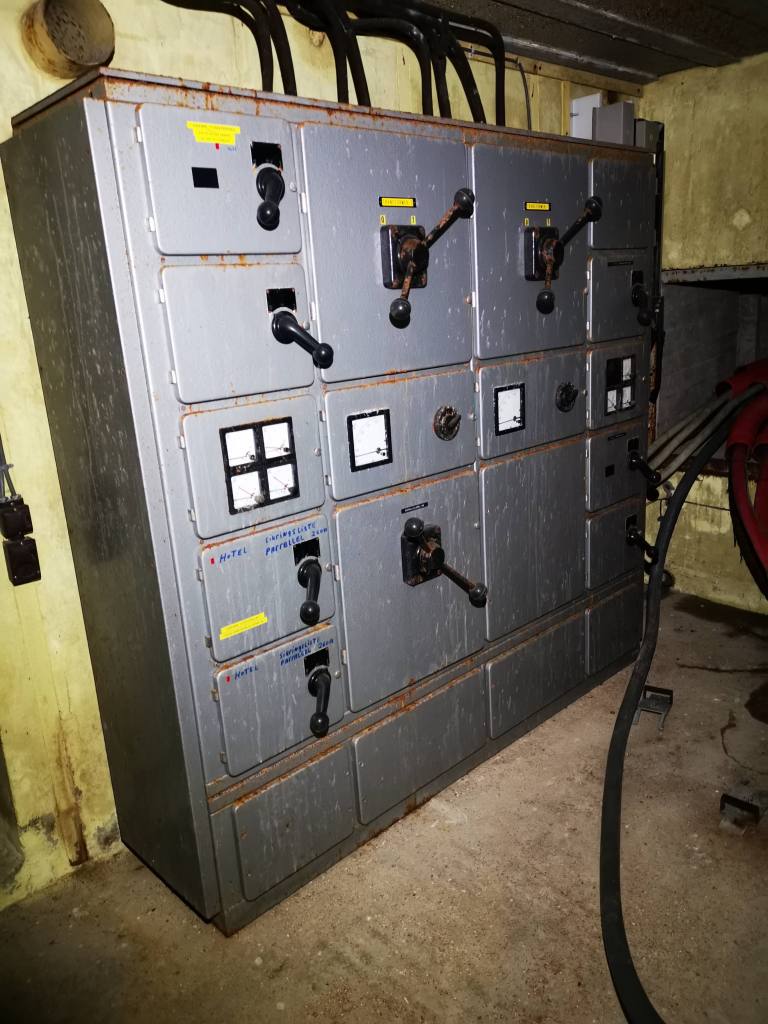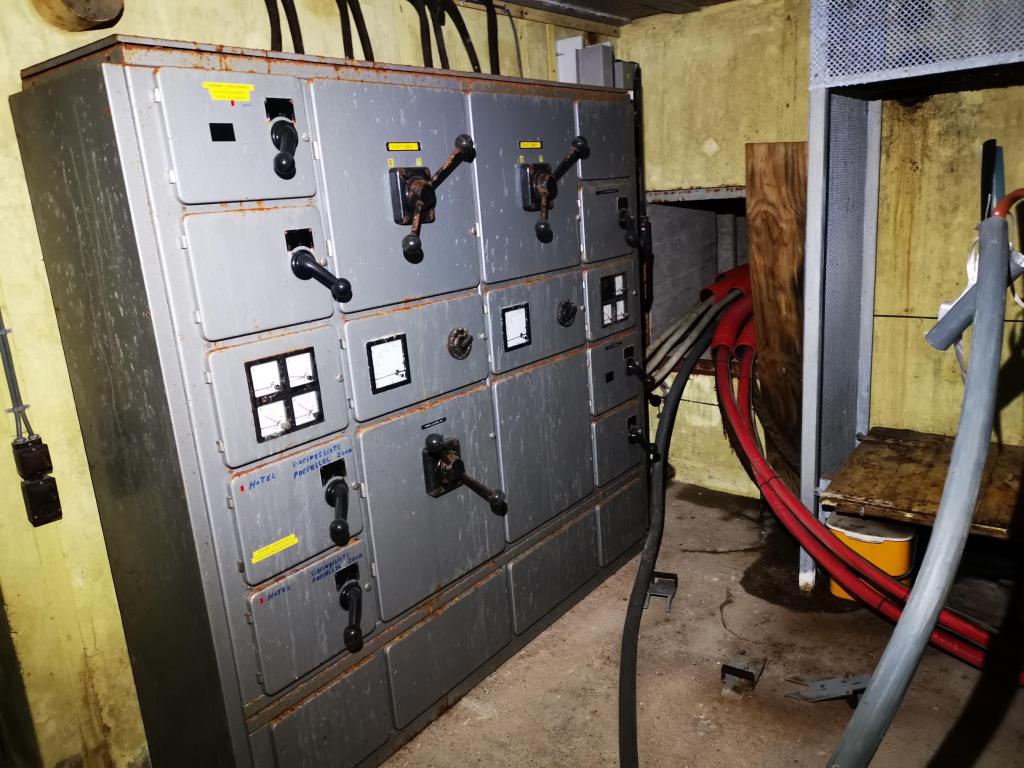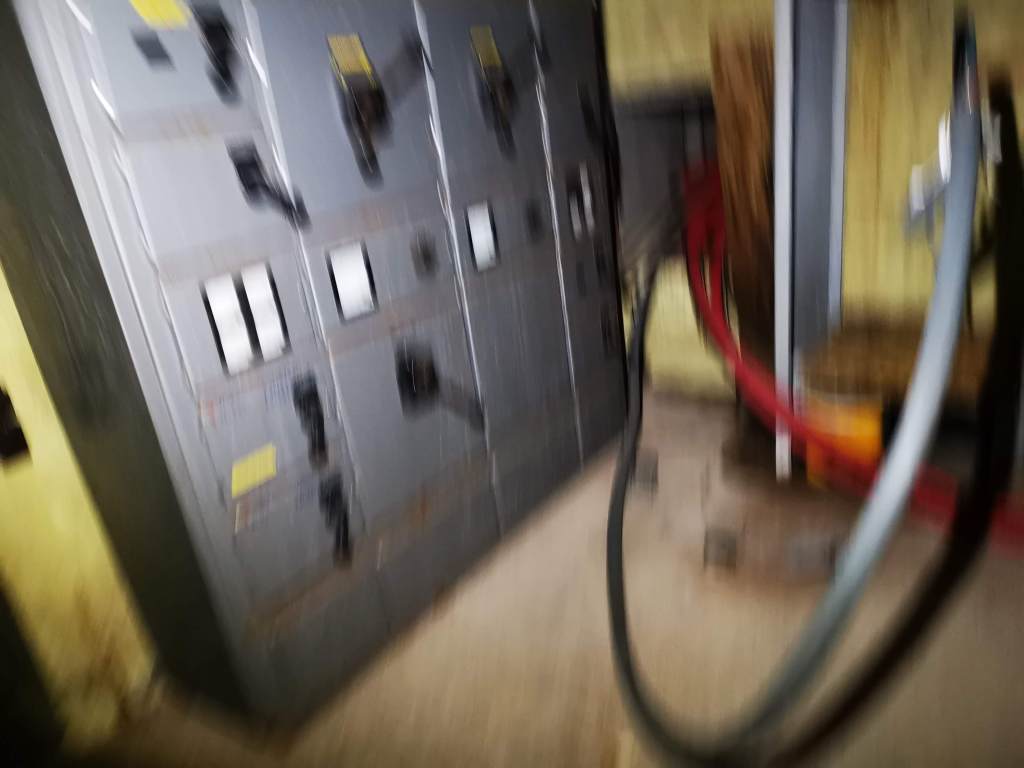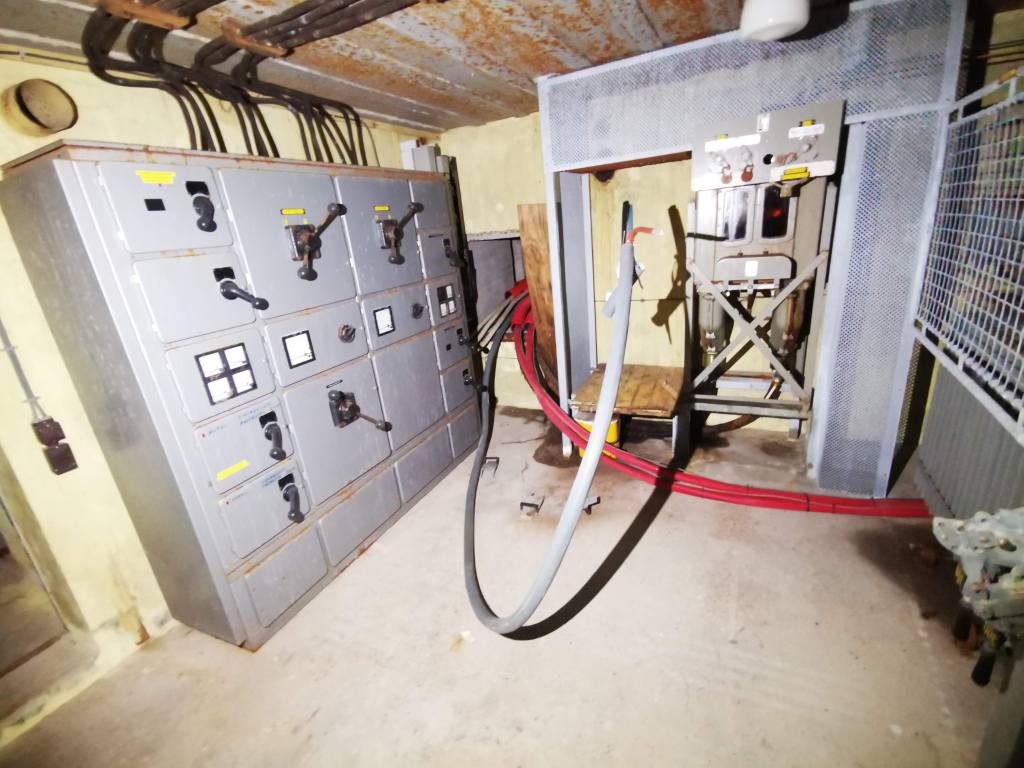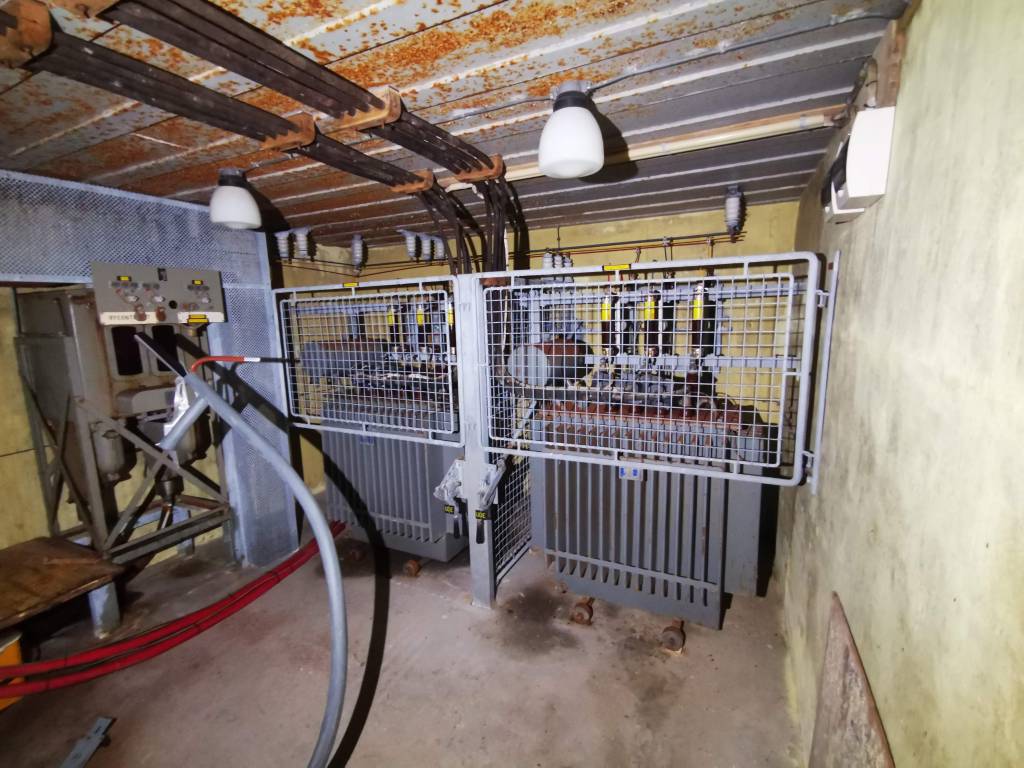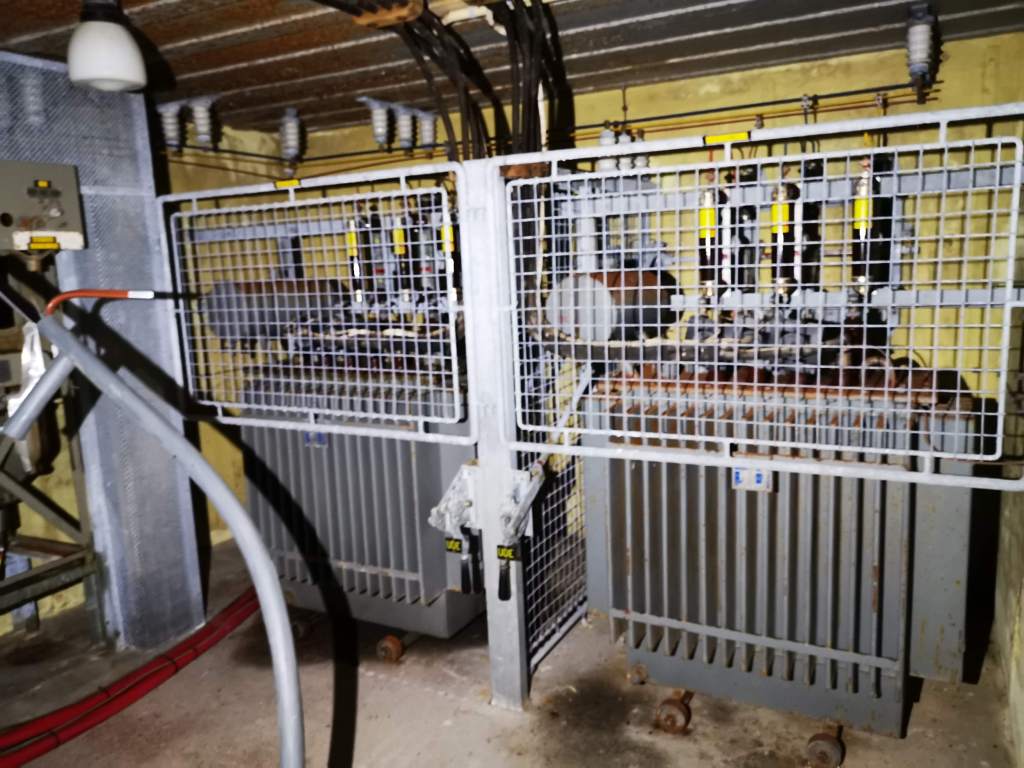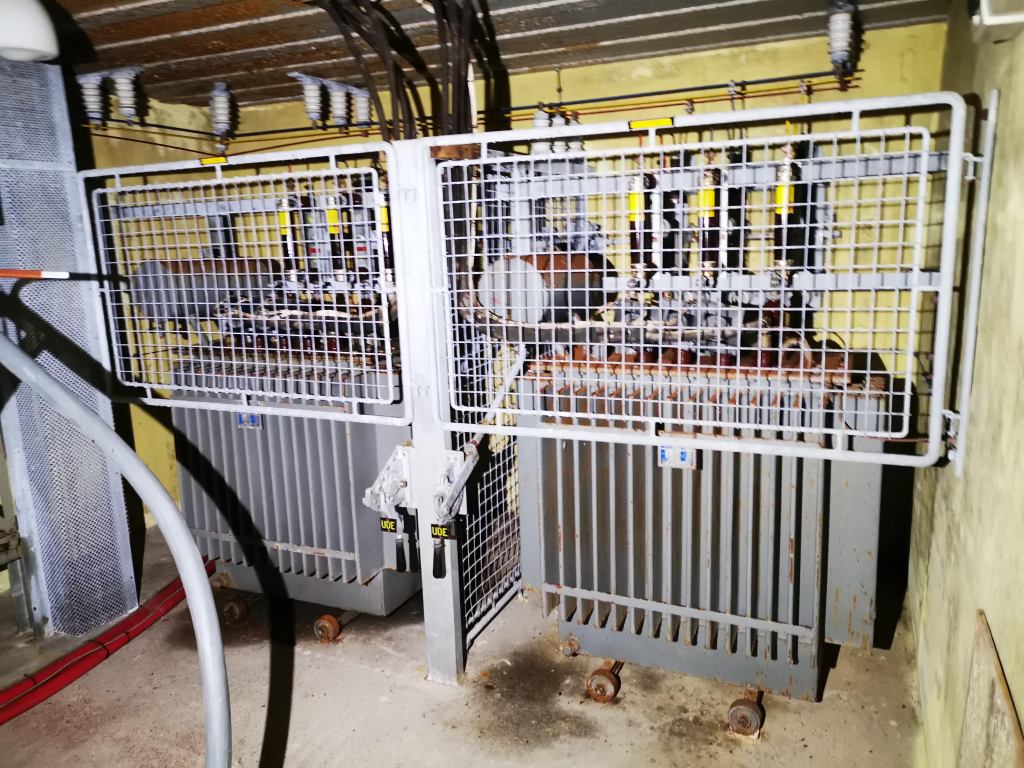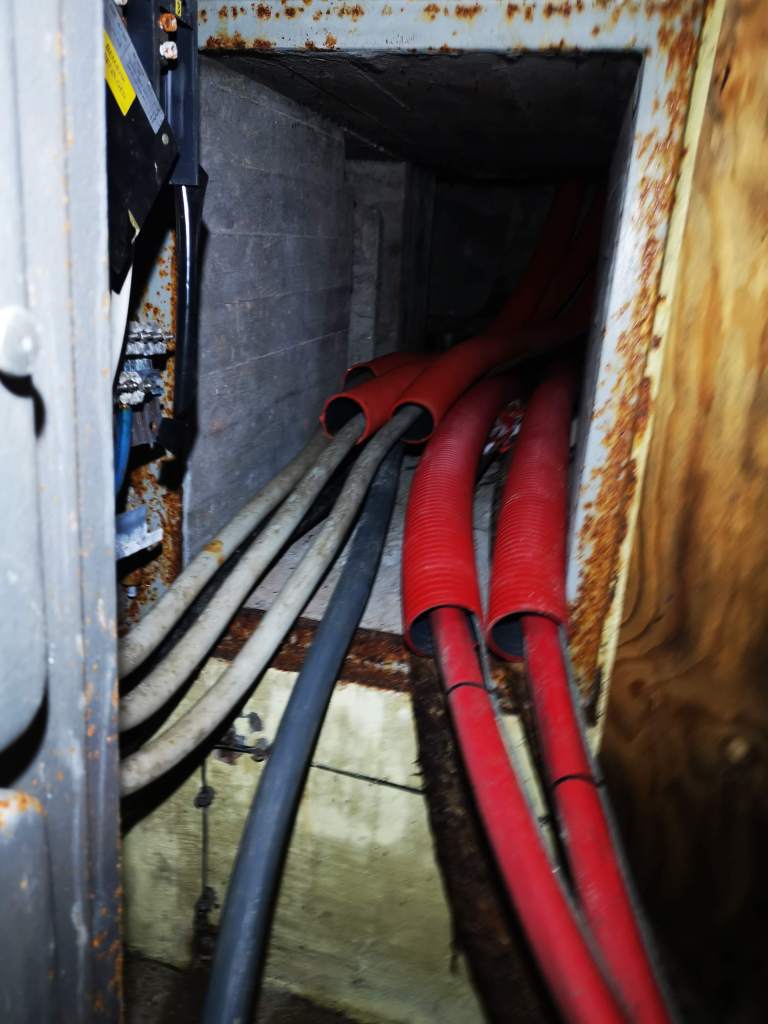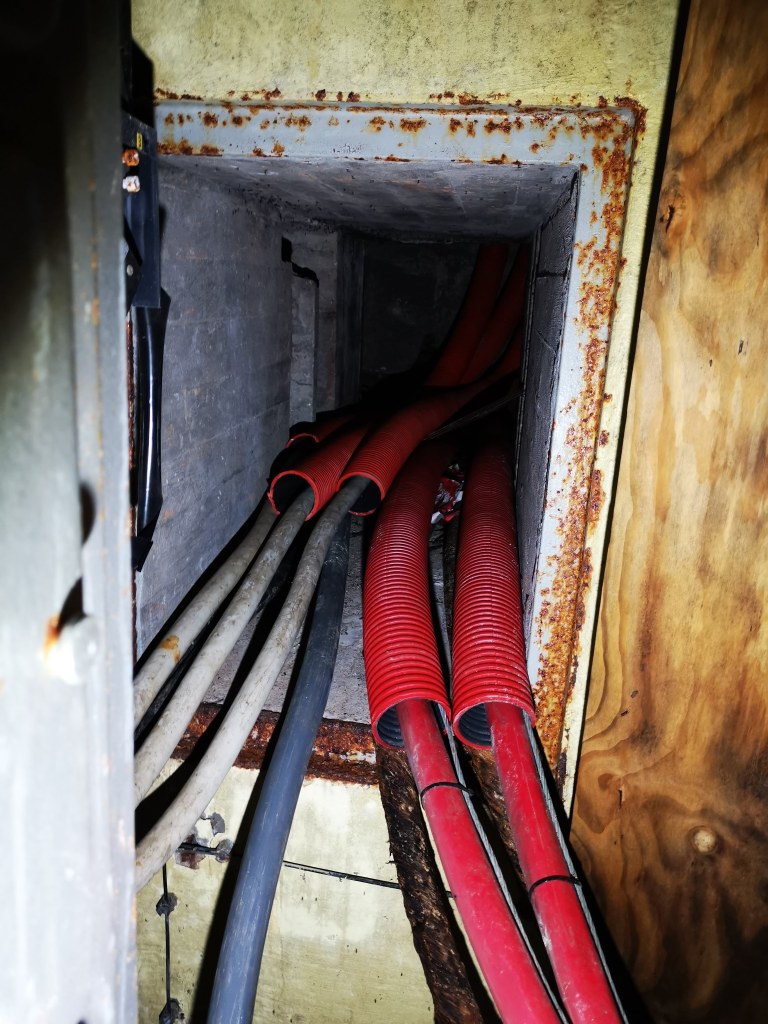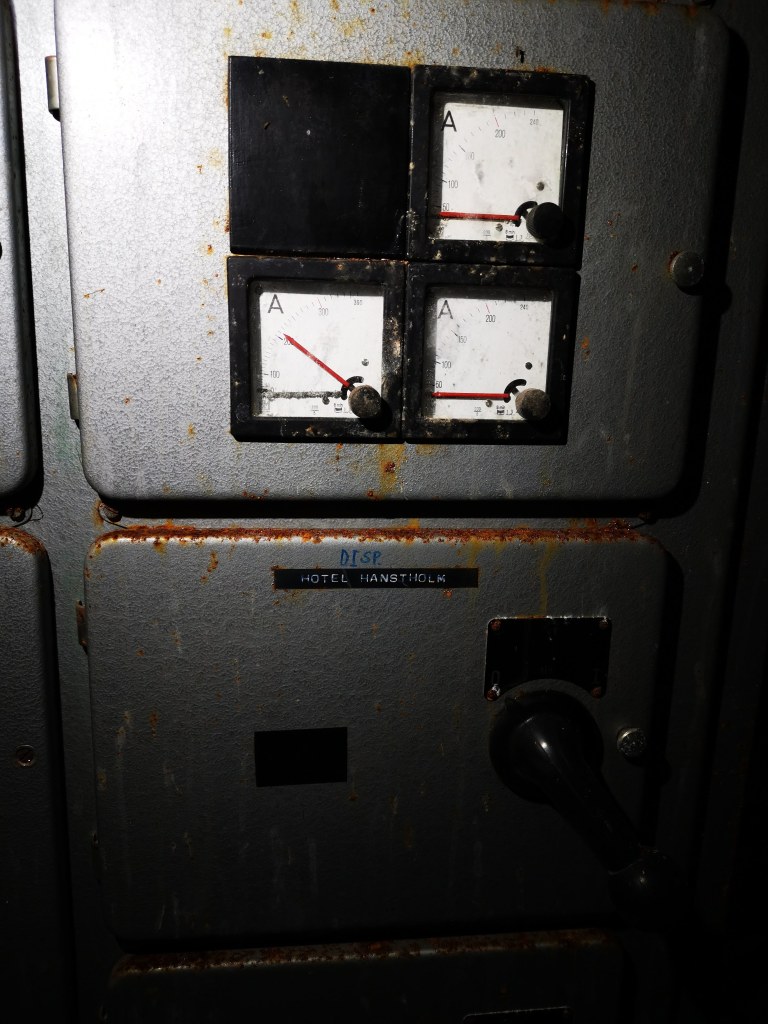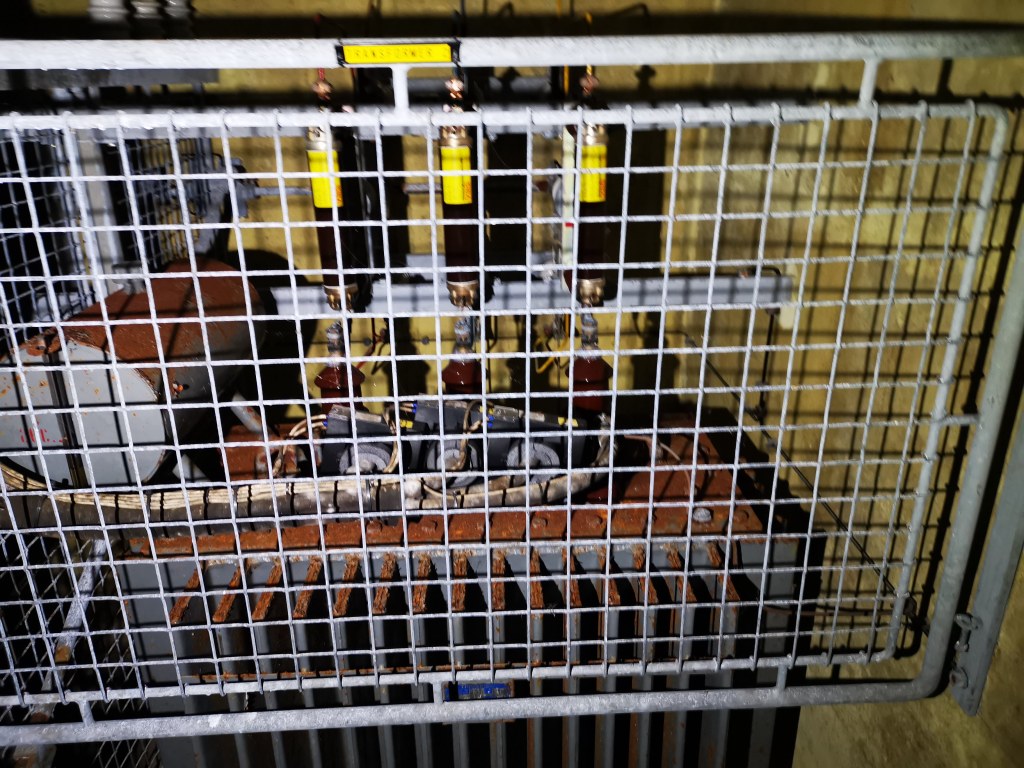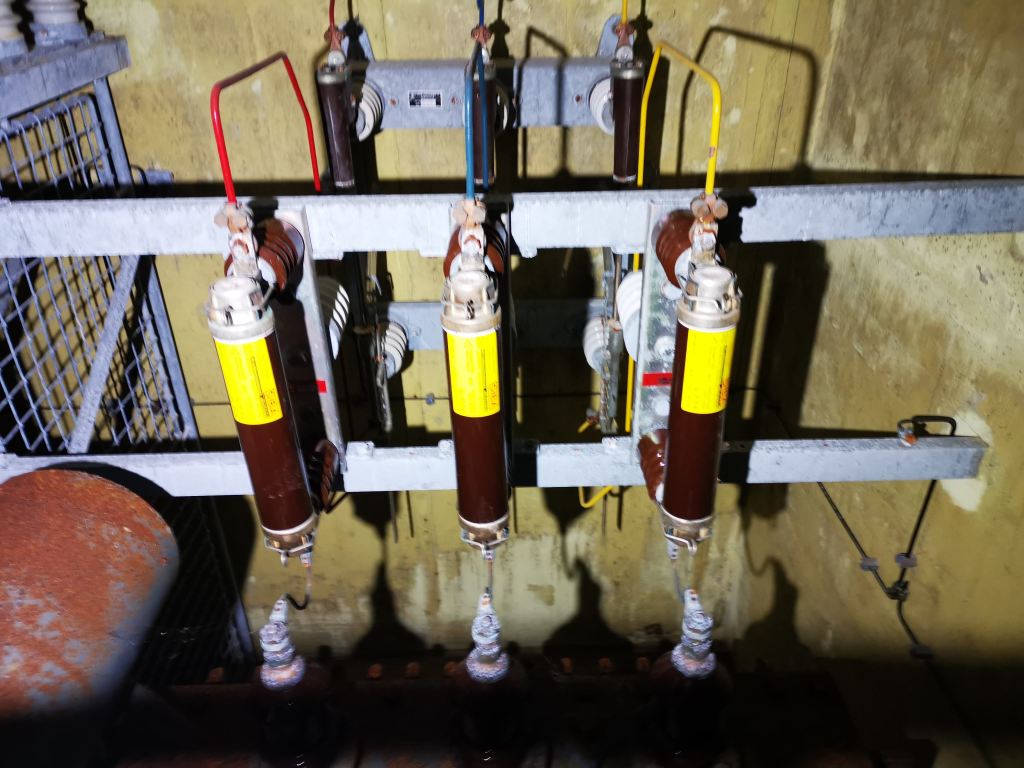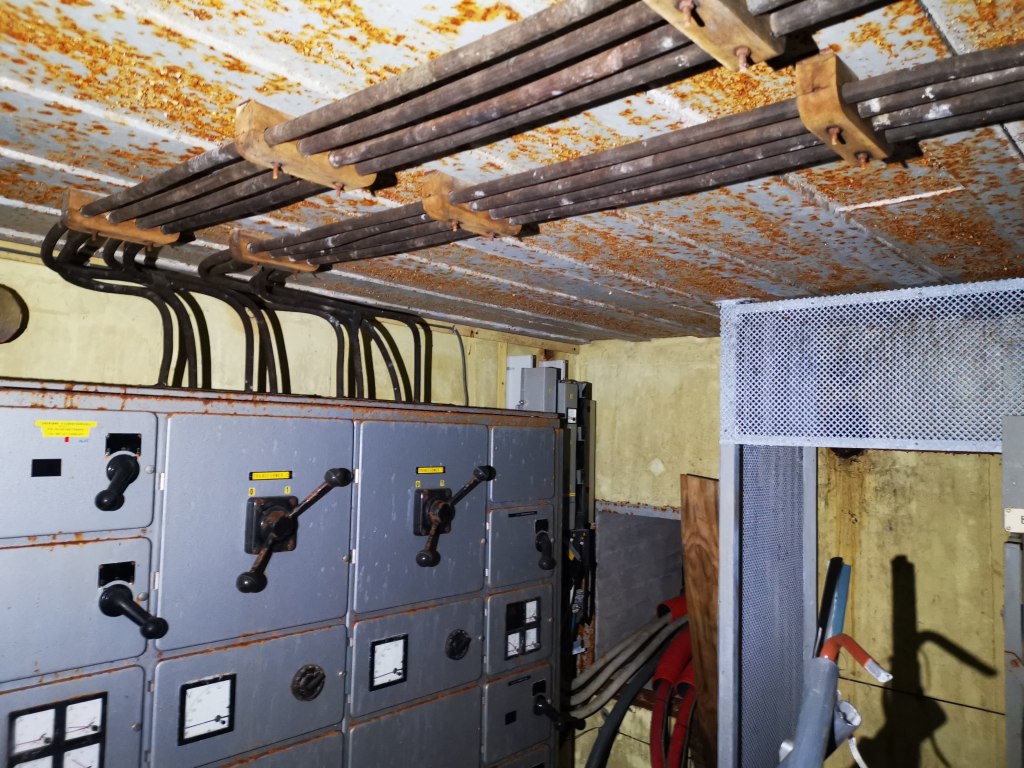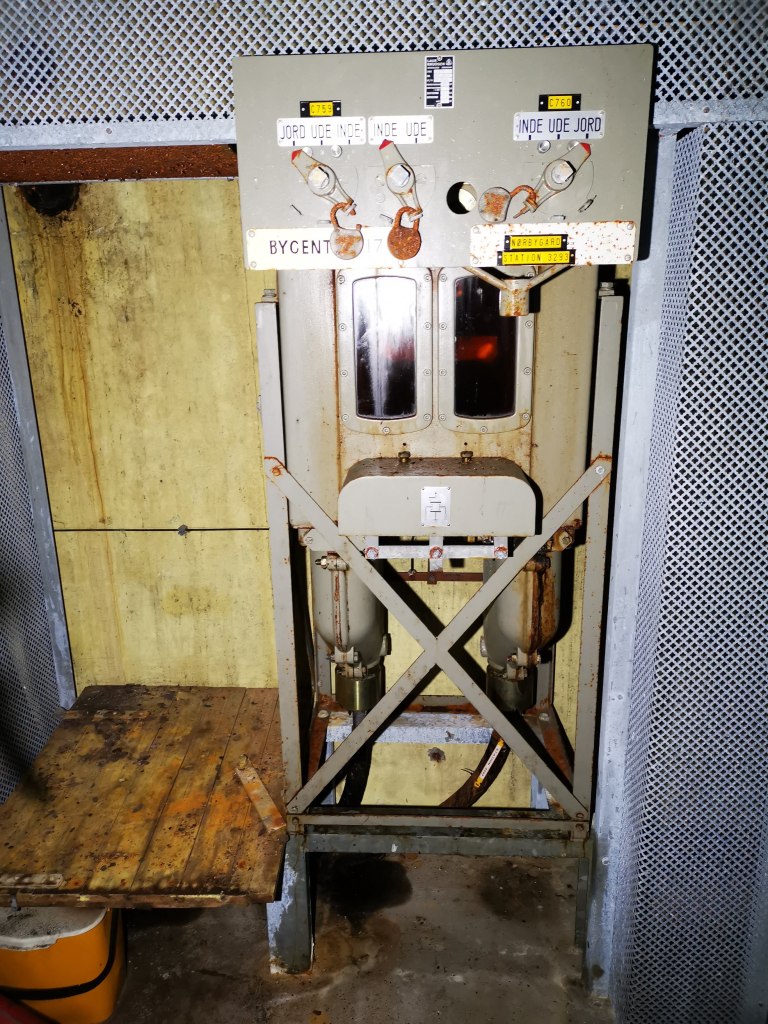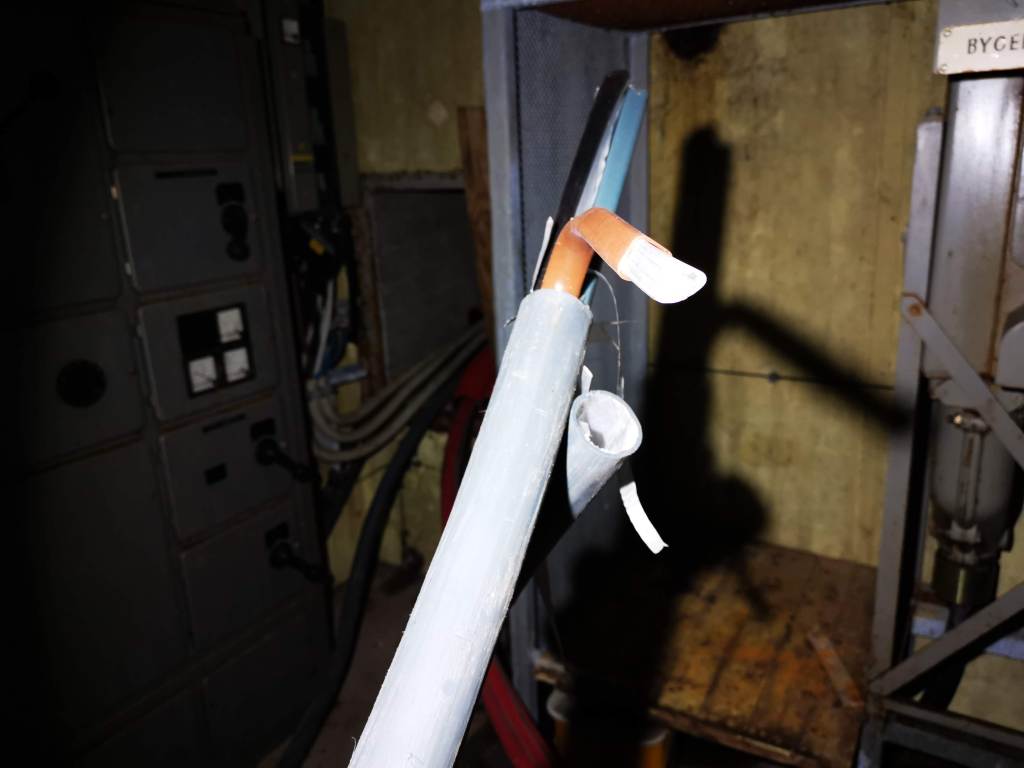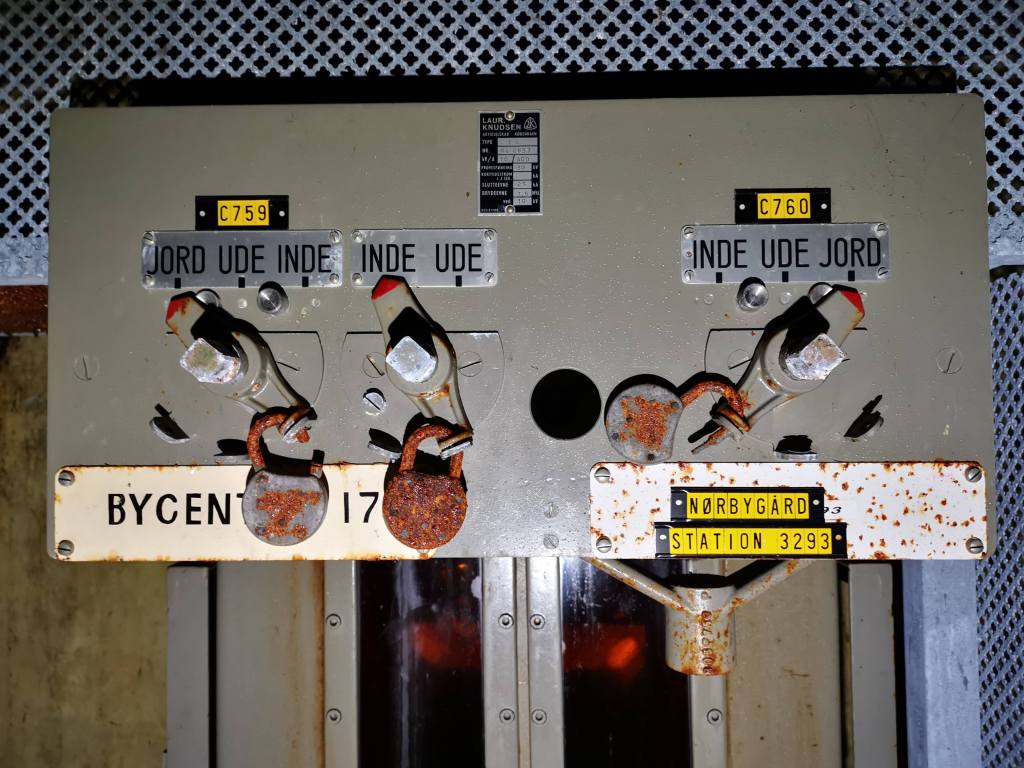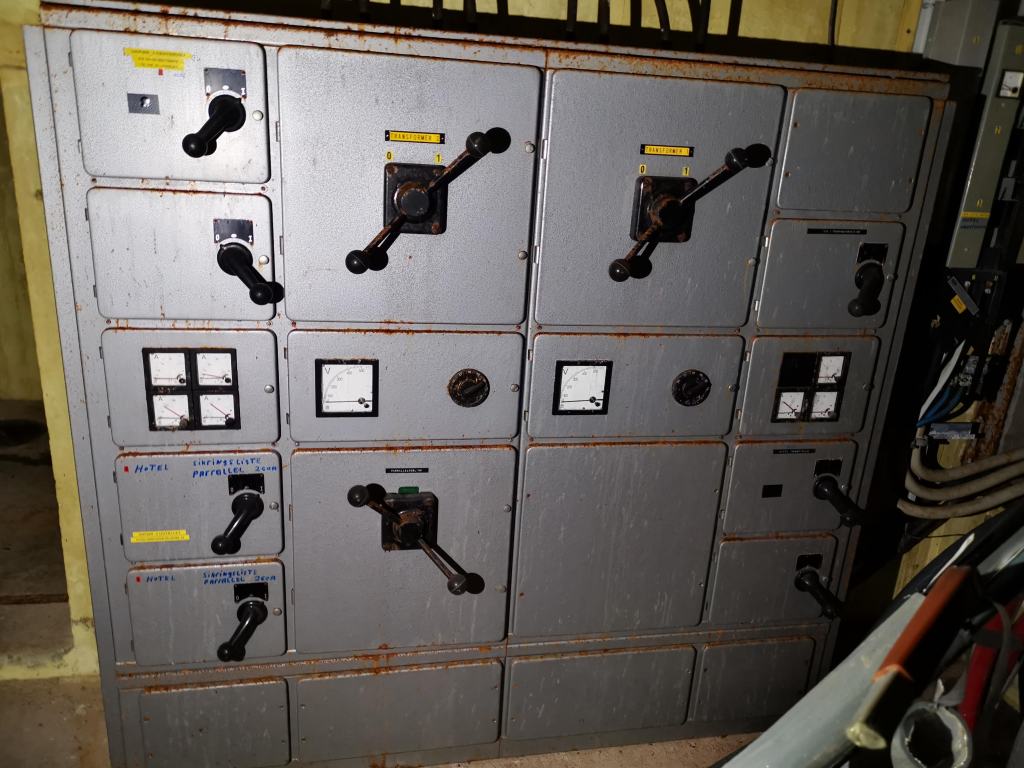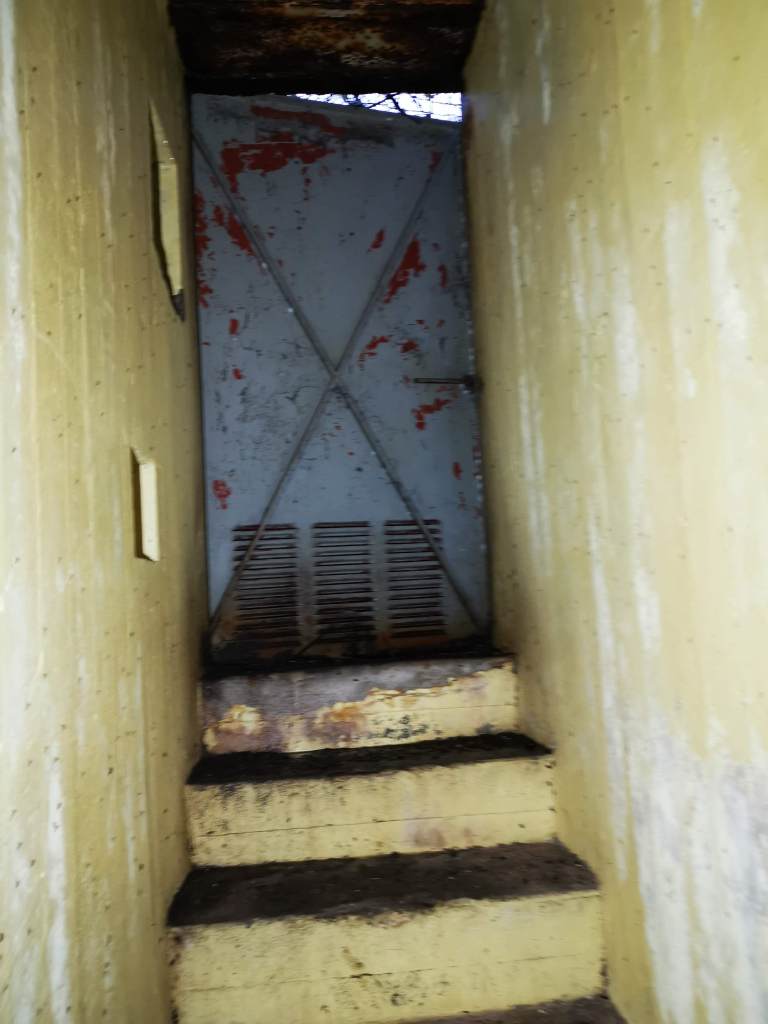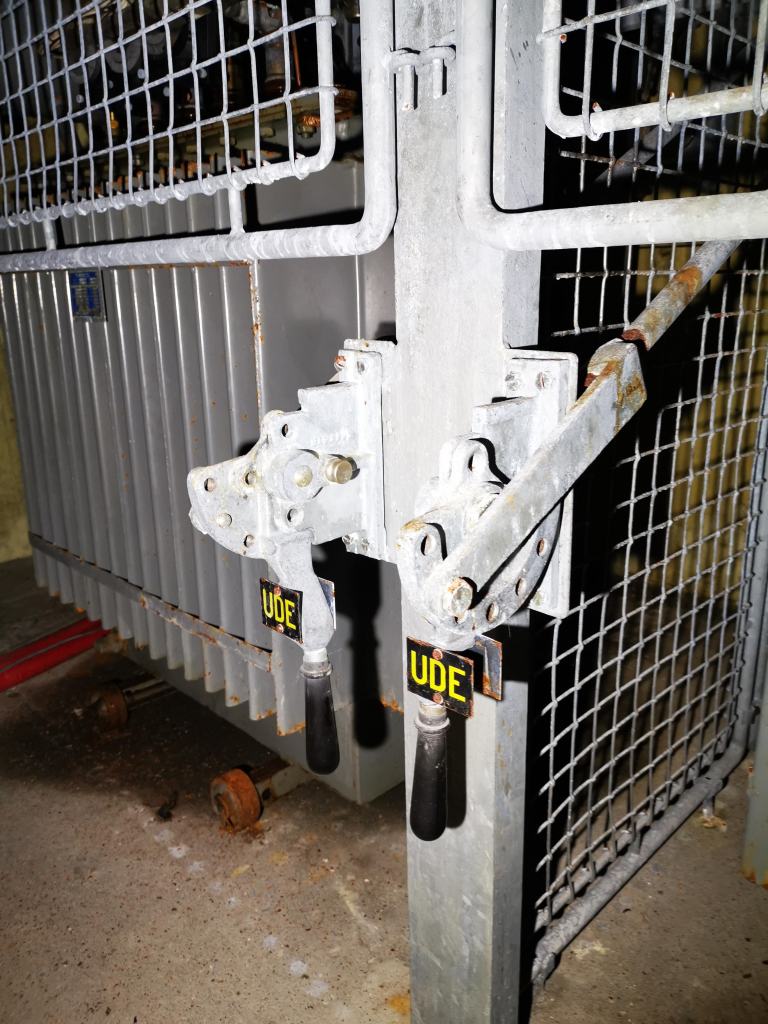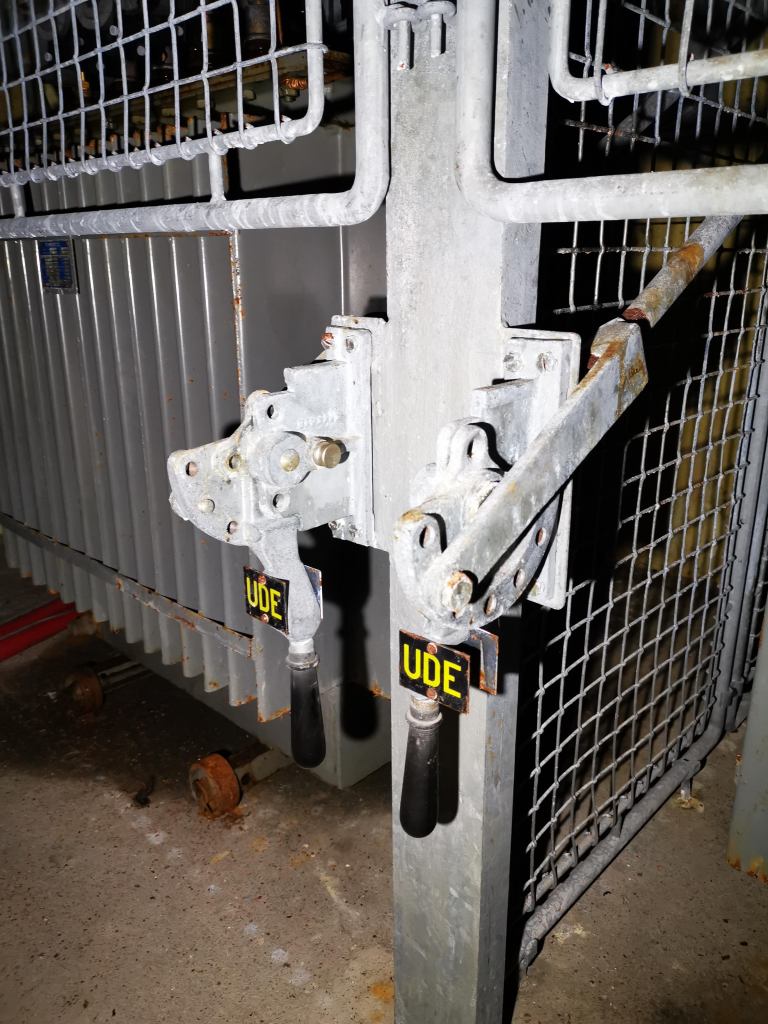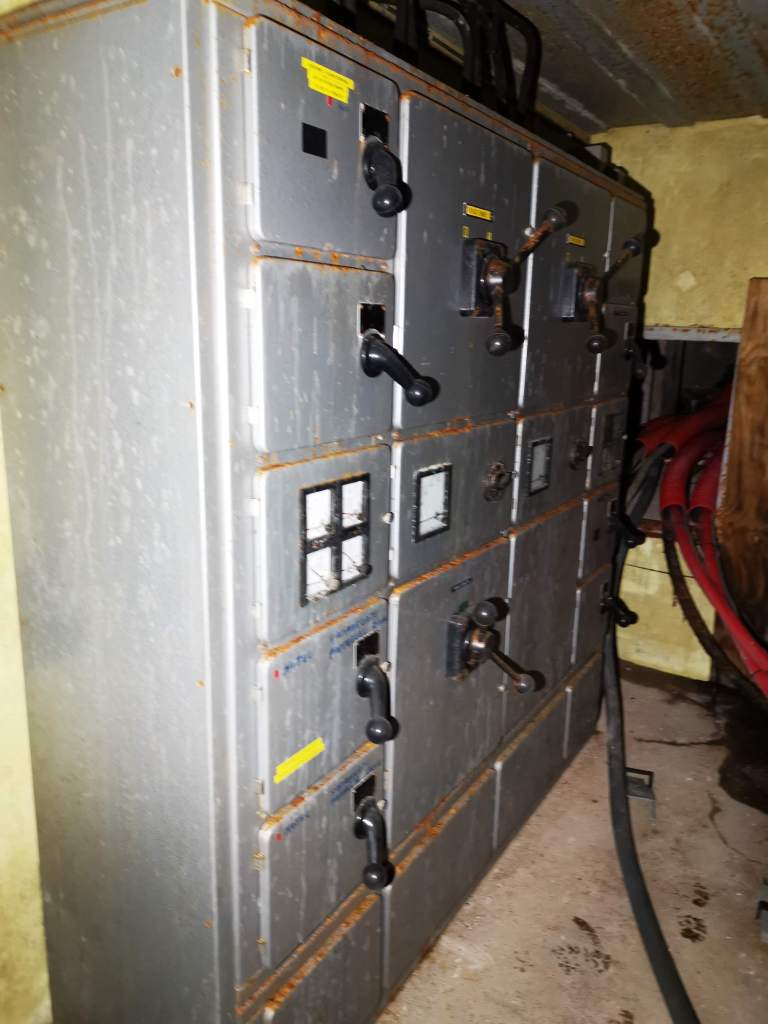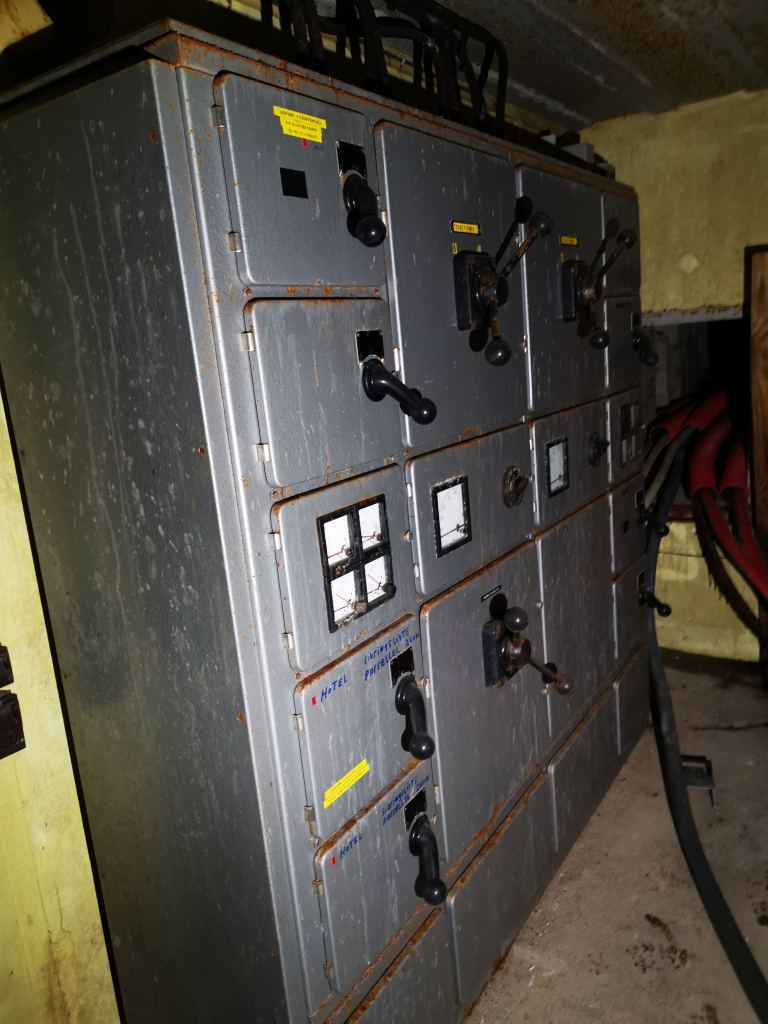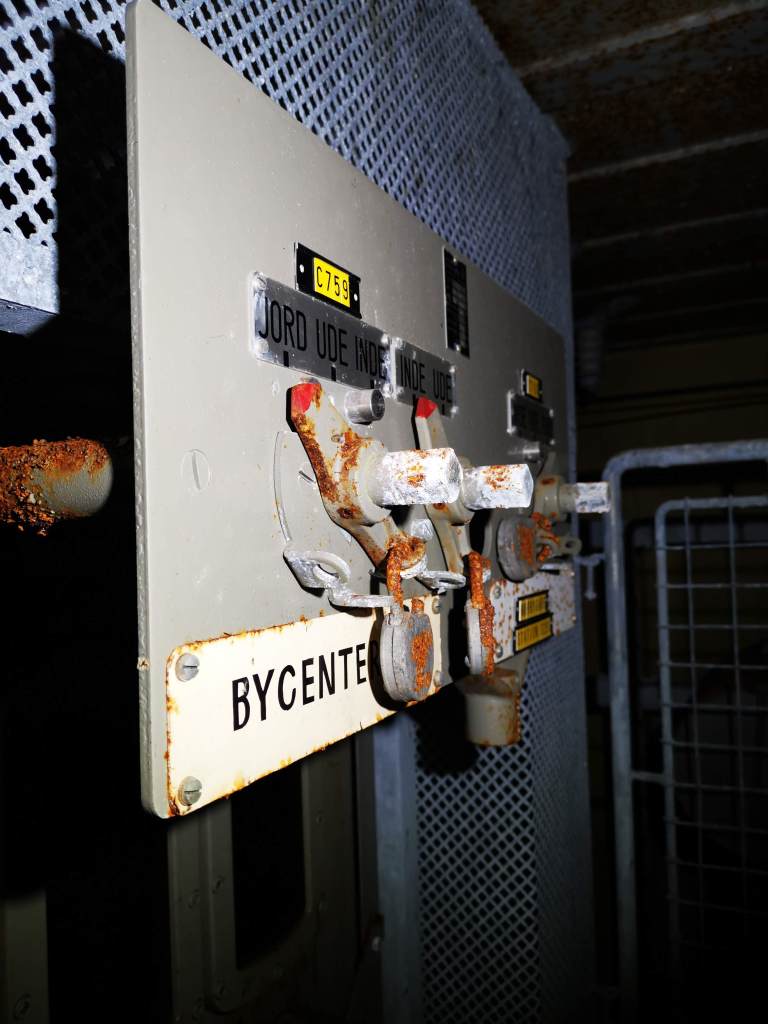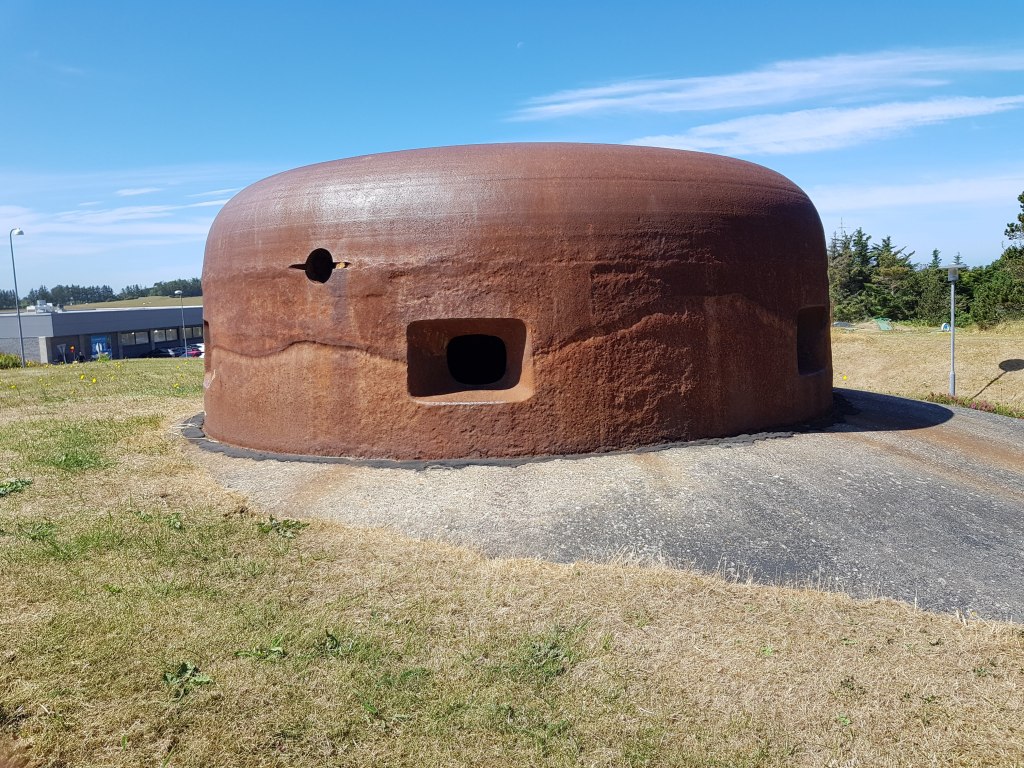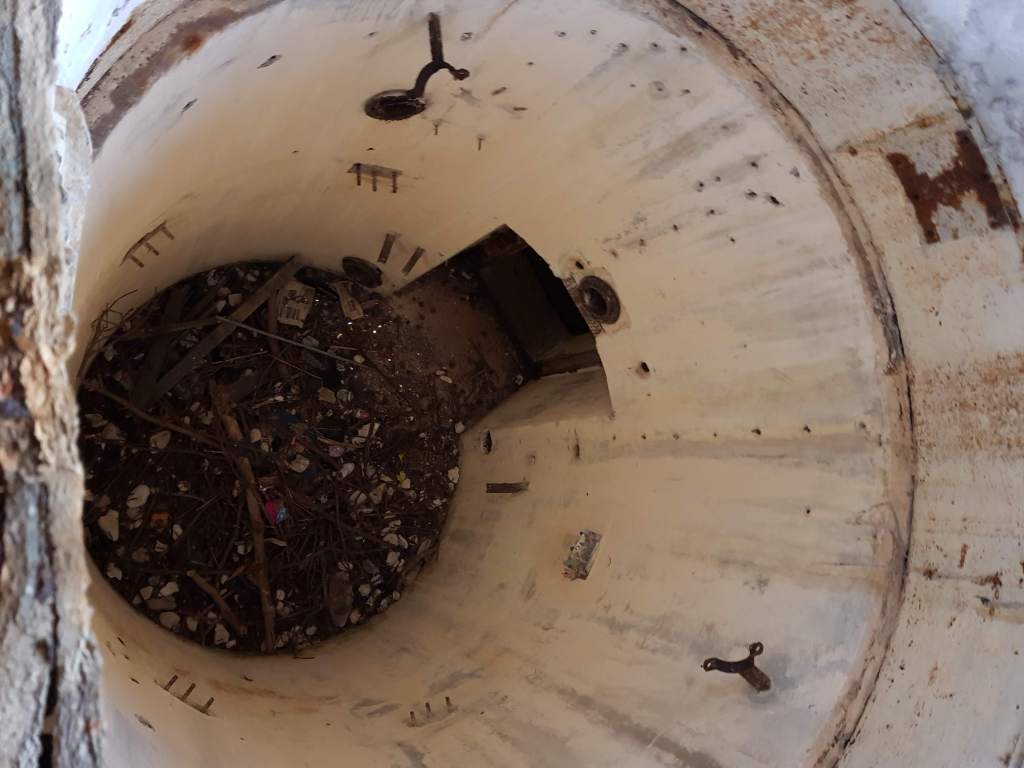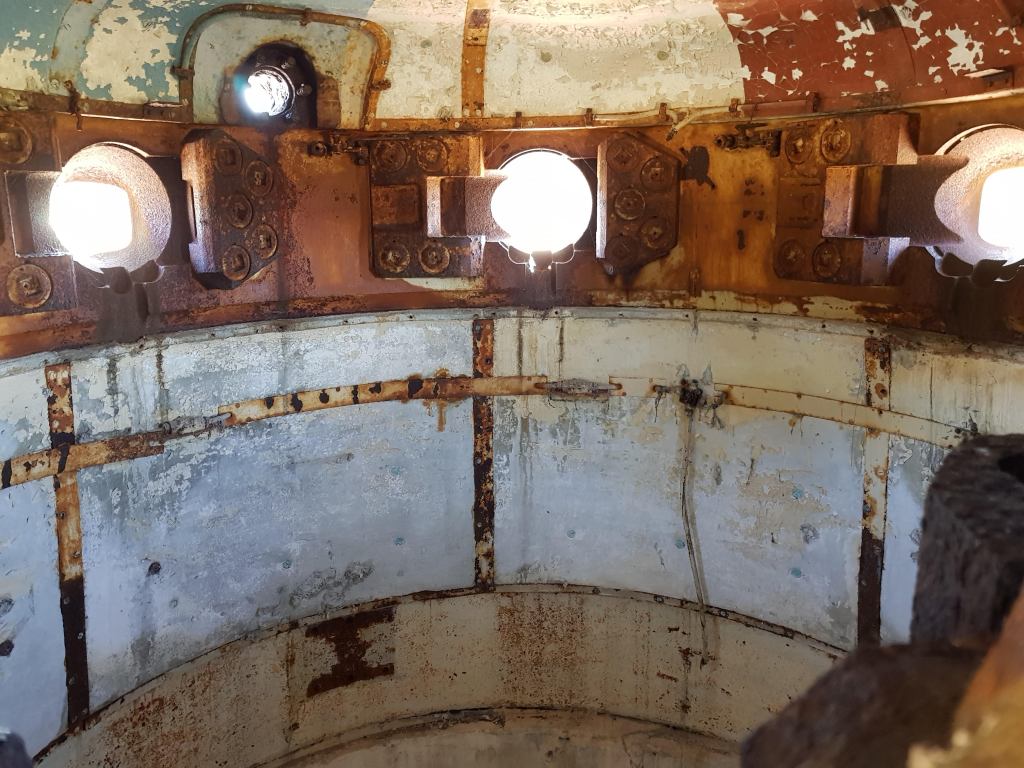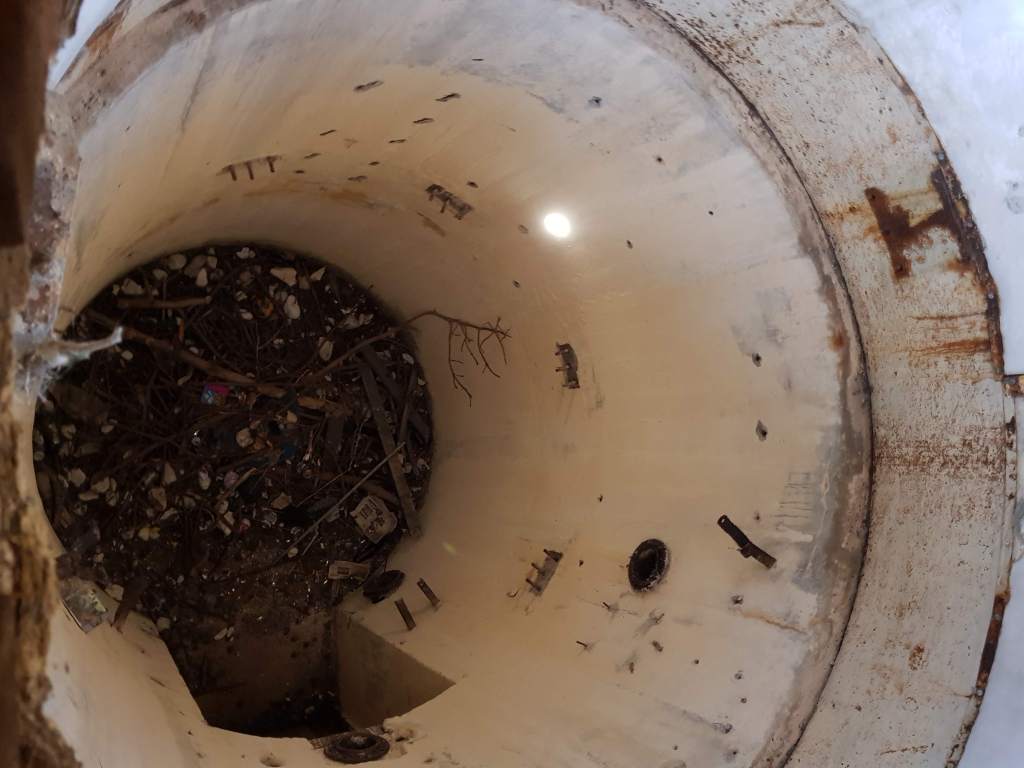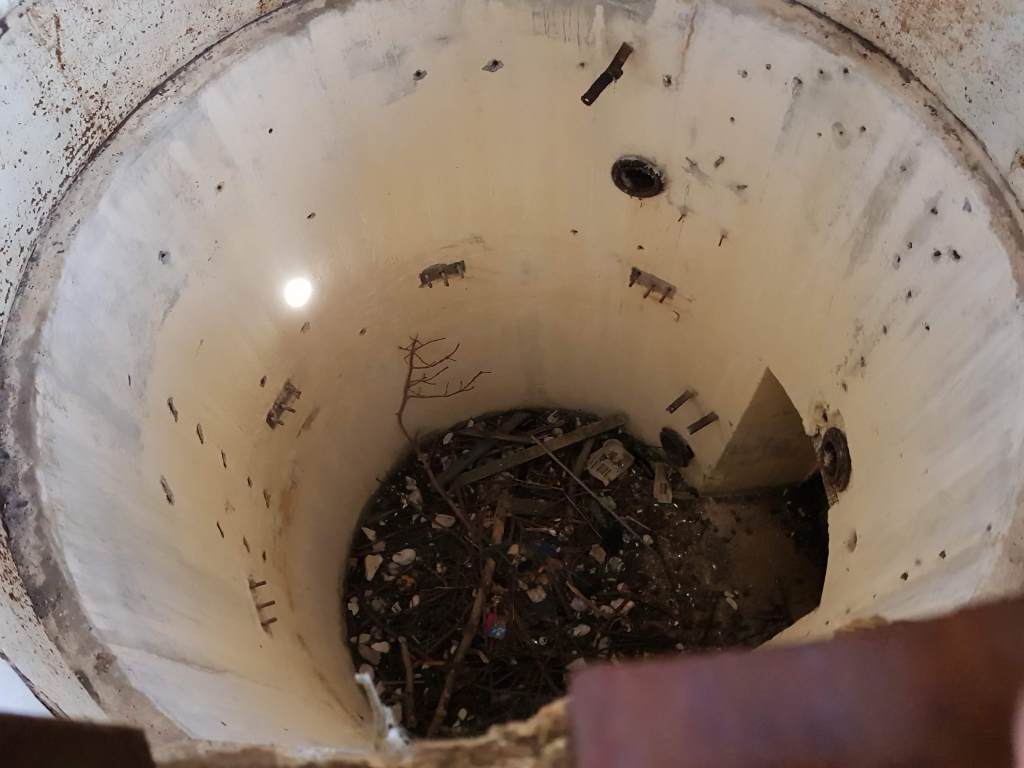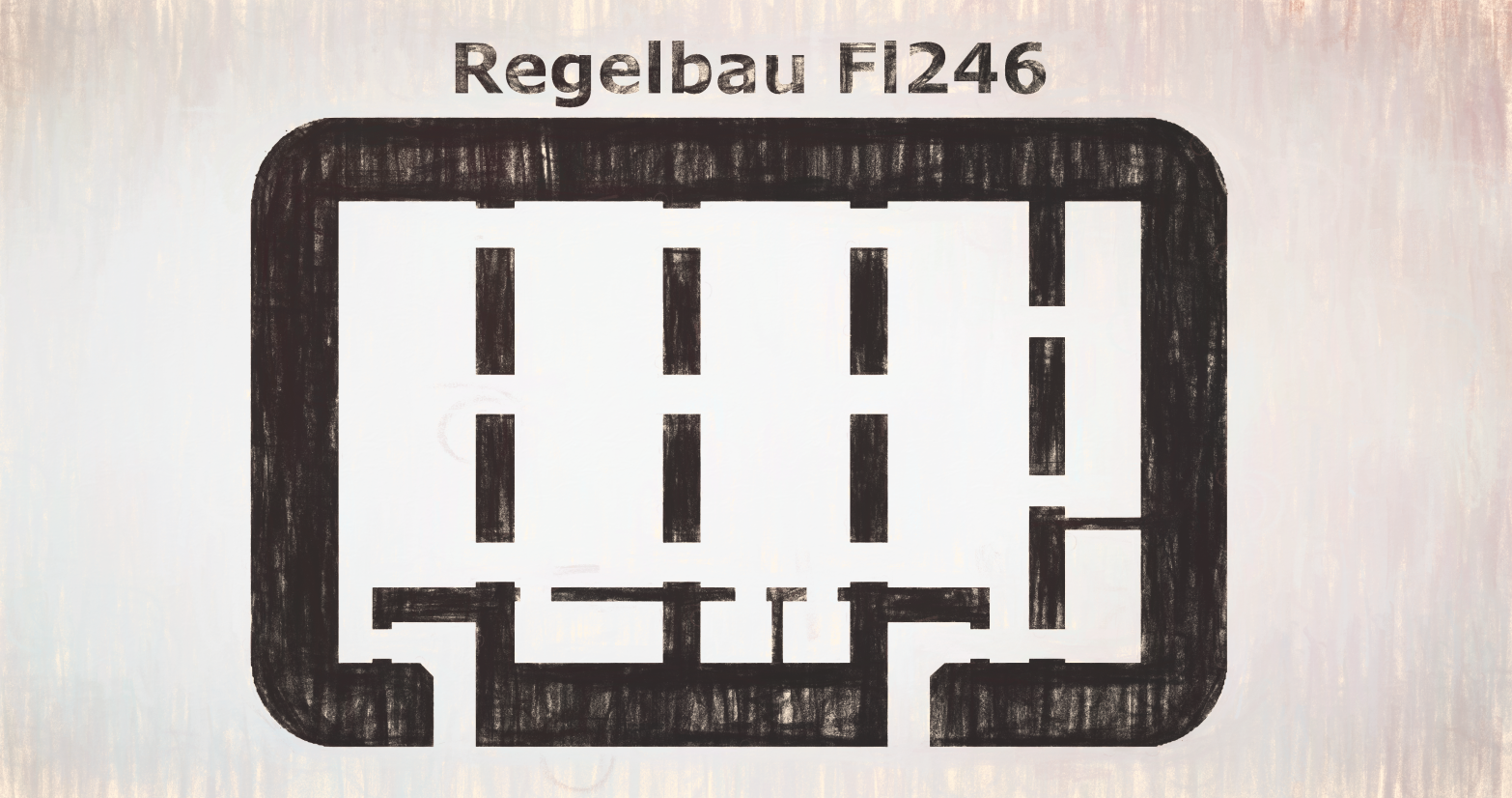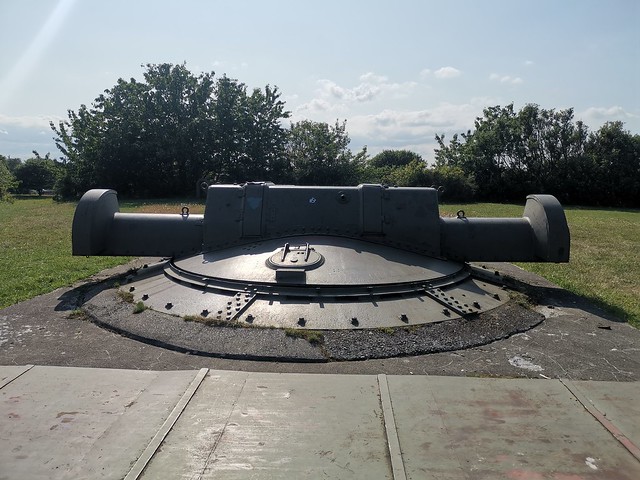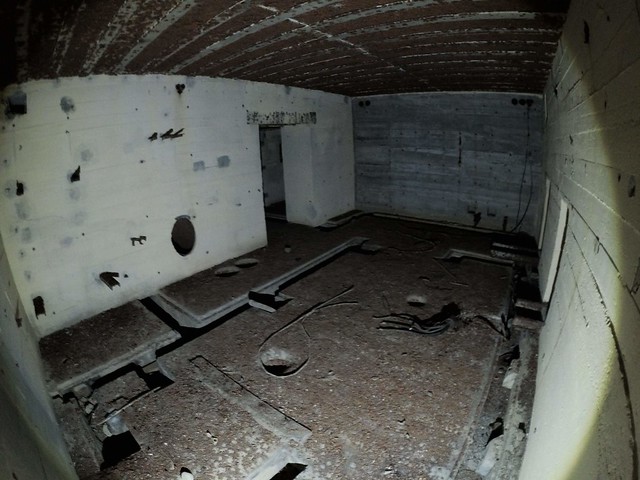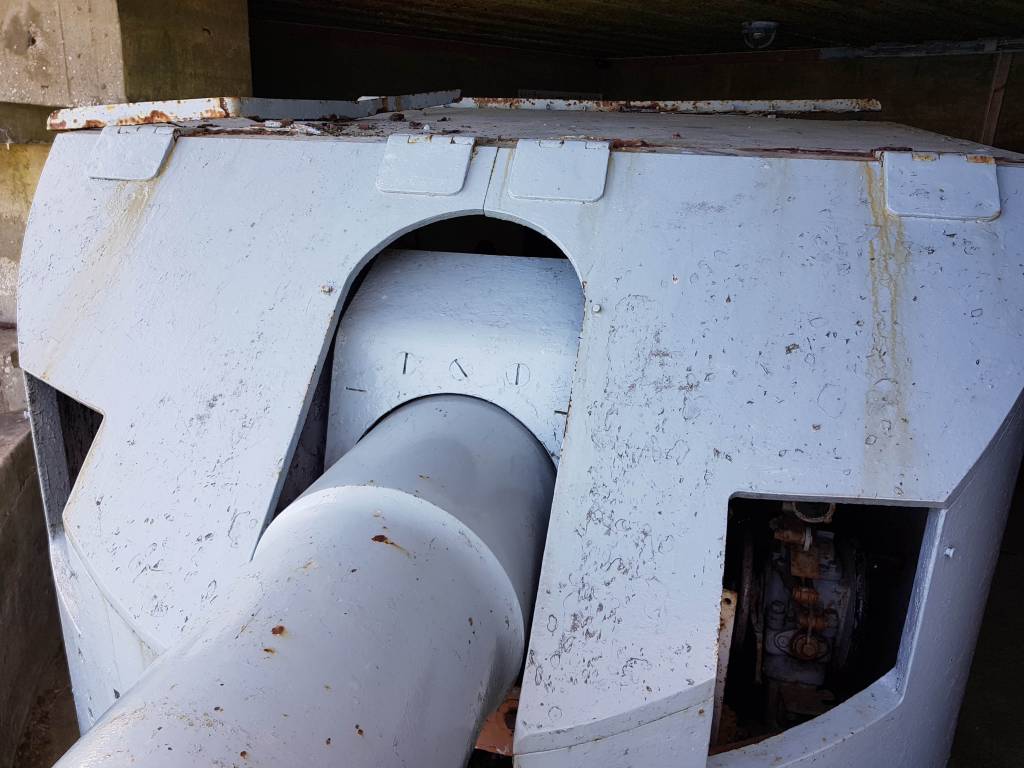Anti Aircraft Battery for heavy Anti Aircraft guns. Four modern 8,8cm 10,5cm SK/C 32 stood in Regelbau bunkers from the Regelbau FL243 (FL249 is a mirror image of the FL243). with open gun emplacements. The four 8,8cm 10,5cm SK/C 32 could fire 10 rounds a minute and with their dome like plate they sealed of the top of the circular gun position. A fan sucked out the fumes in the back of the gun emplacement after firing the gun. The reach of this gun was about 15,5 kilometres and it was used both as anti aircraft and boat targeting gun. #AtlanticWall #AtlantikWall #Bunker
Atlantic Wall Regelbau L485 – Mammut Radar Bunker Early Warning Radar – DJI Mavic Mini
The FuMG 41/42 Mammut was a long-range, phased array, early warning radar built by Germany in the latter days of World War II. Developed by the GEMA company, it consisted of six or eight Freya antenna arrays, switched together and coupled to two Freya devices. The arrays were fixed and the beam could be electronically steered on a 100° arc in front and behind the antenna, leaving 80° blind arcs on each side. It was the world’s first phased array radar and was able to detect targets flying at an altitude of 8,000m at a range of 300km.
The British intelligence codename, “hoarding”, was probably related to the shape of the large array. As late in the war as April 20th, 1945, intelligence reports reflected the erroneous opinion that only development prototypes existed but no operational stations had been fielded
Atlantic Wall Regelbau M184 – Bunker Fitted with Turret for the Cannibalized Battlecruiser Gneisenau
History of the Naval Turret Surplus naval mountings were used to reinforce German coast defenses from Norway to the French Atlantic coast. These included guns from incomplete or disarmed ships like the aircraft carrier Graf Zeppelin or the battleship Gneisenau. For example, three or four of the Graf Zeppelin’s Dopp MPL C/36 mounts equipped both batteries of Naval Artillery Battalion (Marine-Artillerie-Abteilung) 517 at Cap Romanov near Petsamo, Finland while two of the Gneisenau’s Drh. LC/34 mounts were emplaced on the west coast of Denmark at Esbjerg where they equipped Batterie Gneisenau of Naval Artillery Battalion 518. All told, a total of 111 SK C/28 guns were employed on coast defense duties in a variety of mounts, 12 in Denmark.
History of the German battleship Gneisenau Gneisenau was a German capital ship, alternatively described as a battleship and battlecruiser, of Nazi Germany’s Kriegsmarine. She was the second vessel of her class, which included one other ship, Scharnhorst. The ship was built at the Deutsche Werke dockyard in Kiel; she was laid down on 6 May 1935 and launched on 8 December 1936. Completed in May 1938, the ship was armed with a main battery of nine 28 cm (11 in) C/34 guns in three triple turrets, though there were plans to replace these weapons with six 38 cm (15 in) SK C/34 guns in twin turrets.
Gneisenau and Scharnhorst operated together for much of the early portion of World War II, including sorties into the Atlantic to raid British merchant shipping. During their first operation, the two ships sank the British auxiliary cruiser HMS Rawalpindi in a short battle. Gneisenau and Scharnhorst participated in Operation Weserübung, the German invasion of Norway. During operations off Norway, the two ships engaged the battlecruiser HMS Renown and sank the aircraft carrier HMS Glorious. Gneisenau was damaged in the action with Renown and later torpedoed by a British submarine, HMS Clyde, off Norway. After a successful raid in the Atlantic in 1941, Gneisenau and her sister put in at Brest, France. The two battleships were the subject of repeated bombing raids by the RAF; Gneisenau was hit several times during the raids, though she was ultimately repaired.
In early 1942, the two ships made a daylight dash up the English Channel from occupied France to Germany. After reaching Kiel in early February, the ship went into drydock. On the night of 26 February, the British launched an air attack on the ship; one bomb penetrated her armored deck and exploded in the forward ammunition magazine, causing serious damage and many casualties. The repairs necessitated by the damage were so time-consuming that it was determined to rebuild the ship to accommodate the 38 cm guns as originally intended. The 28 cm guns were removed and used as shore batteries. In 1943, Hitler ordered the cessation of conversion work, and on 27 March 1945, she was sunk as a blockship in Gotenhafen (Gdynia) in German-occupied Poland. She was eventually broken up for scrap in 1951.
Atlantic Wall Regelbau L487 Bertha – Night Fighter Bunker for Luftwaffe 1945
Bunker L487 is a ww2 German bunker for radio measurement device evaluation for night fighter control “Bertha” in English.
The Bunker L487 communications is 22.10 meters long, 22.90 meters wide and 8.60 meters high and has two floors.
The night fighter (also known as all-weather fighter or all-weather interceptor for a period of time after World War II) is a fighter aircraft adapted for use at night or in other times of bad visibility. Night fighters began to be used in World War I and included types that were specifically modified to operate at night.
During World War II, night fighters were either purpose-built night fighter designs, or more commonly, heavy fighters or light bombers adapted for the mission, often employing radar or other systems for providing some sort of detection capability in low visibility. Many WW II night fighters also included instrument landing systems for landing at night, as turning on the runway lights made runways into an easy target for opposing intruders. Some experiments tested the use of day fighters on night missions, but these tended to work only under very favorable circumstances and were not widely successful.
Avionics systems were greatly miniaturized over time, allowing the addition of radar altimeter, terrain-following radar, improved instrument landing system, microwave landing system, Doppler weather radar, LORAN receivers, GEE, TACAN, inertial navigation system, GPS, and GNSS in aircraft. The addition of greatly improved landing and navigation equipment combined with radar led to the use of the term all-weather fighter or all-weather fighter attack, depending on the aircraft capabilities. The use of the term night fighter gradually faded away as a result of these improvements making the vast majority of fighters capable of night operation.




























































































































































































































































































































































































































Atlantikwall Regelbau M184 – Bunker With Emplacement for Battlecruiser Turret from Gneisenau
Atlantic Wall Regelbau 639 – Sanitary Bunker, Hospital Bunker, Medical Bunker From World War 2
The Atlantic Wall, this bunker is from second world war of type Regelbau 639, it’s a Large dressing station ( Medical Bunker ) also known as big Hospital Bunker, it’s German standard design for Sanitary Bunkers
#Sanitary #Hospital #Medical



















































































. 
































Atlantic Wall Regelbau M184 – Bunker With Emplacement for Battlecruiser Turret from Gneisenau
Glow In The Dark Paint inside Hospital Bunker From World War 2
this bunker is from second world war of type Atlantic Wall Regelbau 639, it’s a Large dressing station (Medical) also known as big Hospital Bunker, it’s German standard design for Sanitary Bunkers. luminous painting still glows in the dark – after so many years a somewhat eerie sight.
Atlantic Wall Regelbau M270 Artillery Casemate, Bunker with Embrasured emplacement for 17cm gun.
The Atlantic Wall Regelbau M270 Bunker is a relatively large gun embrasure with ammunition storage rooms and a basement chamber for collection of used shells. Plan the base of our bunker of the M270 naval artillery for seul canon. Protected shooting position 120 °.
The Regelbau 270 is a relatively frequency standardized construction in the Atlantic Wall battery positions. This bunker Type was designed by the Heere for ‘The army’. This bunker Type is part of the Regelbau program in the second world war. 360 camera using insta360 ONE R Twin Edition transforms on the fly from a 360 cam to a 4K 60fps wide-angle shooter. You’ll always have the right tool to capture the action #Atlantikwall #Regelbau #Bunker
Atlantic Wall Regelbau 634 – Combat bunker with 6 Embrasure Armoured Copula Iron Turret
Armoured copula with six embrasures for machine guns. The sides of the copula are 25 cm thick. The muzzle of the machine gun was mounted in a ball head which fitted exactly into the embrasures. When the embrasures were not in use, they could be closed with heavy shutters. The hole in the top of the copula was for a periscope for surveying the terrain around the bunker. The copula is part of a type Regelbau 634 bunker.
The copula is 25 cm thick, whereas the walls and ceiling are 2 m thick and offered the soldiers good protection against bombardment. In the bunker was an ammunition room and bunks for the crew of nine soldiers. In the Iron tower there was a shooter and a helper to operate the MG 34 machine gun, which was mounted on a special foot (M.G.-Schartenlafette 34 Ks) and with the round armor attachment locked so that there were armor in the shooting cut, In the middle of the tower was a periscope so that it could be observed in all directions. mounted in a special condition, so that there were armor in the shooting cut. This bunker Type was designed by the Heere for ‘The army’. This bunker Type is part of the Regelbau program in the second world war. #bunker #Atlantikwall #Regelbau
Atlantic Wall Regelbau 634 – Battle bunker with 6 Embrasure Reinforced Iron Tower
Armoured copula with six embrasures for machine guns. The sides of the copula are 25 cm thick. The muzzle of the machine gun was mounted in a ball head which fitted exactly into the embrasures. When the embrasures were not in use, they could be closed with heavy shutters. The hole in the top of the copula was for a periscope for surveying the terrain around the bunker.
The copula is part of a type Regelbau 634 bunker. The copula is 25 cm thick, whereas the walls and ceiling are 2 m thick and offered the soldiers good protection against bombardment. In the bunker was an ammunition room and bunks for the crew of nine soldiers. In the Iron tower there was a shooter and a helper to operate the MG 34 machine gun, which was mounted on a special foot (M.G.-Schartenlafette 34 Ks) and with the round armor attachment locked so that there were armor in the shooting cut, In the middle of the tower was a periscope so that it could be observed in all directions. mounted in a special condition, so that there were armor in the shooting cut. This bunker Type was designed by the Heere for ‘The army’. This bunker Type is part of the Regelbau program in the second world war. #bunker #Atlantikwall #Regelbau
Atlantic Wall Regelbau Fl246 – Ammunition depot for heavy Flak Battery – Insta360 ONE R Twin Edition
more info about this bunker
after the Second World War this bunker was blown up.
This bunker Type was designed by the Kriegsmarine for ‘German Navy’.
This bunker Type is part of the Regelbau program in the second world war.
how is a #Regelbau Before and during World War II, the Wehrmacht built several standardised bunkers and weapon positions in Germany and German-occupied countries. These buildings were called Regelbau, i.e. standardised buildings.
The Regelbau (German for “standard design”) were a series of standardised #bunker designs built in large numbers by the Germans in the Siegfried Line (German: Westwall) and the Atlantic Wall as part of their defensive fortifications prior to and during the Second World War.
Following the occupation of German territories west of the Rhine, fortress engineers began the construction of the Siegfried Line in 1936. In doing so they were able to benefit from their earlier experience of bunker construction. In compliance with the Versailles Treaty, they had already built the Wetterau-Main-Tauber position and Neckar-Enz position before 1936. When, in 1936, construction started on the Siegfried Line itself, they were able at the outset to utilize designs from the two earlier fortifications. From these existing plans, fortress pioneers rapidly developed improved bunkers that were built from 1937. This building phase was named the Engineer Construction Programme and was characterized by bunkers built to B1 standard thicknesses (see above). Since the thickness of these structures was soon considered to be too weak and because there was a large number Regelbau designs (and hence confusion), new types were developed and implemented from 1938. These new designs were achieved largely by simplifying and reducing the number of Regelbau types. This new building phase was called the Limes Programme.
Development of Regelbau designs from 1936 to 1940 The fortress engineers were no longer in charge of construction; instead Organization Todt (OT) took over, promising Hitler it would deliver the number of structures he wanted. Plans for the Limes Programme did not envisage the inclusion of the cities of Aachen and Saarbrücken and they therefore ended up in front of the planned line of fortifications. That changed in 1939 with the Aachen-Saar Programme. From 1939, yet more new Regelbau bunkers were designed for the construction programme that saw increases in the construction thicknesses. From then on, only bunkers that met the in “B new” and “A” standards were to be built. With the outbreak of the Second World War on 1 September 1939, priorities for the construction of the Siegfried Line changed. The renewed shortage of raw materials led to the development of a new series of Regelbau designs, the so-called wartime standard designs or Kriegsregelbauten. After the “lavish” Regelbauten of the Aachen-Saar Programme, the final construction phase was dominated by massive financial constraints. For example, observation cupolas and flank firing positions were no longer provided and the rooms were smaller.
Atlantic Wall Regelbau S174 – Ammunition depot Bunker for 38cm 40,6cm battery
This bunker Type was designed by the Luftwaffe for ‘German Air Force’. This bunker Type is part of the Regelbau program in the second world war.
how is a Regelbau Before and during World War II, the Wehrmacht built several standardised bunkers and weapon positions in Germany and German-occupied countries. These buildings were called Regelbau, i.e. standardised buildings.
The Regelbau (German for “standard design”) were a series of standardised #bunker designs built in large numbers by the Germans in the Siegfried Line (German: Westwall) and the Atlantic Wall as part of their defensive fortifications prior to and during the Second World War.
This Regelbau S174 is a Ammunition depot Bunker for 38/40,6cm battery also known as Ammunition Bunker (Unterstände für Munition). This bunker Type was designed by the Luftwaffe for ‘German Air Force’. This bunker Type is part of the Regelbau program in the second world war. how is a #Regelbau Before and during World War II, the Wehrmacht built several standardised #bunkers and weapon positions in Germany and German-occupied countries. These buildings were called Regelbau, i.e. standardised buildings. The Regelbau (German for “standard design”) were a series of standardised #bunker designs built in large numbers by the Germans in the Siegfried Line (German: Westwall) and the Atlantic Wall as part of their defensive fortifications prior to and during the Second World War. Following the occupation of German territories west of the Rhine, fortress engineers began the construction of the Siegfried Line in 1936. In doing so they were able to benefit from their earlier experience of bunker construction. In compliance with the Versailles Treaty, they had already built the Wetterau-Main-Tauber position and Neckar-Enz position before 1936. When, in 1936, construction started on the Siegfried Line itself, they were able at the outset to utilize designs from the two earlier fortifications. From these existing plans, fortress pioneers rapidly developed improved bunkers that were built from 1937. This building phase was named the Engineer Construction Programme and was characterized by bunkers built to B1 standard thicknesses (see above). Since the thickness of these structures was soon considered to be too weak and because there was a large number Regelbau designs (and hence confusion), new types were developed and implemented from 1938. These new designs were achieved largely by simplifying and reducing the number of Regelbau types. This new building phase was called the Limes Programme.
Development of Regelbau designs from 1936 to 1940 The fortress engineers were no longer in charge of construction; instead Organization Todt (OT) took over, promising Hitler it would deliver the number of structures he wanted. Plans for the Limes Programme did not envisage the inclusion of the cities of Aachen and Saarbrücken and they therefore ended up in front of the planned line of fortifications. That changed in 1939 with the Aachen-Saar Programme. From 1939, yet more new Regelbau bunkers were designed for the construction programme that saw increases in the construction thicknesses. From then on, only bunkers that met the in “B new” and “A” standards were to be built. With the outbreak of the Second World War on 1 September 1939, priorities for the construction of the Siegfried Line changed. The renewed shortage of raw materials led to the development of a new series of Regelbau designs, the so-called wartime standard designs or Kriegsregelbauten. After the “lavish” Regelbauten of the Aachen-Saar Programme, the final construction phase was dominated by massive financial constraints. For example, observation cupolas and flank firing positions were no longer provided and the rooms were smaller.
Expansion of construction projects from 1941 to 1944 In 1940 work was ordered on a number of construction projects in Western Europe. Amongst the first were the Dover Strait guns begun in July 1940 and included Todt Battery. Building began in February 1941 on the Saint-Nazaire submarine base Following the first effective commando raid in March 1941 Operation Claymore and with the planning of Operation Barbarossa, Hitler decided in June 1941 to strengthen the west against possible attacks. The Channel Islands were chosen to become major fortifications, followed in 1942 with the order to build the Atlantic Wall.
A mass of equipment was needed, cement, sand, gravel and steel to construct the concrete fortifications, weapons and armour plate for defence and hundreds of thousands of workers. To offset shortages, equipment from French and other occupied armies were incorporated in the defences, casemates designed for non-german artillery, anti tank and machine guns and the use of turrets from obsolete tanks in tobrukstand pill boxes (tobruk pits).
The labour came from an expansion of the Organisation Todt, who contracted with building construction companies from Germany and occupied countries to undertake the work. The OT provided them with equipment, supervisors and labour. Labour comprised skilled volunteers, engineers, designers and supervisors, who were paid and treated well, second came volunteer workers, often skilled technicians, such as carpenters, plumbers, electricians and metal workers, again these workers were paid, took holidays and were well treated. Next came unskilled forced labour, paid very little and treated quite harshly, lastly came effective slave labour, paid so little, badly fed and treated very harshly.
Atlantic Wall Regelbau 666 bunker Type is Infantry observation post
Using DJI Mavic Mini Drone – #DJIMini
This bunker Type was designed by the Luftwaffefor ‘German Air Force’.
how is a #Regelbau Before and during World War II, the Wehrmacht built several standardised bunkers and weapon positions in Germany and German-occupied countries. These buildings were called Regelbau, i.e. standardised buildings. The Regelbau (German for “standard design”) were a series of standardised #bunker designs built in large numbers by the Germans in the Siegfried Line (German: Westwall) and the Atlantic Wall as part of their defensive fortifications prior to and during the Second World War.
Following the occupation of German territories west of the Rhine, fortress engineers began the construction of the Siegfried Line in 1936. In doing so they were able to benefit from their earlier experience of bunker construction. In compliance with the Versailles Treaty, they had already built the Wetterau-Main-Tauber position and Neckar-Enz position before 1936. When, in 1936, construction started on the Siegfried Line itself, they were able at the outset to utilize designs from the two earlier fortifications. From these existing plans, fortress pioneers rapidly developed improved bunkers that were built from 1937. This building phase was named the Engineer Construction Programme and was characterized by bunkers built to B1 standard thicknesses (see above). Since the thickness of these structures was soon considered to be too weak and because there was a large number Regelbau designs (and hence confusion), new types were developed and implemented from 1938. These new designs were achieved largely by simplifying and reducing the number of Regelbau types. This new building phase was called the Limes Programme. Development of Regelbau designs from 1936 to 1940
The fortress engineers were no longer in charge of construction; instead Organization Todt (OT) took over, promising Hitler it would deliver the number of structures he wanted. Plans for the Limes Programme did not envisage the inclusion of the cities of Aachen and Saarbrücken and they therefore ended up in front of the planned line of fortifications. That changed in 1939 with the Aachen-Saar Programme. From 1939, yet more new Regelbau bunkers were designed for the construction programme that saw increases in the construction thicknesses. From then on, only bunkers that met the in “B new” and “A” standards were to be built. With the outbreak of the Second World War on 1 September 1939, priorities for the construction of the Siegfried Line changed. The renewed shortage of raw materials led to the development of a new series of Regelbau designs, the so-called wartime standard designs or Kriegsregelbauten. After the “lavish” Regelbauten of the Aachen-Saar Programme, the final construction phase was dominated by massive financial constraints. For example, observation cupolas and flank firing positions were no longer provided and the rooms were smaller.
Expansion of construction projects from 1941 to 1944 In 1940 work was ordered on a number of construction projects in Western Europe. Amongst the first were the Dover Strait guns begun in July 1940 and included Todt Battery. Building began in February 1941 on the Saint-Nazaire submarine base Following the first effective commando raid in March 1941 Operation Claymore and with the planning of Operation Barbarossa, Hitler decided in June 1941 to strengthen the west against possible attacks. The Channel Islands were chosen to become major fortifications, followed in 1942 with the order to build the Atlantic Wall.
A mass of equipment was needed, cement, sand, gravel and steel to construct the concrete fortifications, weapons and armour plate for defence and hundreds of thousands of workers. To offset shortages, equipment from French and other occupied armies were incorporated in the defences, casemates designed for non-german artillery, anti tank and machine guns and the use of turrets from obsolete tanks in tobrukstand pill boxes (tobruk pits).
The labour came from an expansion of the Organisation Todt, who contracted with building construction companies from Germany and occupied countries to undertake the work. The OT provided them with equipment, supervisors and labour. Labour comprised skilled volunteers, engineers, designers and supervisors, who were paid and treated well, second came volunteer workers, often skilled technicians, such as carpenters, plumbers, electricians and metal workers, again these workers were paid, took holidays and were well treated. Next came unskilled forced labour, paid very little and treated quite harshly, lastly came effective slave labour, paid so little, badly fed and treated very harshly.
Atlantic Wall Regelbau FL244 Fire Control Post Command bunker for heavy Flak Anti Aircraft battery
The battery is constructed according to a standard layout for this type of anti-aircraft batteries. The site still contains the fire control post of type FL244 (Fire control post for heavy Anti Aircraft battery) on the northeast side of the site and in the center of the site four gun positions of the types FL243 Emplacement for 8,8/10,5cm Anti Aircraft gun). On the south side are two ammunition bunkers of the type FL246 (Munitions Auffülrlaum für Schwere.
#Atlantikwall #bunker #Regelbau
Atlantic Wall Regelbau Fl245 Electric Generator Bunker for Anti Aircraft
This bunker contained the machines and fuel needed to keep the Anti Aircraft battery operational. There was an entrance defense in the gas lock. One wall has a thickness of 2m of reinforced concrete. #AtlanticWall #Regelbau #bunker
Atlantic Wall Regelbau M270 Artillery Casemate, Bunker with Embrasured emplacement for 17cm gun.
Plan the base of our bunker of the M270 naval artillery for seul canon. Protected shooting position 120 °. The Regelbau 270 is a relatively frequency standardized construction in the Atlantic Wall battery positions. This bunker Type was designed by the Heere for ‘The army’. This bunker Type is part of the Regelbau program in the second world war. 360 camera using insta360 ONE R Twin Edition transforms on the fly from a 360 cam to a 4K 60fps wide-angle shooter. You’ll always have the right tool to capture the action #Atlantikwall #Regelbau #Bunker
Tags:#Atlantikwall, #Regelbau, 17 cm gun, 360 camera, Artillery, Artillery Casemate, atlanticwall, Atlantik wall, Atlantikwall, Atlantikwall bunker, Atlantikwall Regelbau, Batterie, bunker, bunker 360 Camera, bunker Exploring, bunker M270, bunkers, Casemate, defense, Embrasured, Embrasured emplacement, history, insta360, Insta360 360 Camera, insta360 one r twin, insta360 twin, lostplaces, M270, Regelbau, Regelbau M270, Soviet Union, World War 2, World War 2 bunker, worldwar, worldwar2, WWII
Atlantic Wall Regelbau L487 Bertha – Night Fighter Bunker for Luftwaffe in 360°
Bunker L487 is a ww2 German bunker for radio measurement device evaluation for night fighter control “Bertha” in English.
The Bunker L487 communications is 22.10 meters long, 22.90 meters wide and 8.60 meters high and has two floors.
A night fighter (also known as all-weather fighter or all-weather interceptor for a period of time after World War II) is a fighter aircraft adapted for use at night or in other times of bad visibility. Night fighters began to be used in World War I and included types that were specifically modified to operate at night.
During World War II, night fighters were either purpose-built night fighter designs, or more commonly, heavy fighters or light bombers adapted for the mission, often employing radar or other systems for providing some sort of detection capability in low visibility. Many WW II night fighters also included instrument landing systems for landing at night, as turning on the runway lights made runways into an easy target for opposing intruders. Some experiments tested the use of day fighters on night missions, but these tended to work only under very favorable circumstances and were not widely successful.
Avionics systems were greatly miniaturized over time, allowing the addition of radar altimeter, terrain-following radar, improved instrument landing system, microwave landing system, Doppler weather radar, LORAN receivers, GEE, TACAN, inertial navigation system, GPS, and GNSS in aircraft. The addition of greatly improved landing and navigation equipment combined with radar led to the use of the term all-weather fighter or all-weather fighter attack, depending on the aircraft capabilities. The use of the term night fighter gradually faded away as a result of these improvements making the vast majority of fighters capable of night operation.












